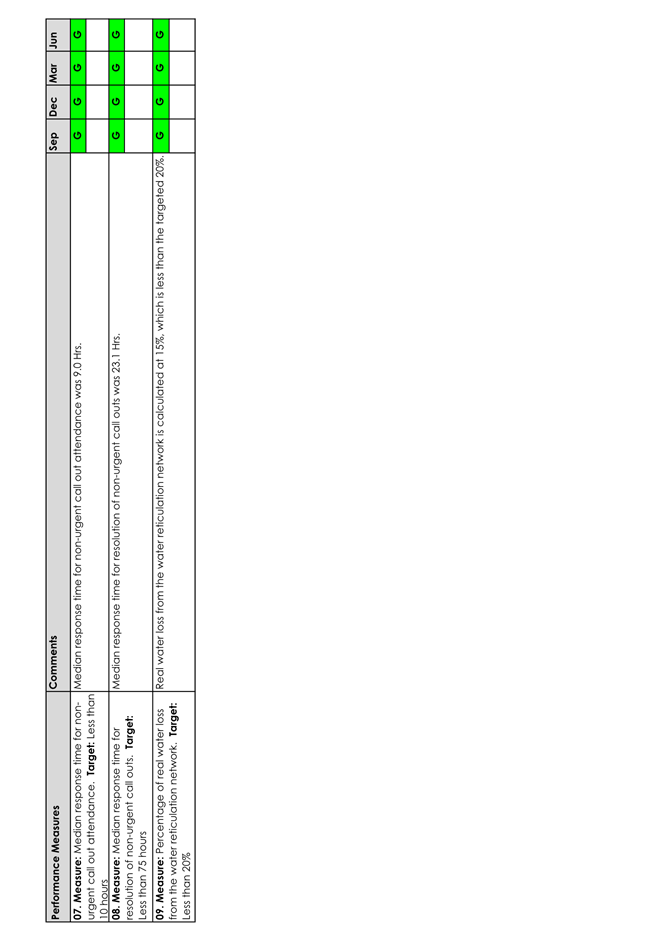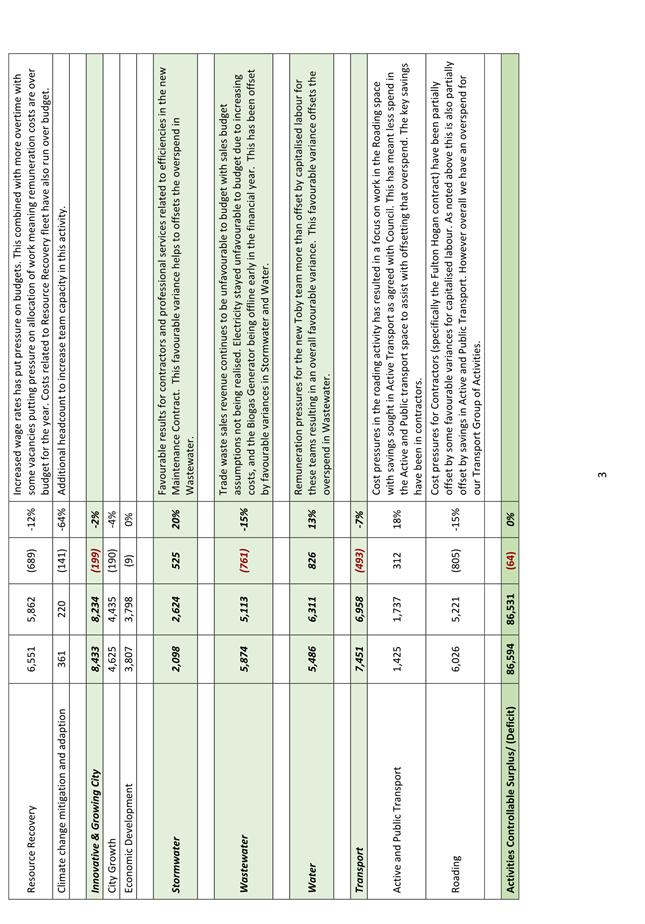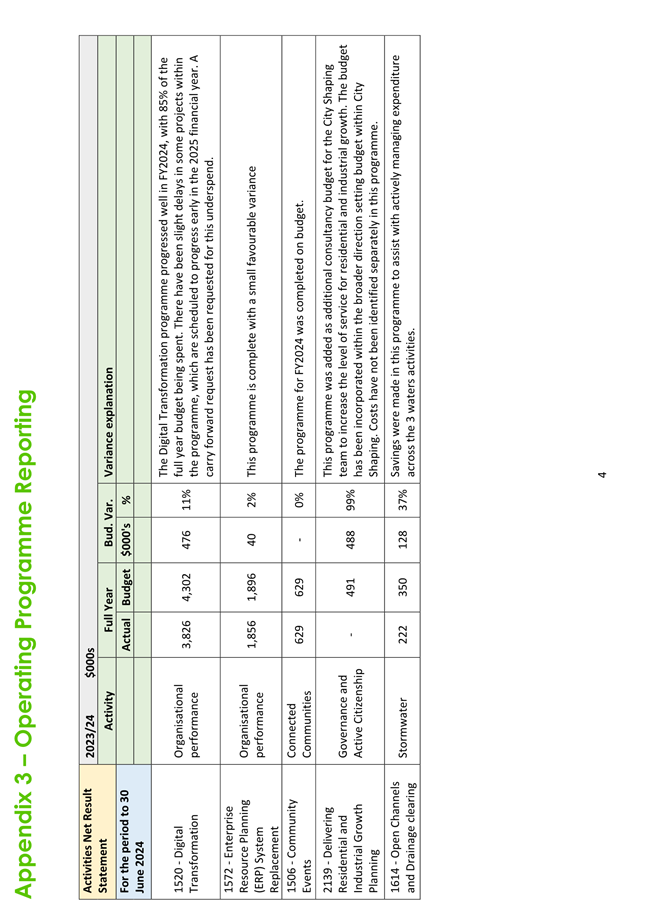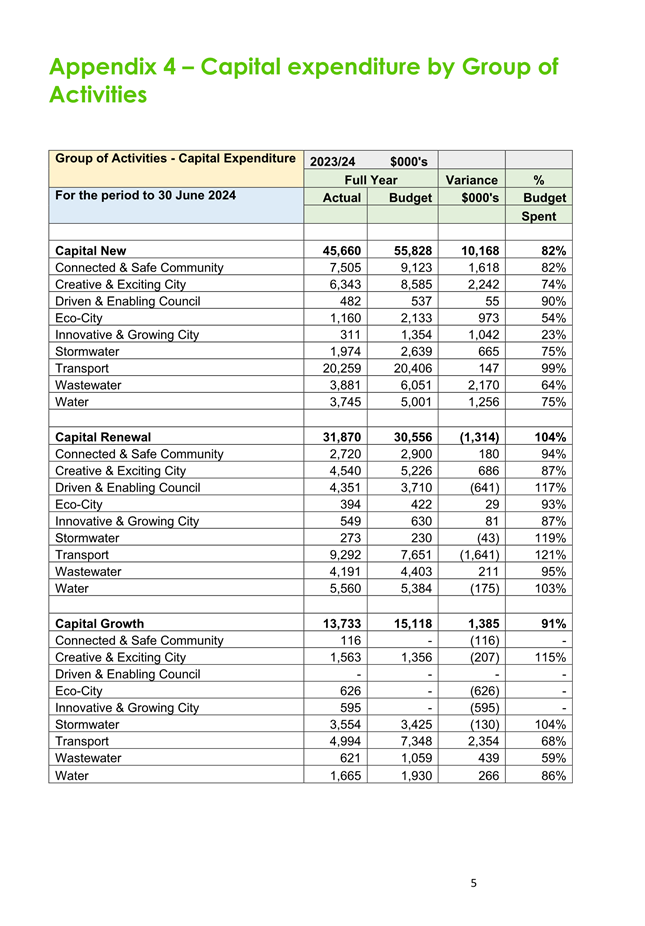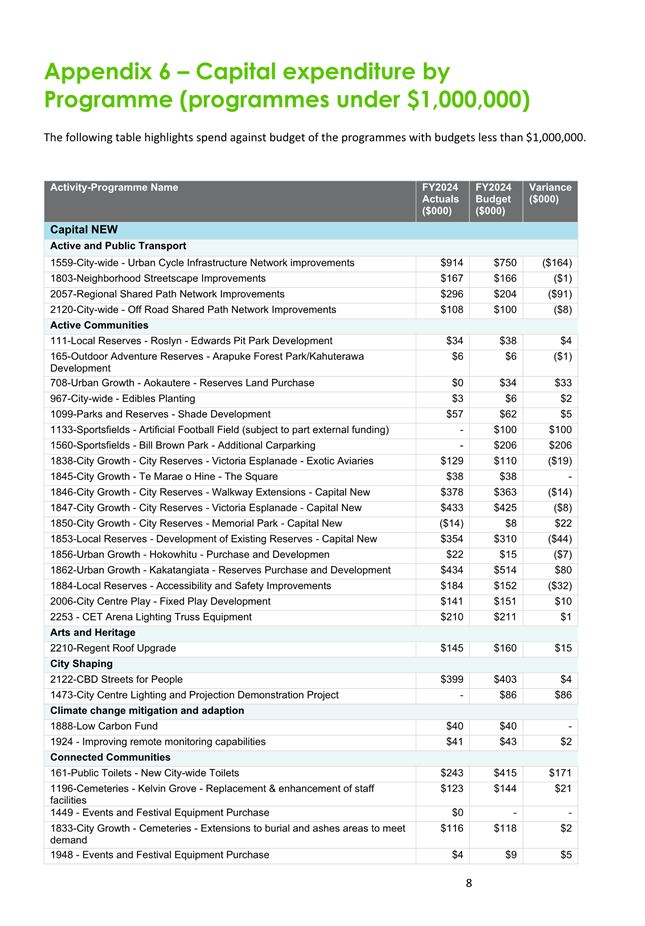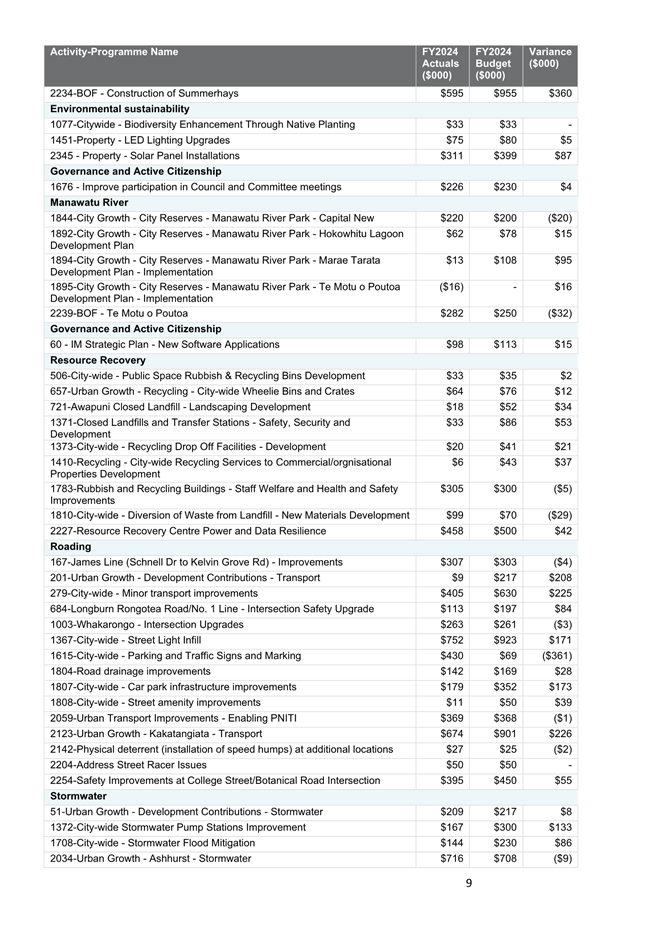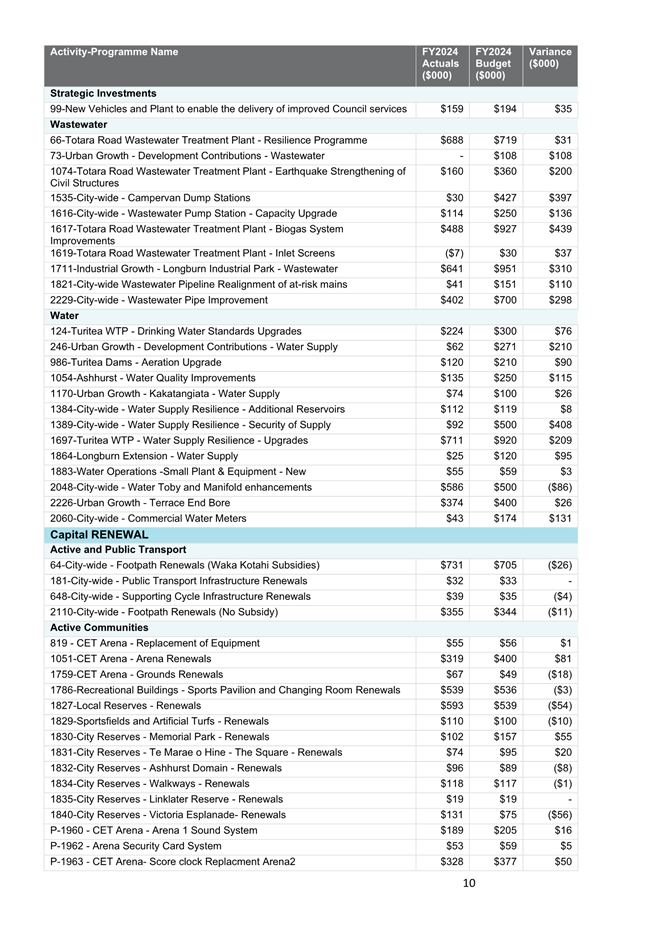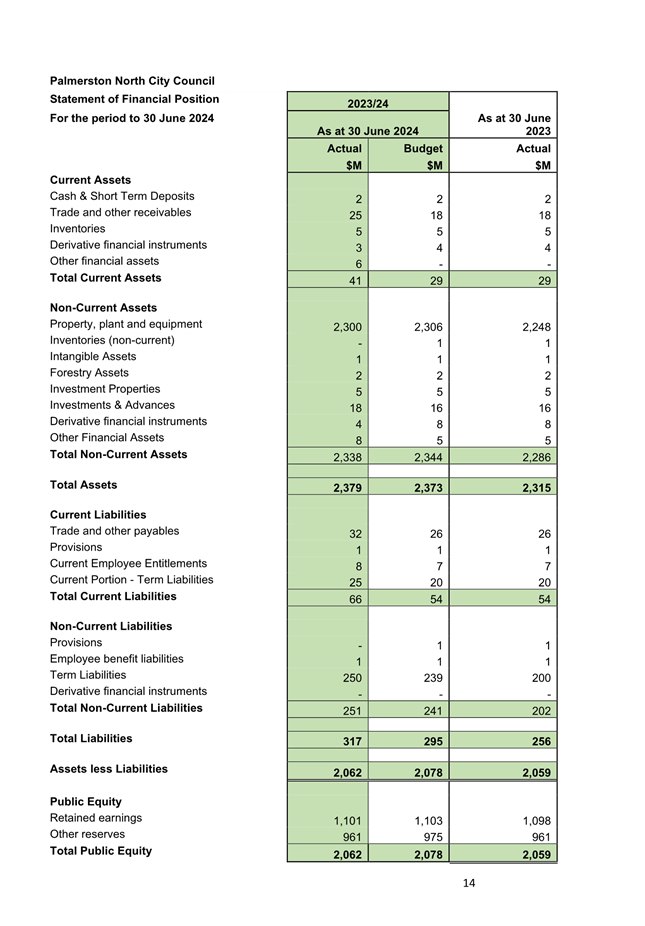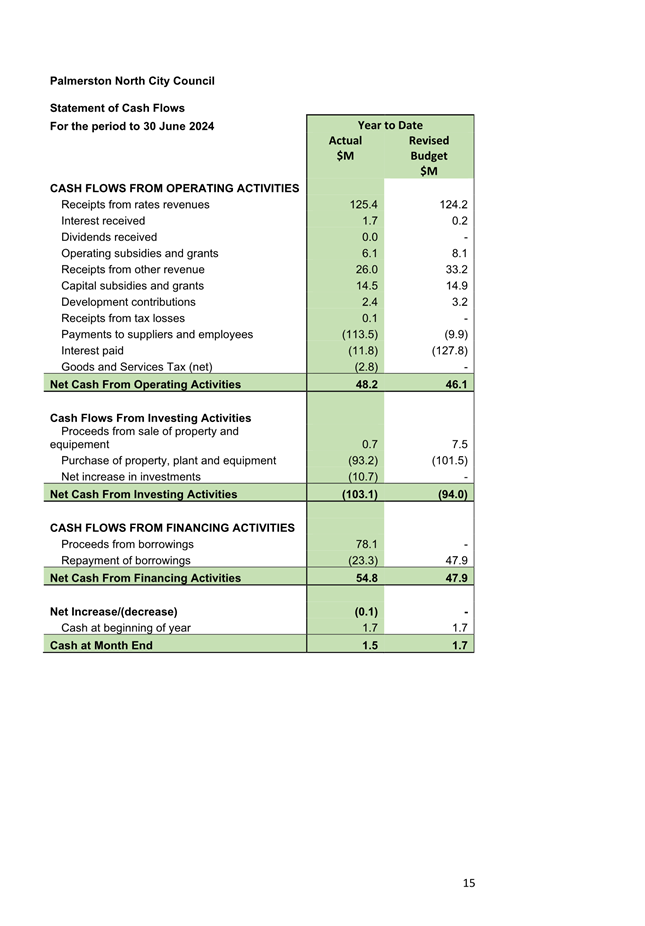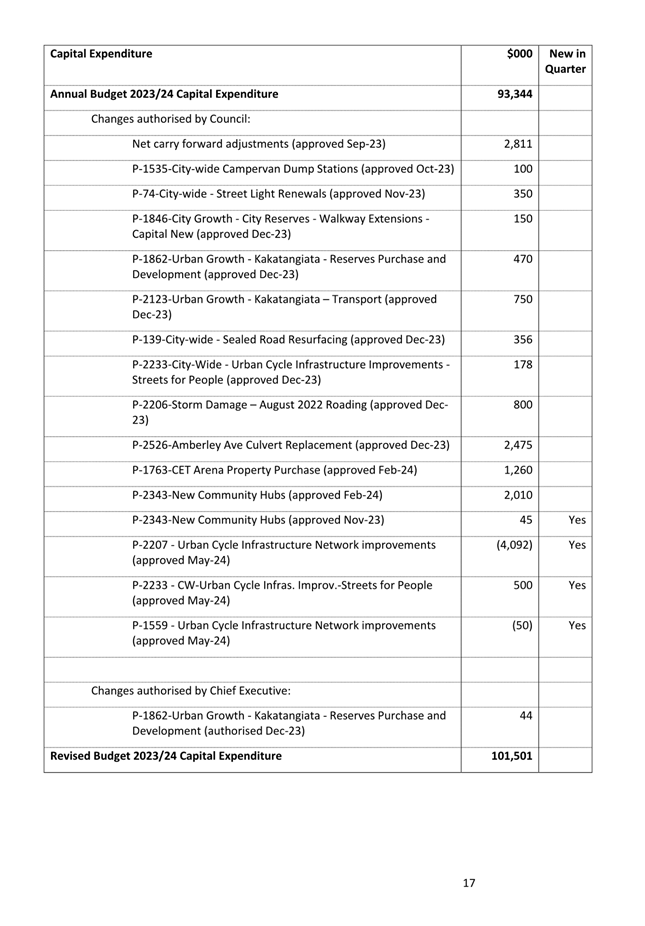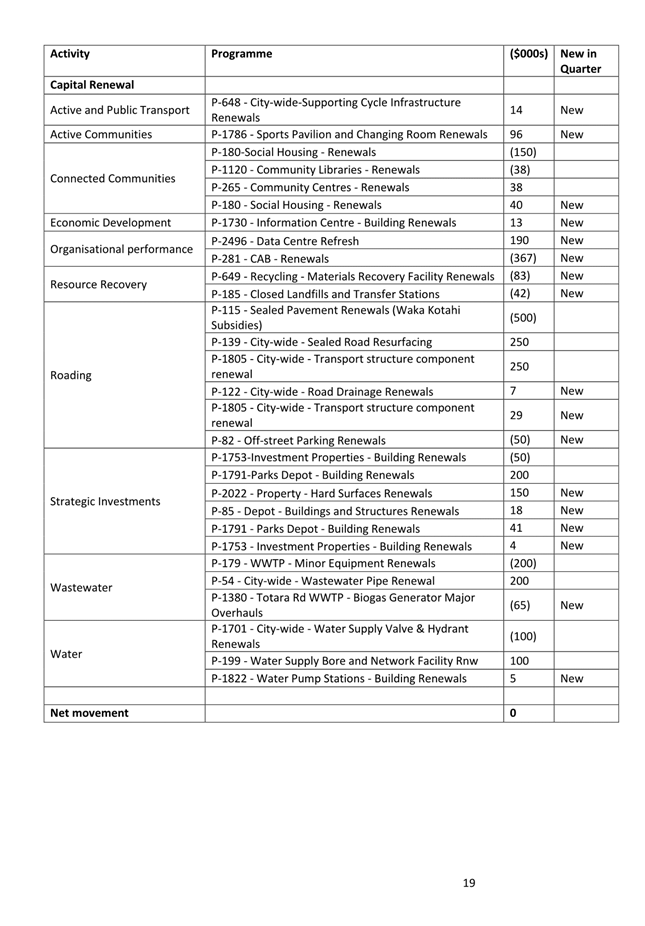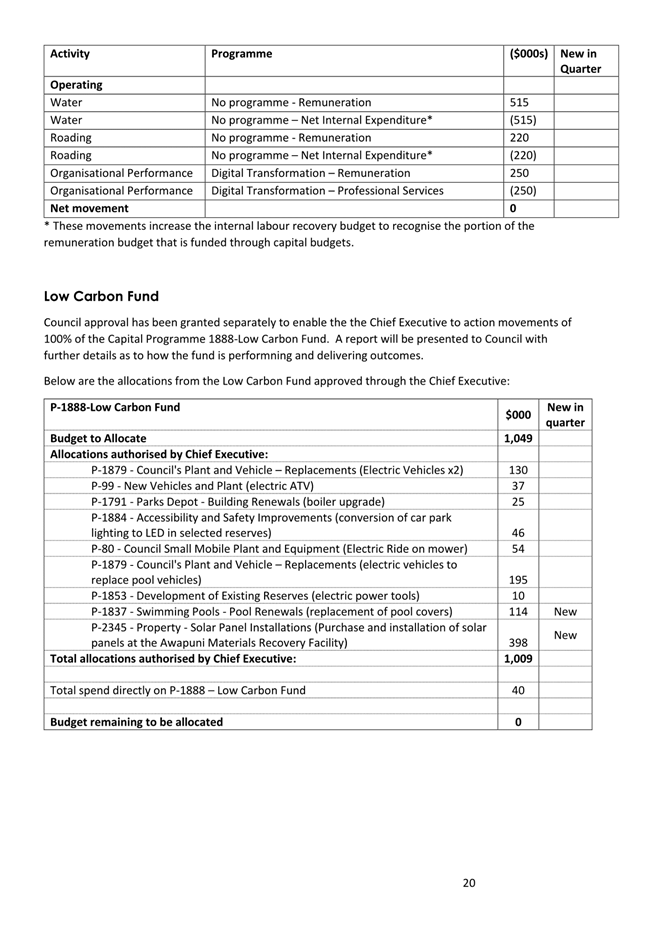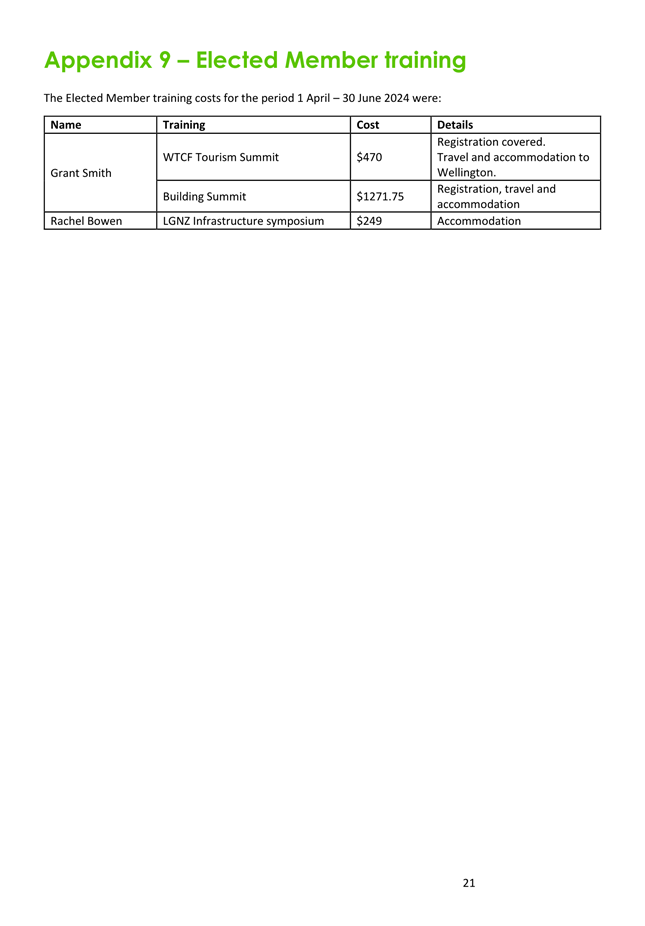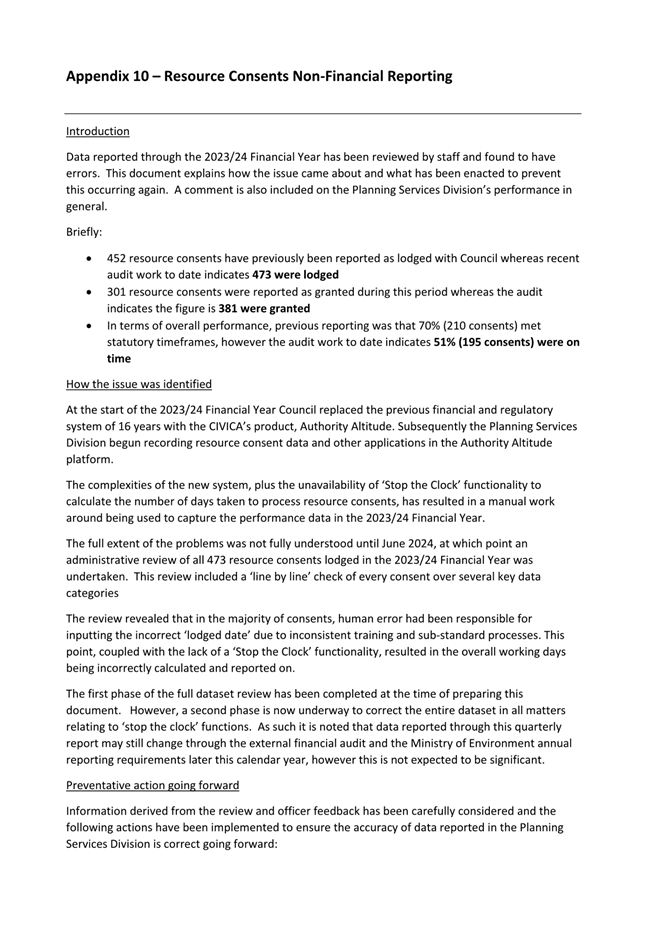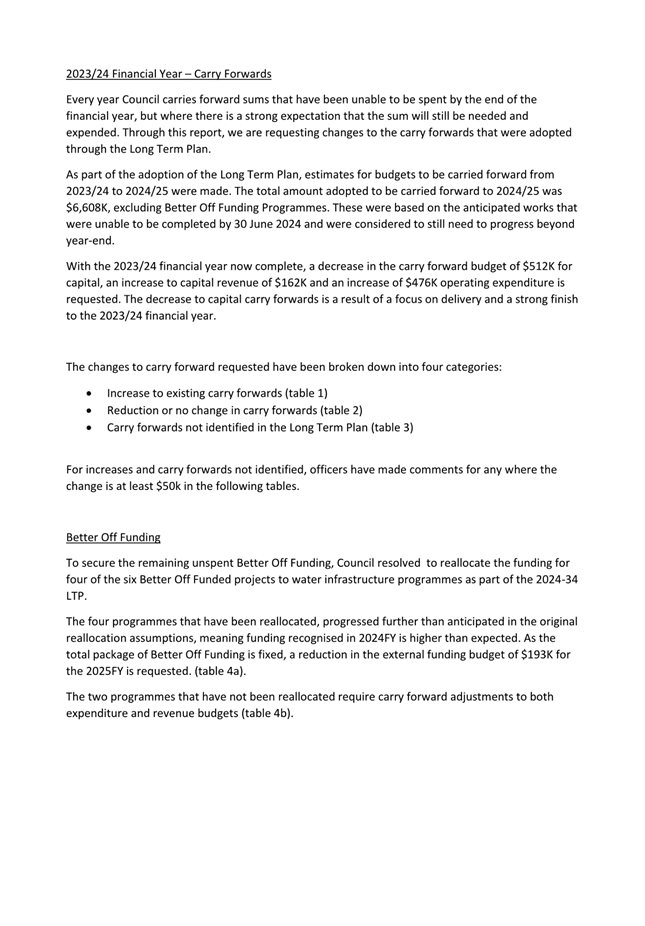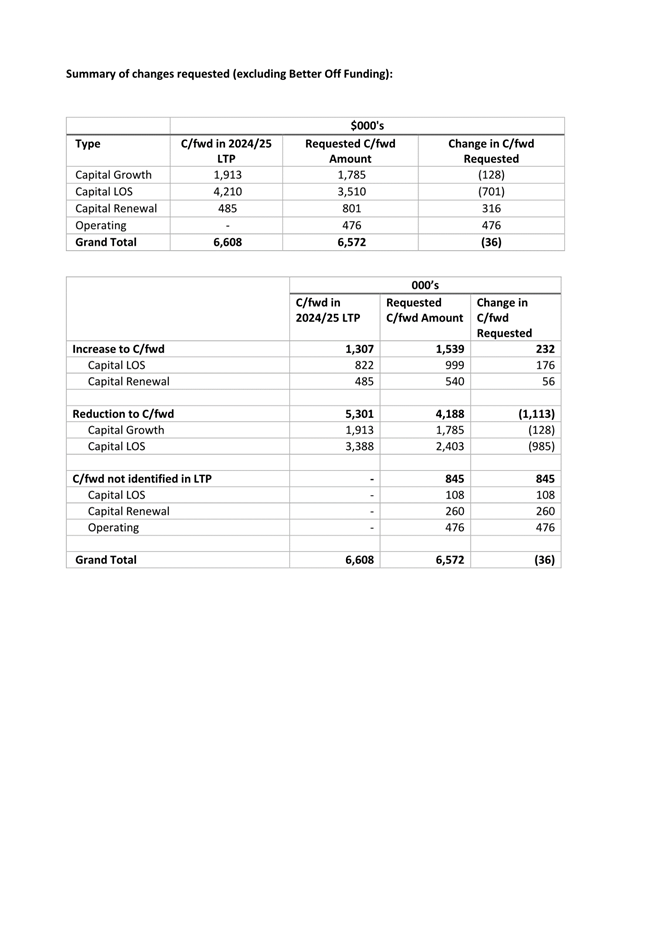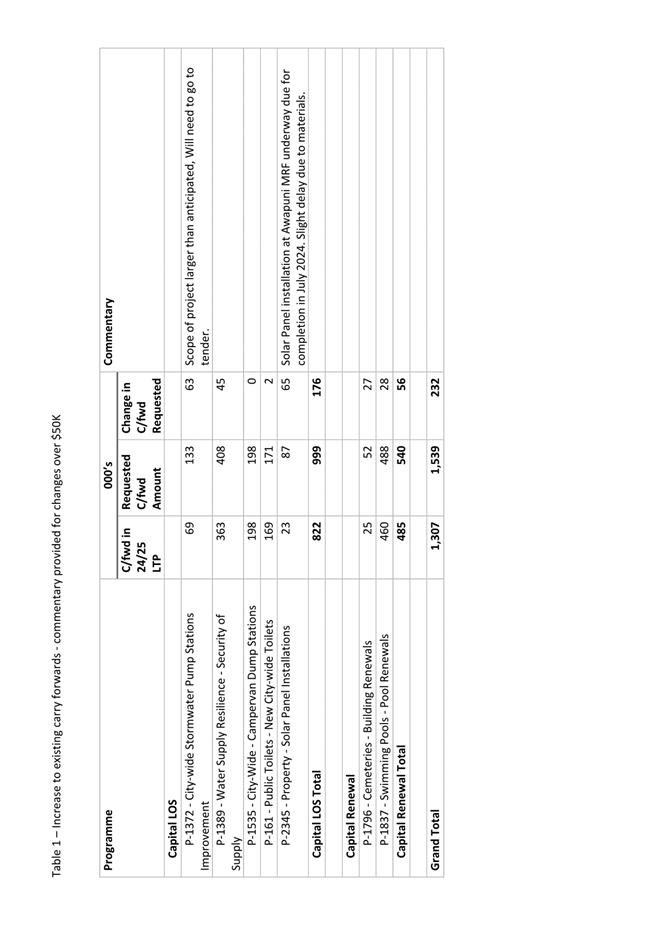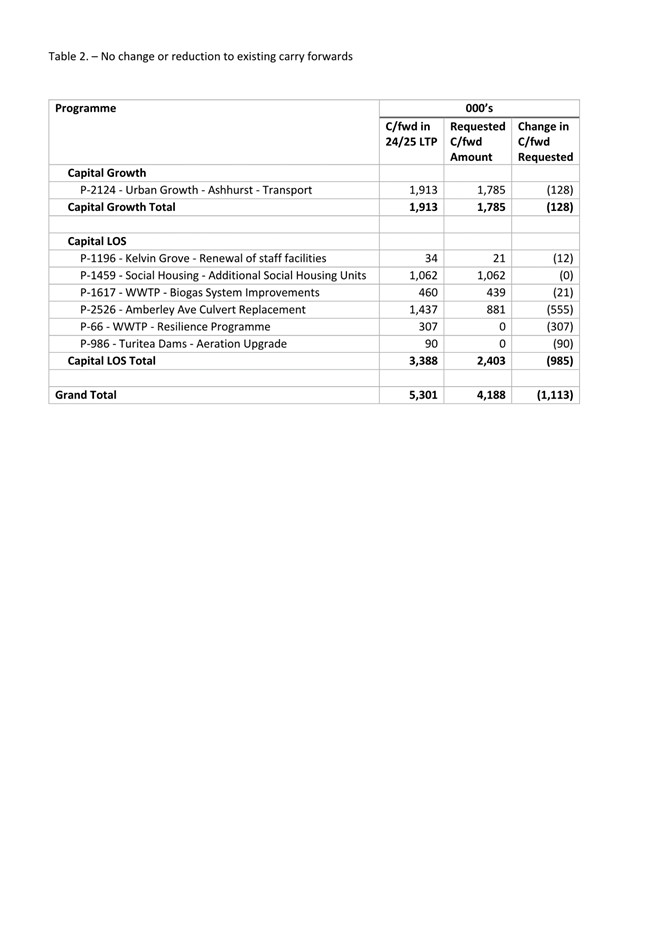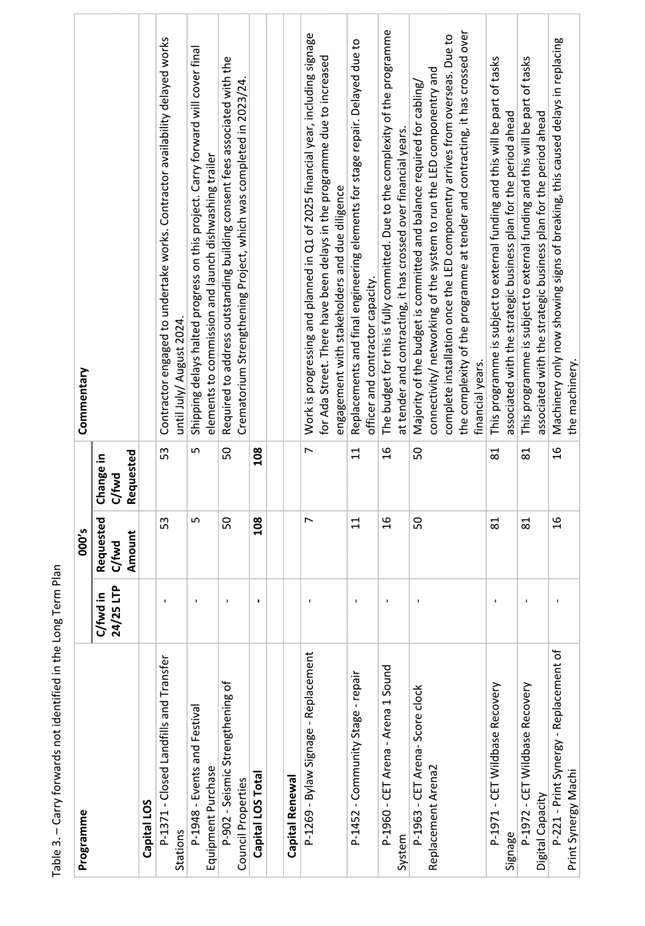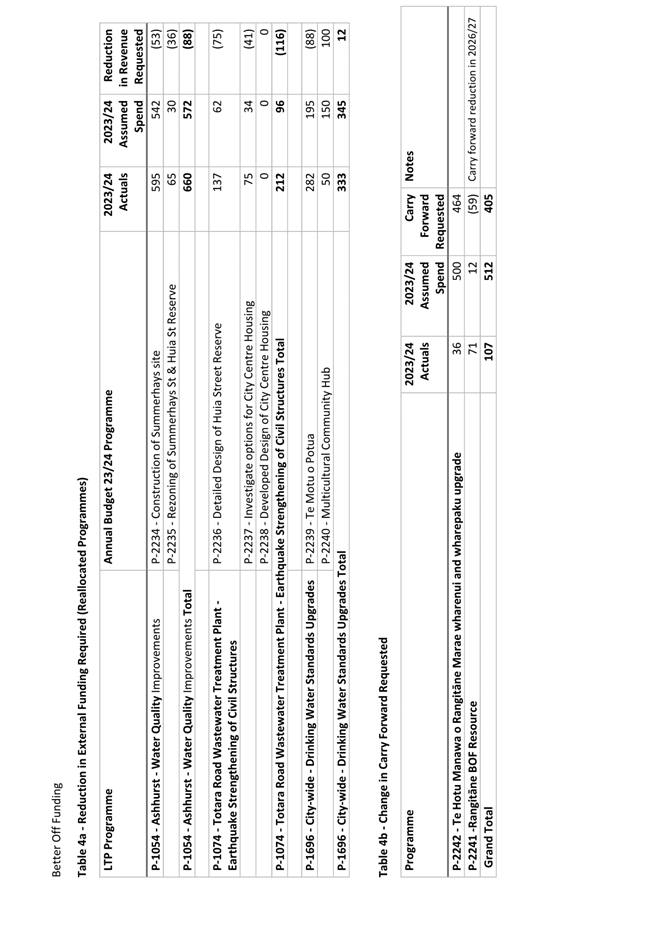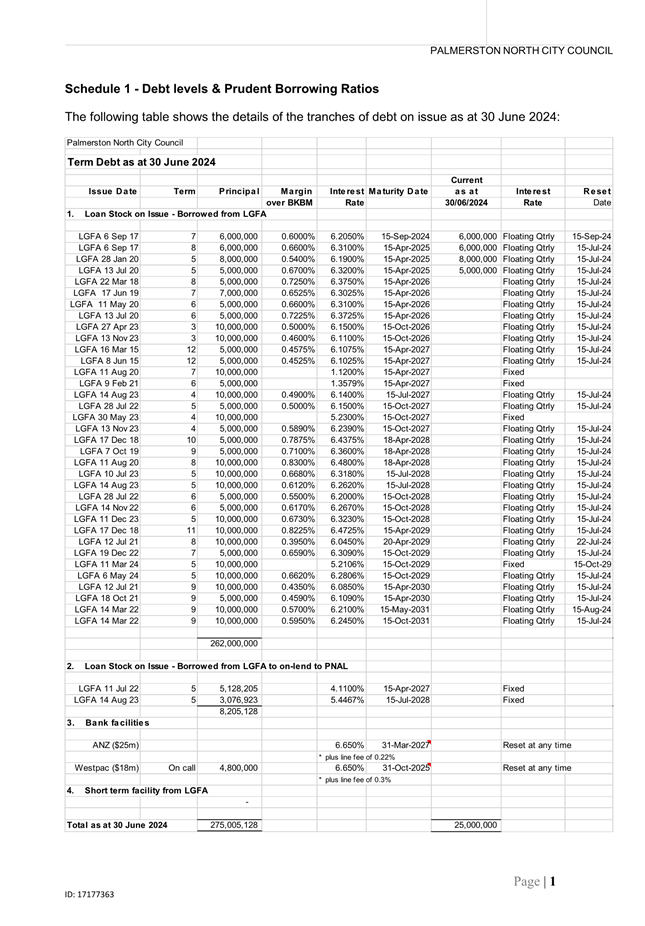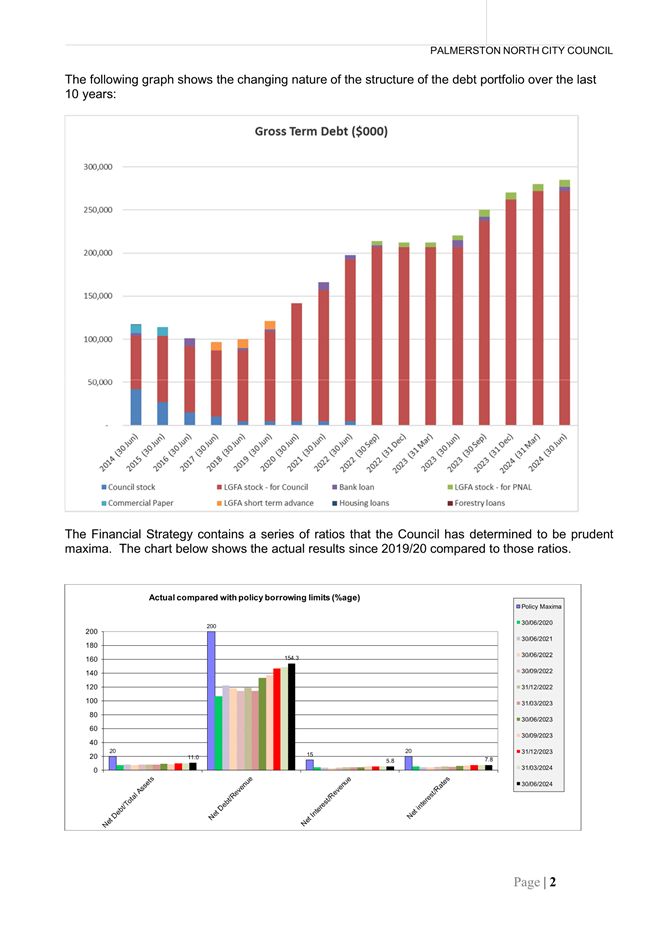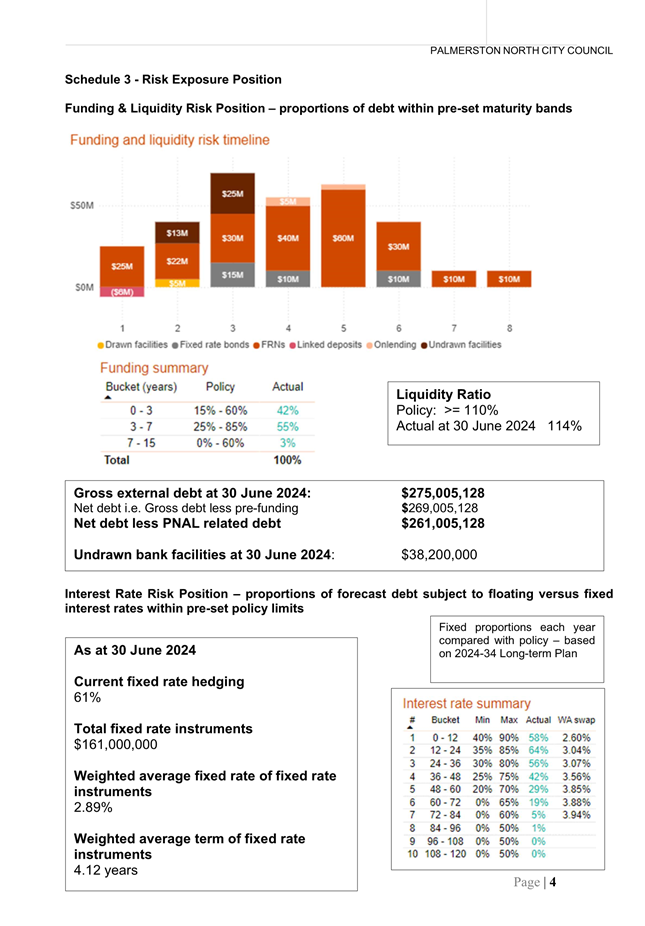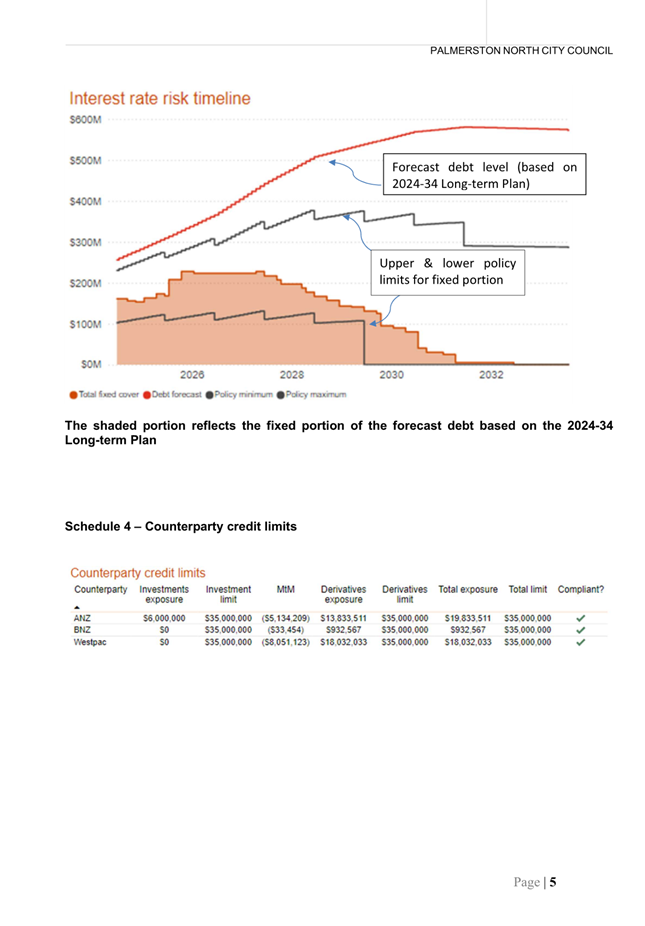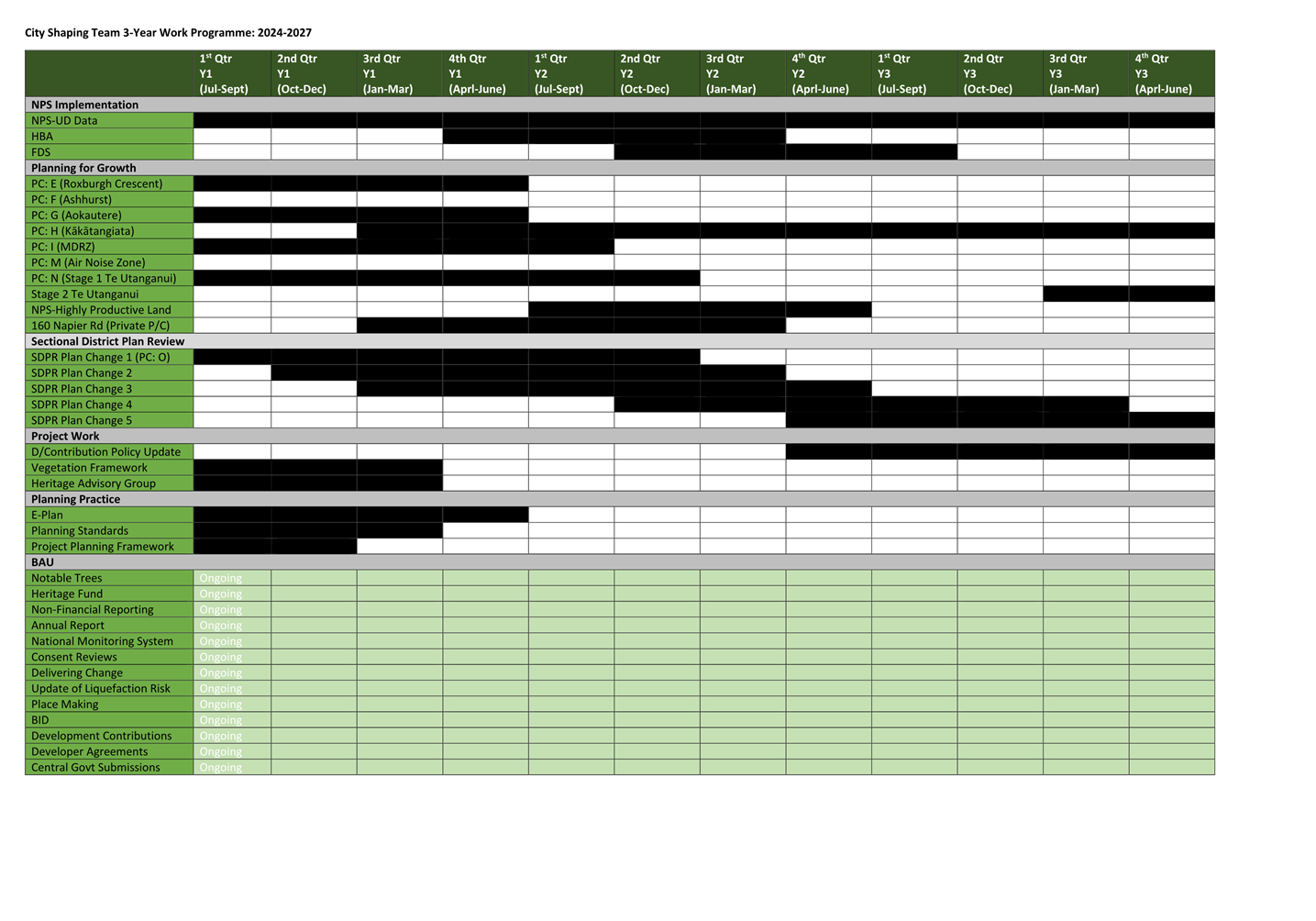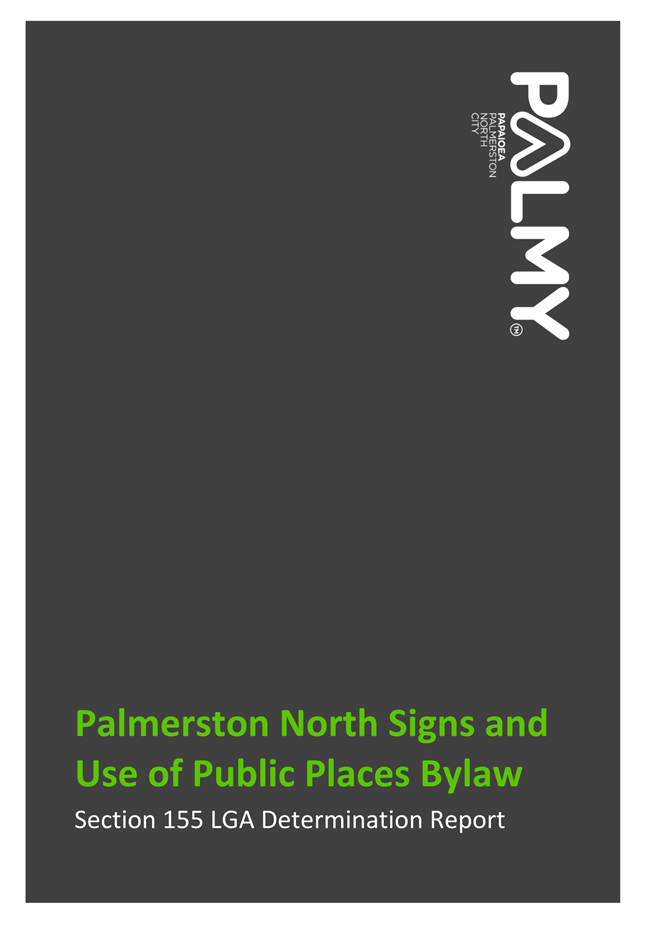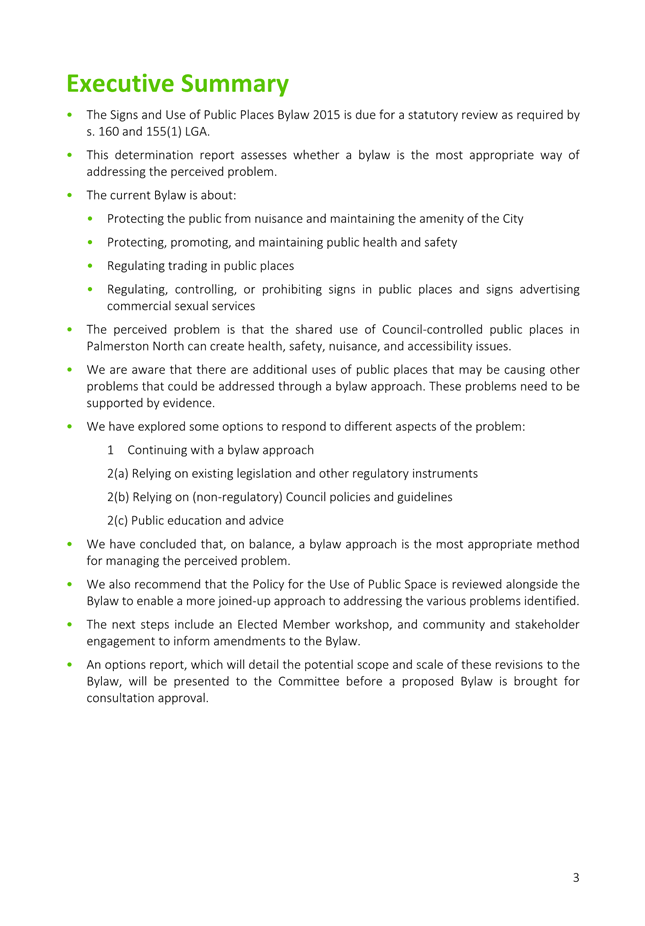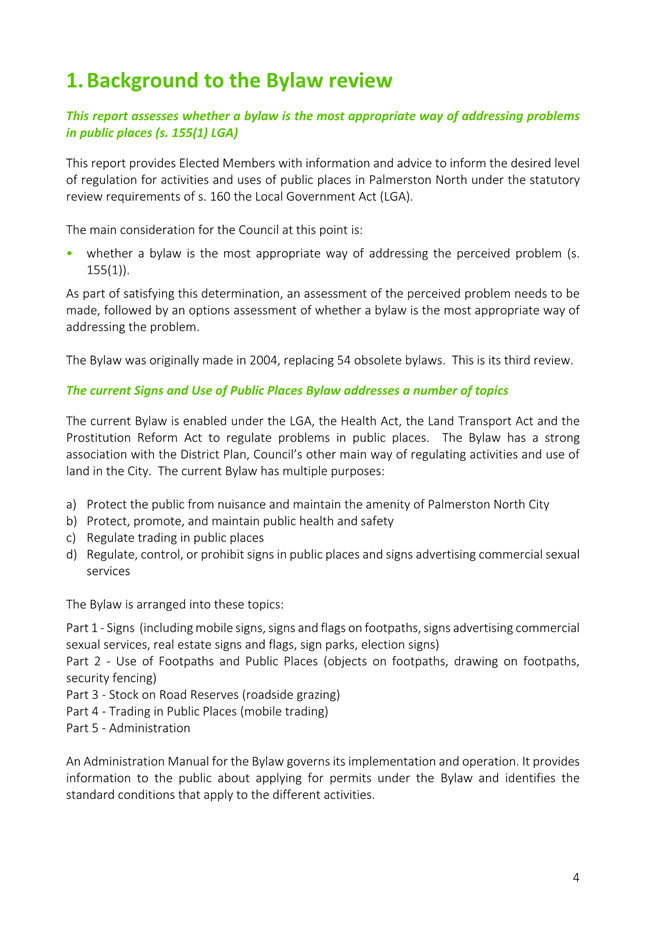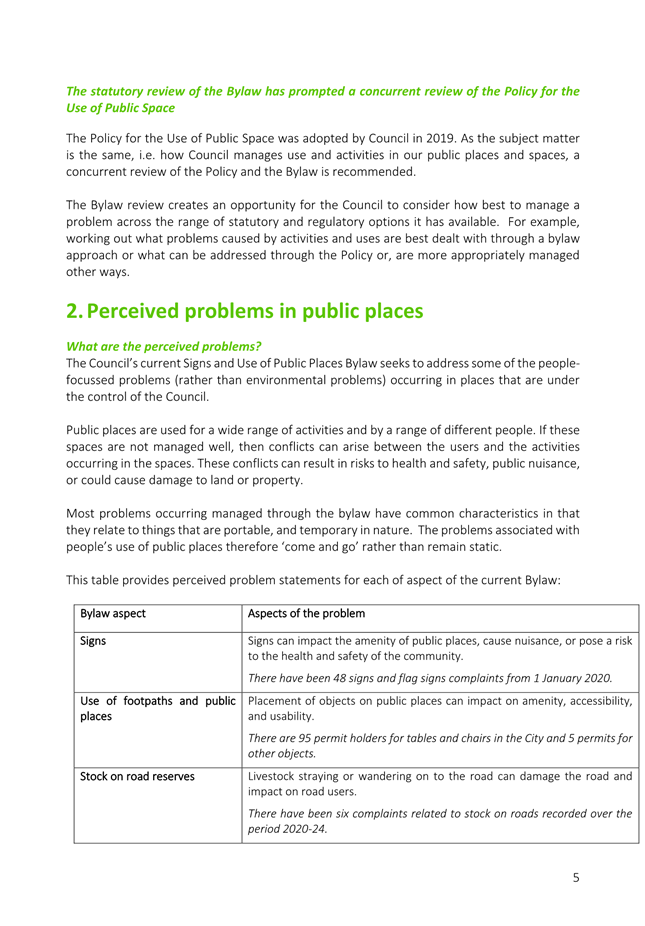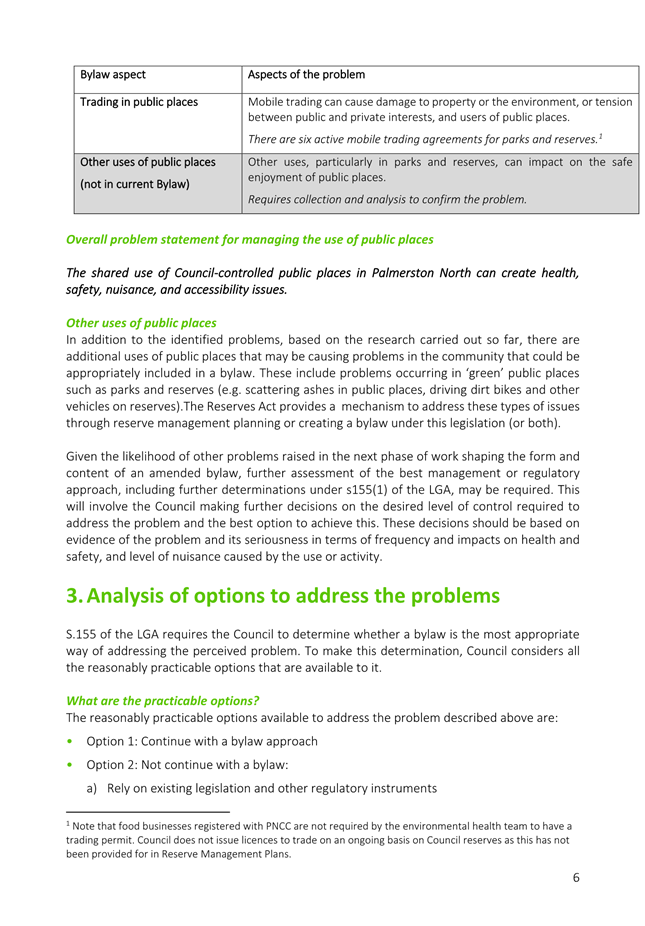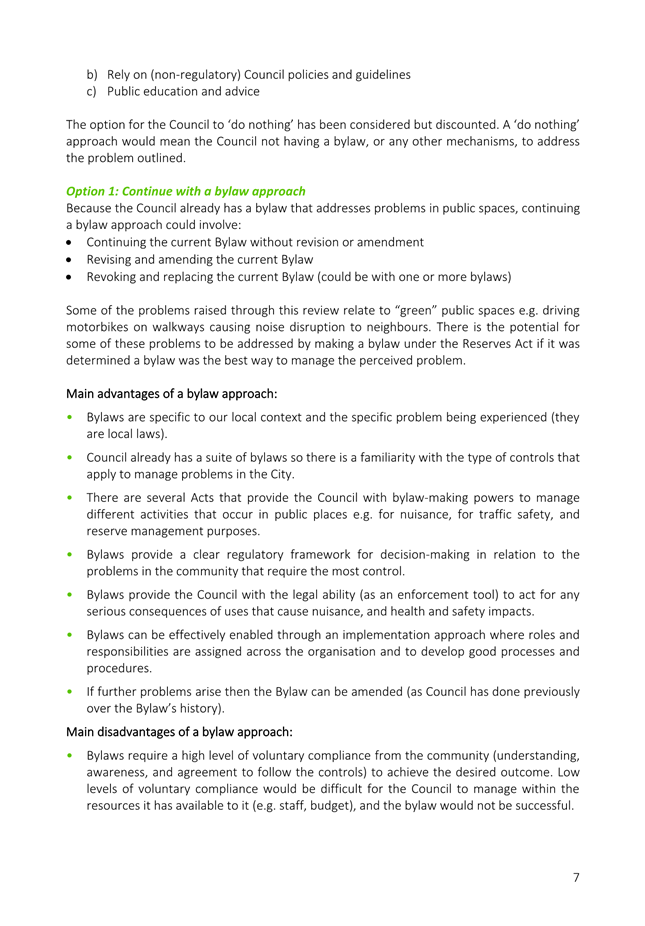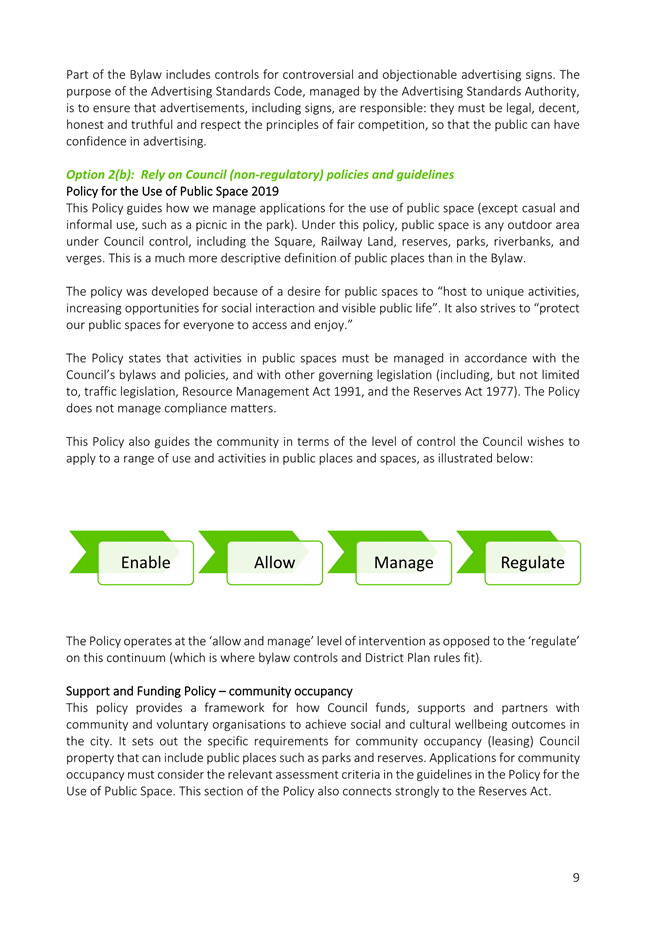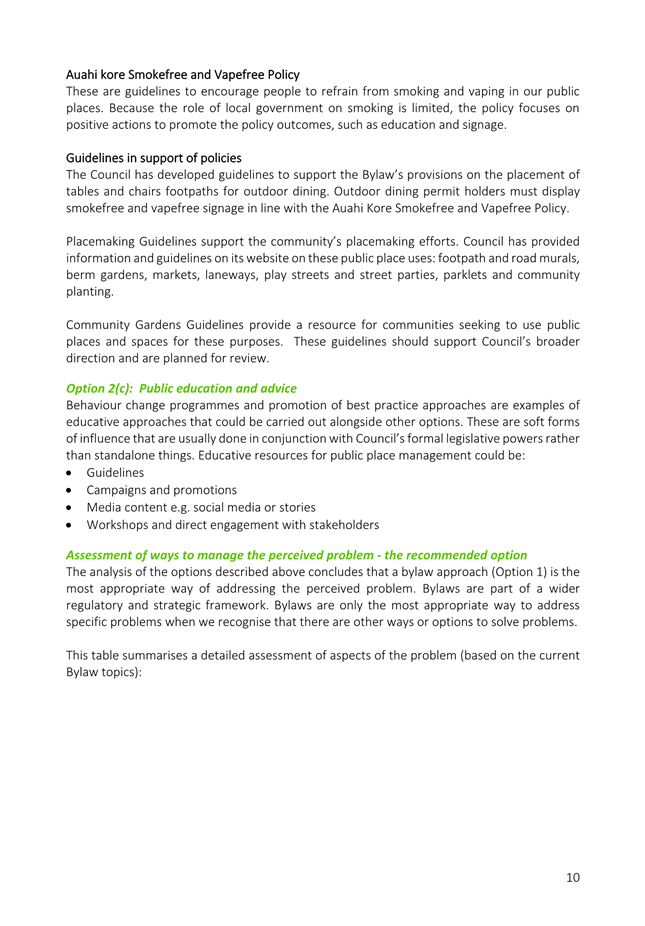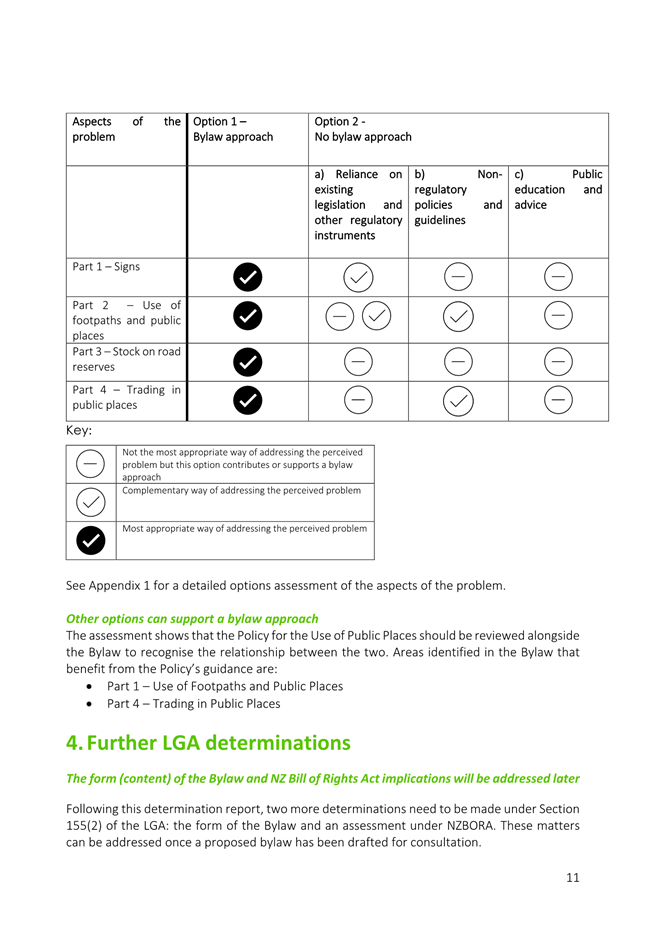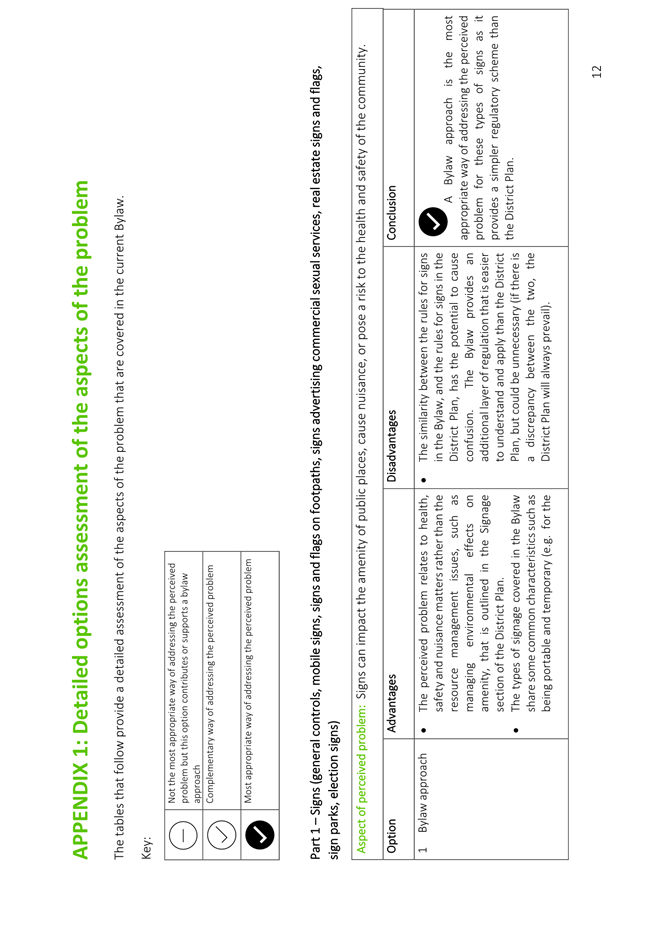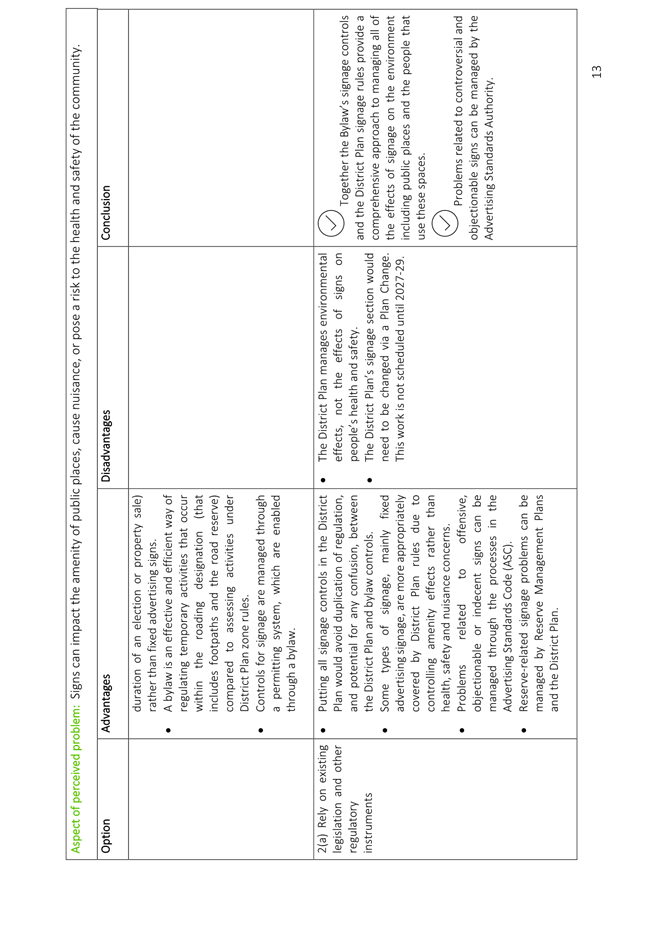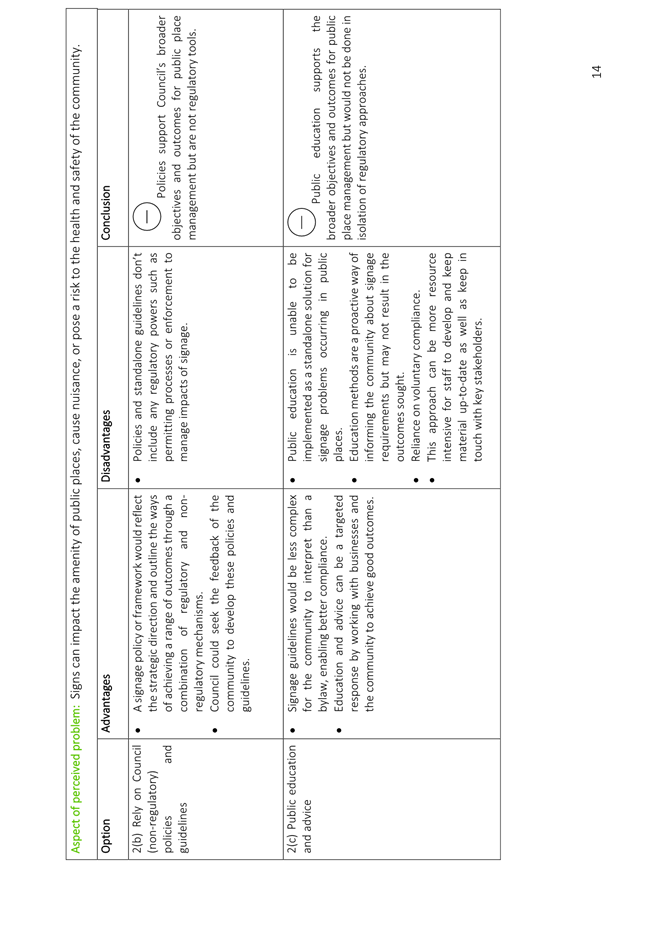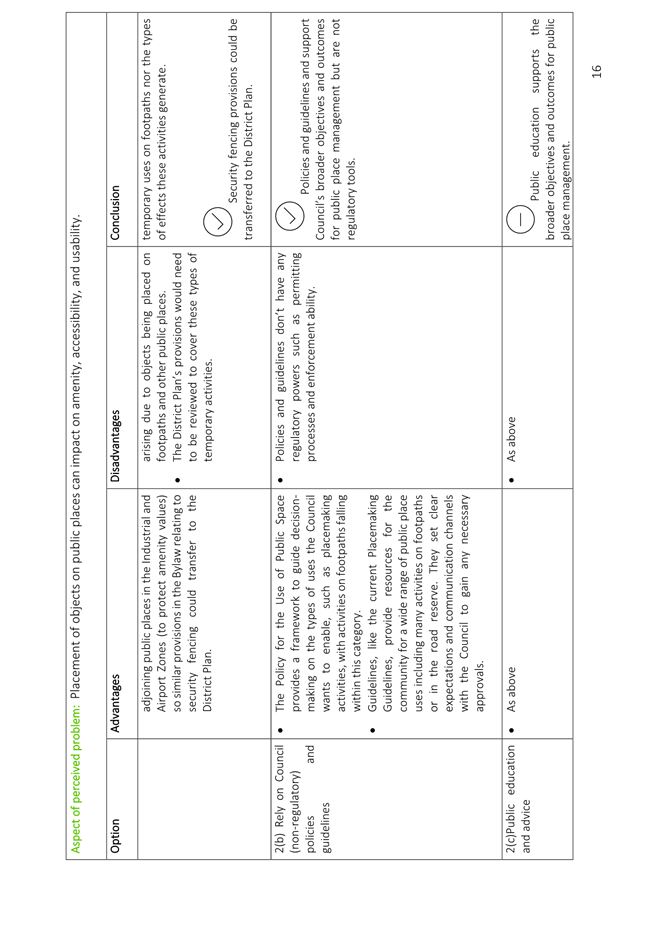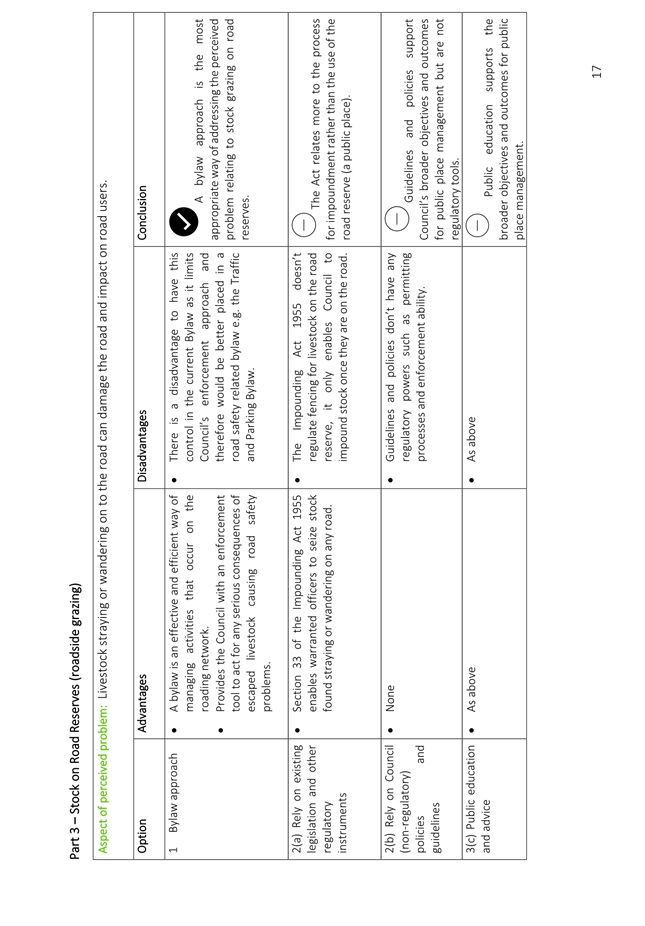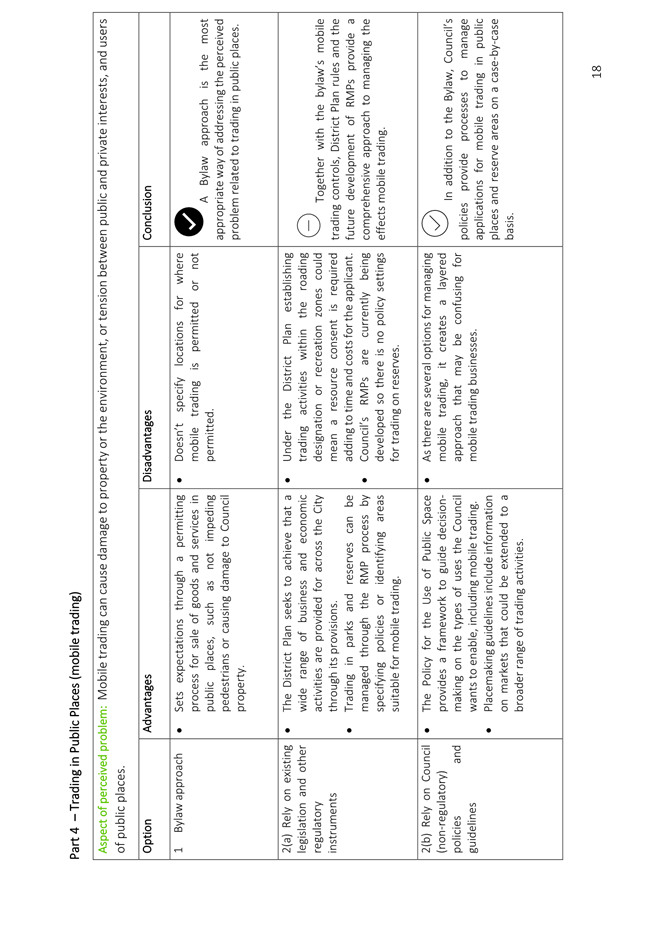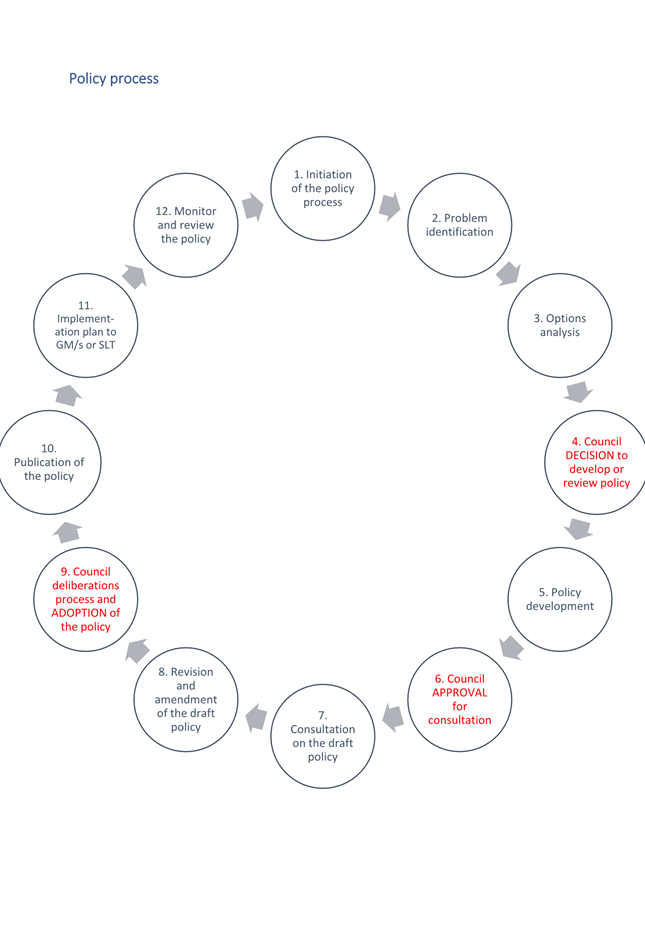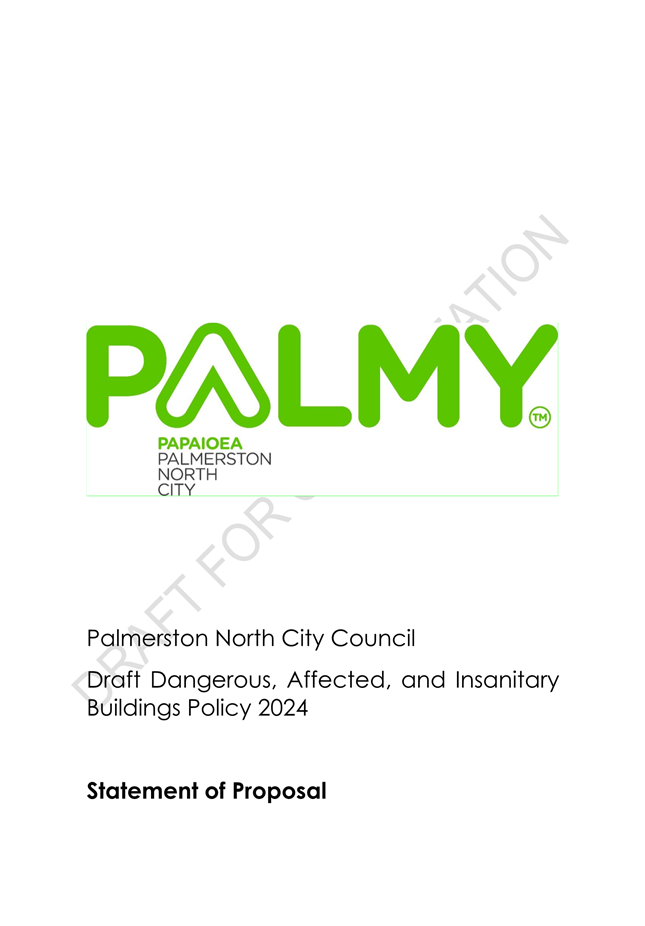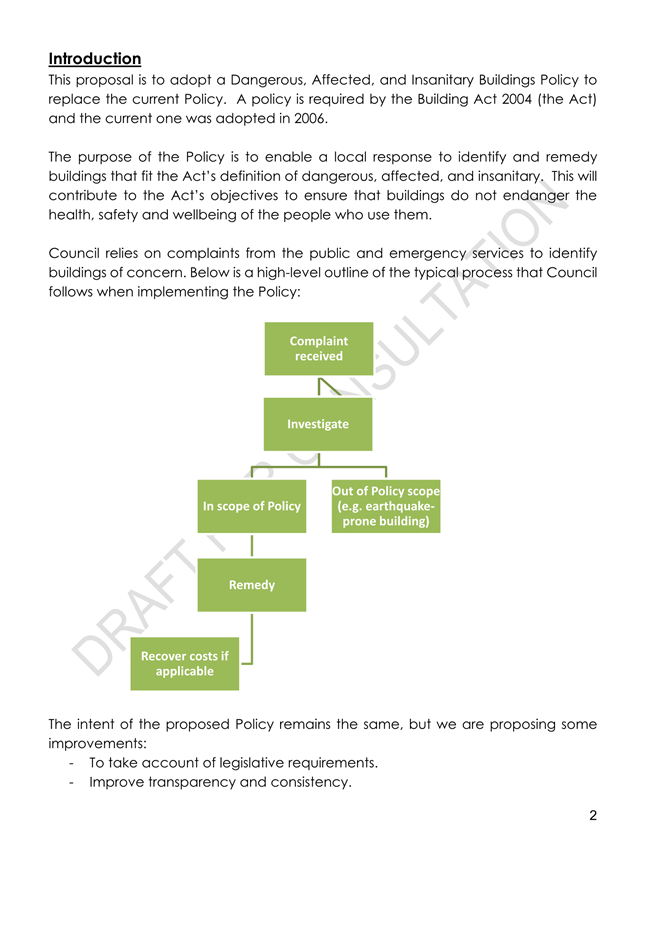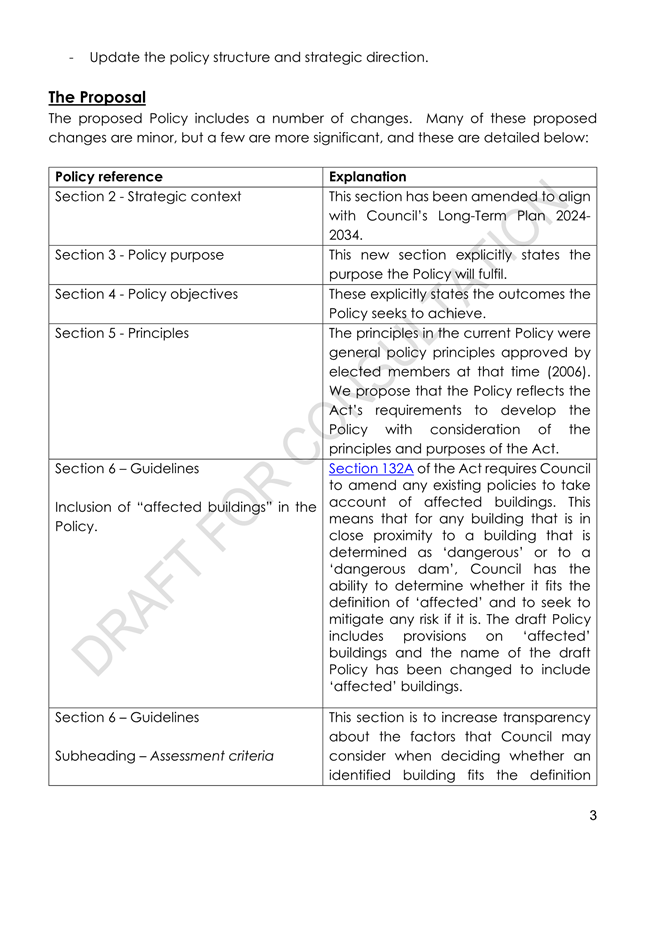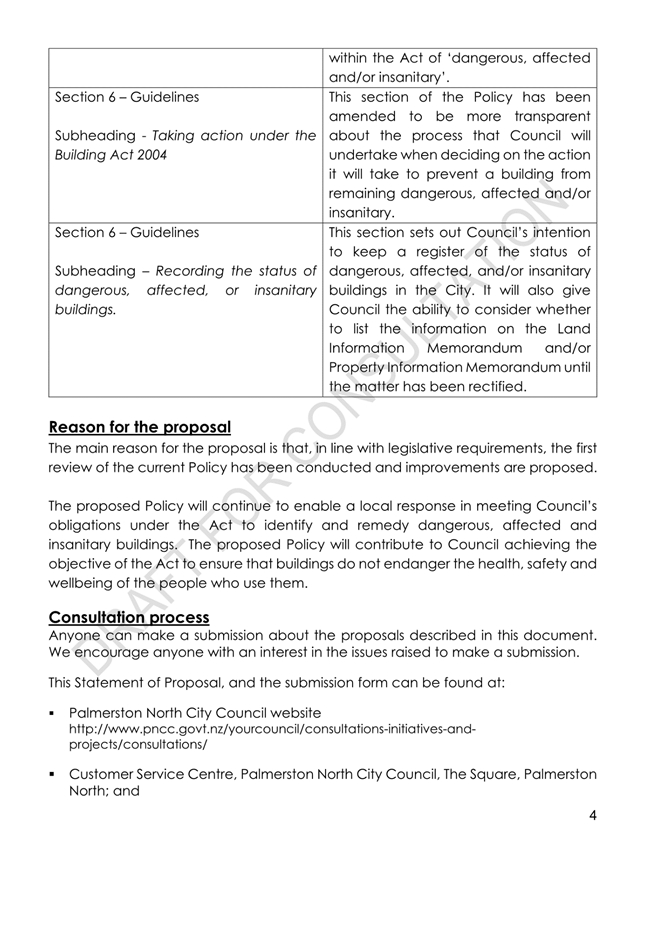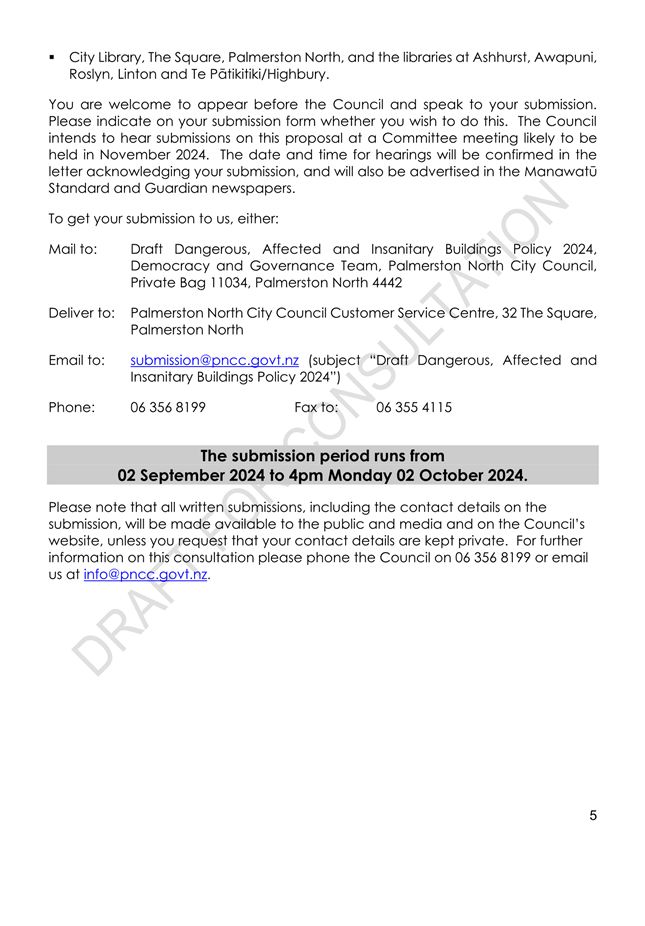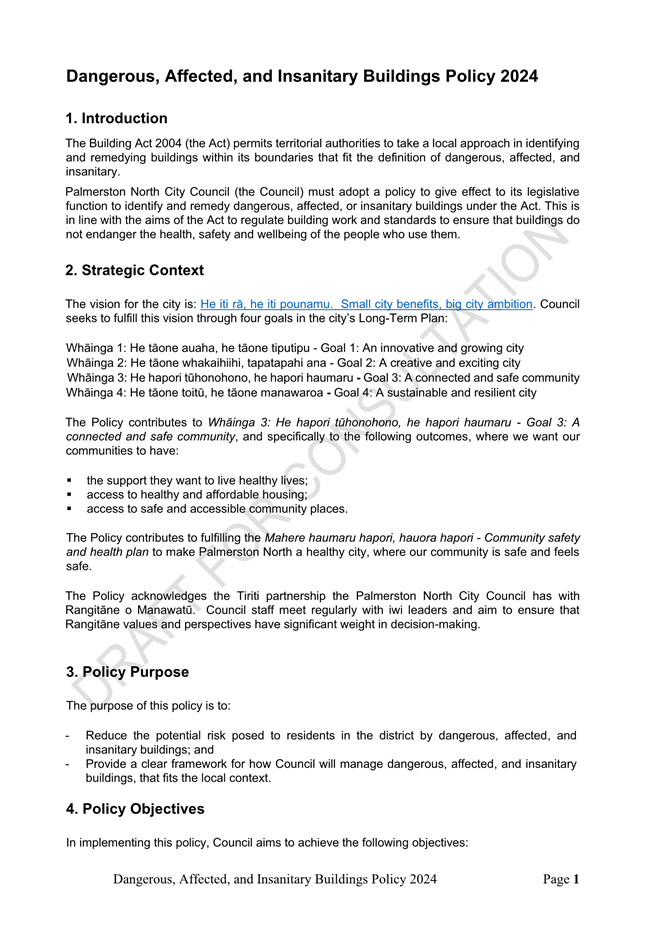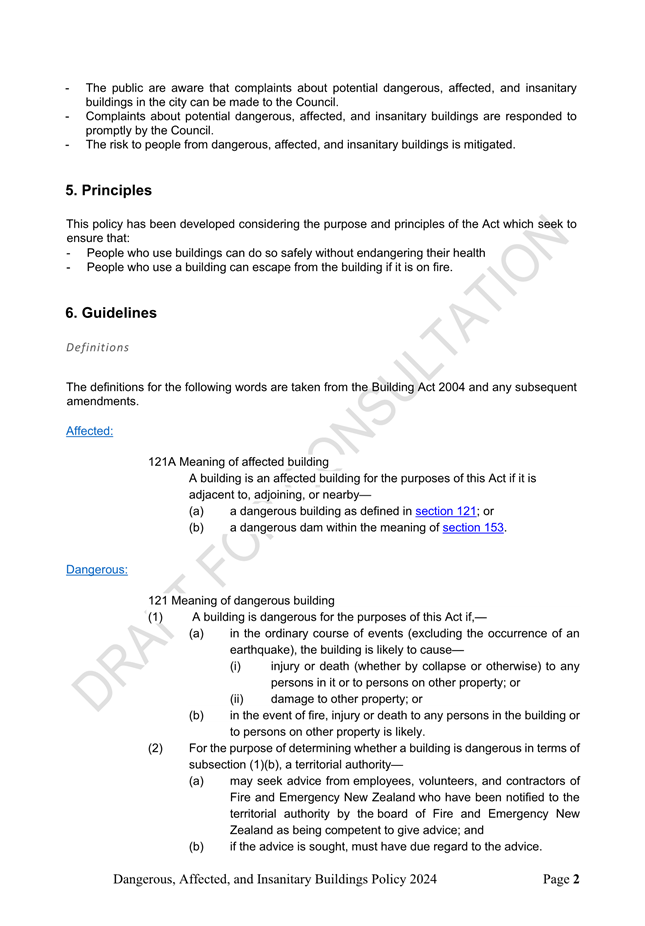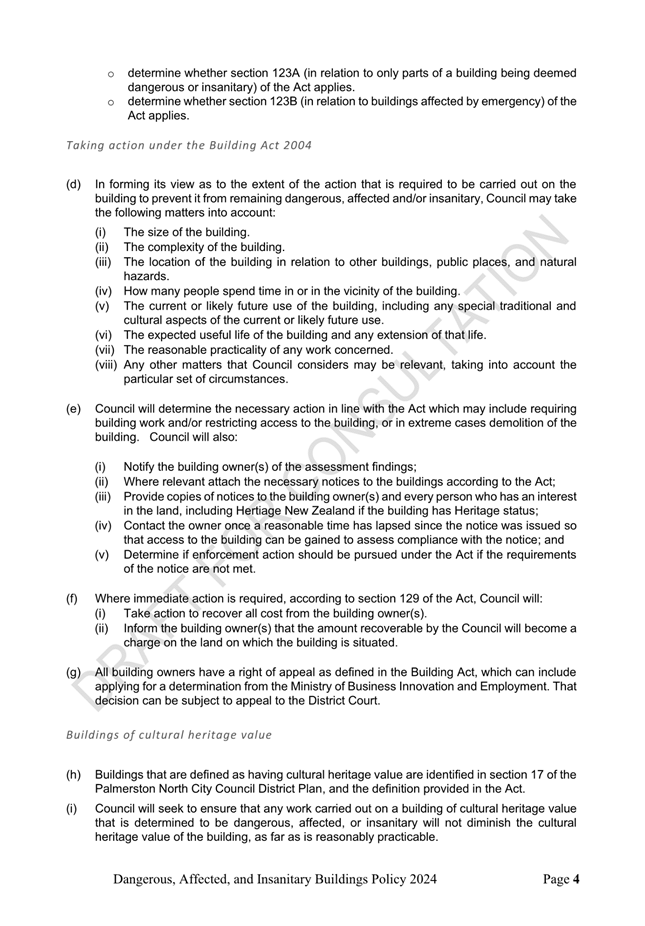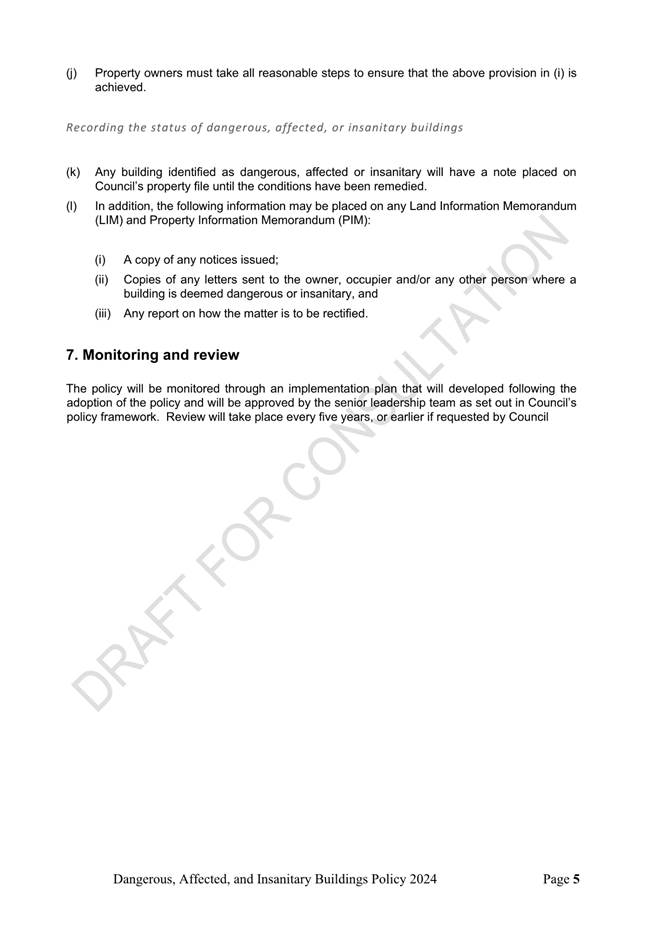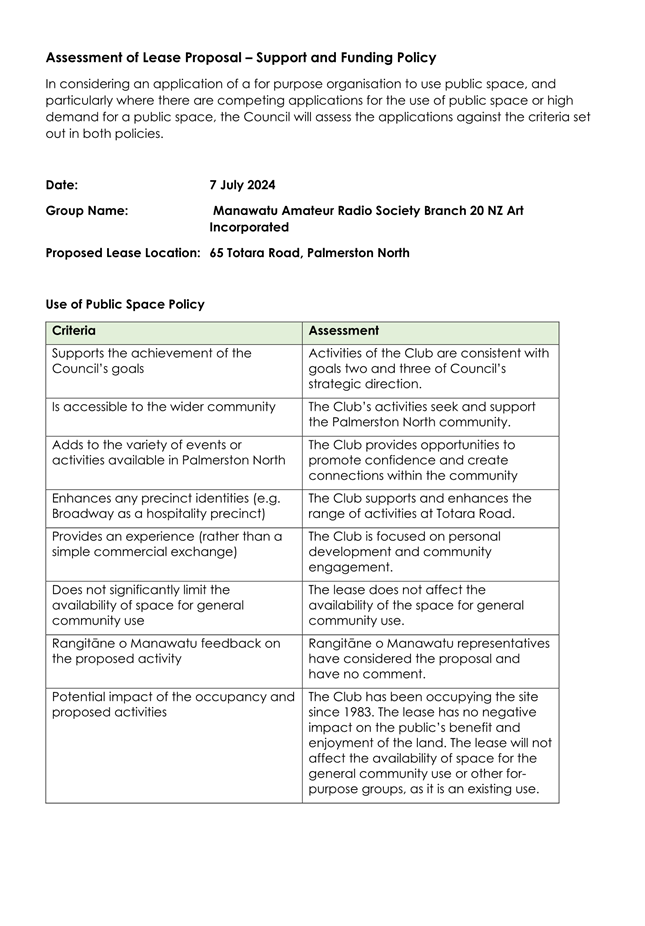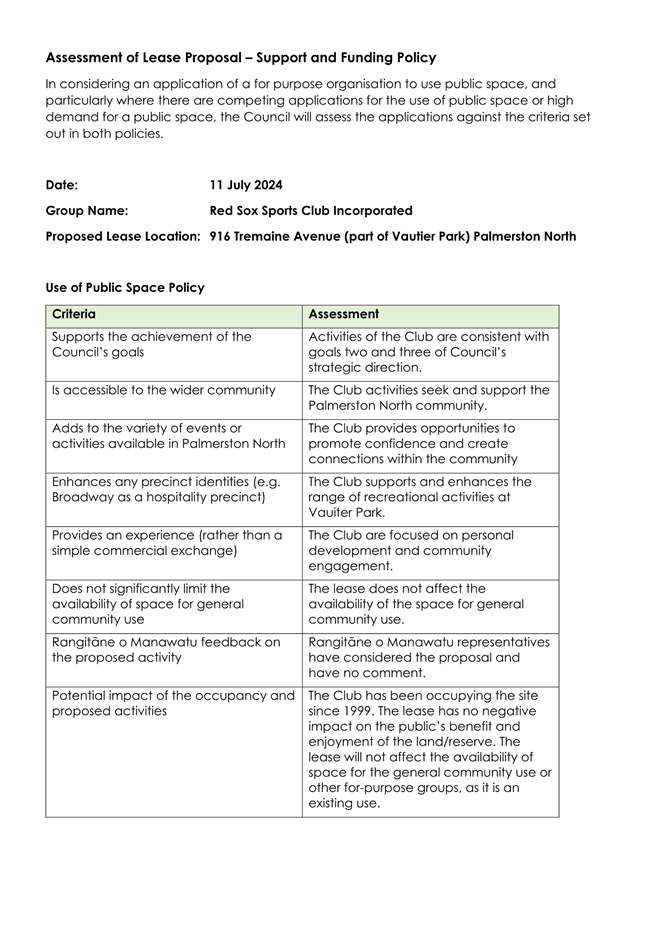Strategy & Finance Committee
|
Vaughan
Dennison (Chair)
|
|
Karen
Naylor (Deputy Chair)
|
|
Grant
Smith (The Mayor)
|
|
Mark
Arnott
|
Lorna
Johnson
|
|
Brent
Barrett
|
Orphée
Mickalad
|
|
Lew
Findlay (QSM)
|
William
Wood
|
|
Patrick
Handcock (ONZM)
|
Kaydee
Zabelin
|
|
Leonie
Hapeta
|
|
Strategy & Finance
Committee MEETING
14 August 2024
Order of Business
1. Karakia Timatanga
2. Apologies
3. Notification
of Additional Items
Pursuant to Sections 46A(7) and
46A(7A) of the Local Government Official Information and Meetings Act 1987, to
receive the Chairperson’s explanation that specified item(s), which do
not appear on the Agenda of this meeting and/or the meeting to be held with the
public excluded, will be discussed.
Any additions in accordance with
Section 46A(7) must be approved by resolution with an explanation as to why
they cannot be delayed until a future meeting.
Any additions in accordance with
Section 46A(7A) may be received or referred to a subsequent meeting for further
discussion. No resolution, decision or recommendation can be made in
respect of a minor item.
4. Declarations
of Interest (if any)
Members are reminded of their duty
to give a general notice of any interest of items to be considered on this
agenda and the need to declare these interests.
5. Public
Comment
To receive comments from members of
the public on matters specified on this Agenda or, if time permits, on other
Committee matters.
(NOTE: If
the Committee wishes to consider or discuss any issue raised that is not
specified on the Agenda, other than to receive the comment made or refer it to
the Chief Executive, then a resolution will need to be made.)
6. Confirmation
of Minutes Page 7
That the minutes of the Strategy & Finance Committee
meeting of 8 May 2024 Part I Public be confirmed as a true and correct record.
7. Quarterly
Performance and Financial Report - period ending 30 June 2024 Page 15
Memorandum, presented by Scott Mancer, Manager -
Finance and John Aitken, Manager - Project Management Office.
8. Treasury
Report - year ending 30 June 2024 Page 85
Memorandum, presented by Steve Paterson, Manager -
Financial Strategy.
9. City
Planning Priorities and 3-Year Work Programme Page 97
Memorandum, presented by Jono Ferguson-Pye, City
Planning Manager.
10. Palmerston North
City District Plan: Proposed Plan Change E: Roxburgh Residential Area Page 111
Memorandum, presented by Jono Ferguson-Pye, Manager City
Planning and Andrea Harris, Technical Principal - Planning, WSP.
11. Statutory review of
the Signs and Use of Public Places Bylaw 2015 (s155 LGA determination report)
and initiation of the review of the Policy for the Use of Public Space 2019 Page 119
Memorandum, presented by Ann-Marie Mori, Policy Analyst
and Stacey Solomon, Policy Analyst.
12. Approval to consult
on the draft Dangerous, Affected, and Insanitary Buildings Policy 2024 Page 155
Report, presented by Lili Kato, Policy Analyst.
13. Reserve
Declarations and Classifications Page 173
Report, presented by Aaron Phillips, Activities Manager
Parks.
14. Whakarongo Land
Swap - Consultation Submissions Summary Page 183
Memorandum, presented by Bryce Hosking, Manager
Property and Resource Recovery and Perene Green, Property Officer.
15. Public Notification
of a Community Occupancy Lease to Manawatū Amateur Radio Society Branch 20
NZ Art Incorporated Page 185
Report, presented by Bryce Hosking, Manager Property
and Resource Recovery and Perene Green, Property Officer.
16. Public Notification
of a Community Occupancy Lease to Red Sox Sports Club Incorporated Page 195
Report, presented by Bryce Hosking, Manager Property
and Resource Recovery and Perene Green, Property Officer.
17. Ongley Park -
Proposal to grant a lease on Council land to Rose Gardens Croquet Club
Incorporated Page 207
Memorandum, presented by Bryce Hosking, Manager
Property and Resource Recovery and Perene Green, Property Officer.
18. Ongley Park -
Proposal to grant a lease on Council land to Manawatu Cricket Incorporated Page 211
Memorandum, presented by Bryce Hosking, Manager
Property and Resource Recovery and Perene Green, Property Officer.
19. Committee Work Schedule Page 215
20. Karakia
Whakamutunga
21. Exclusion of Public
|
|
To be
moved:
“That the public be excluded from the
following parts of the proceedings of this meeting listed in the table below.
The general subject of each matter to be considered
while the public is excluded, the reason for passing this resolution in
relation to each matter, and the specific grounds under Section 48(1) of the
Local Government Official Information and Meetings Act 1987 for the passing
of this resolution are as follows:
|
General subject of each matter to be
considered
|
Reason for passing this resolution in
relation to each matter
|
Ground(s) under Section 48(1) for
passing this resolution
|
|
22.
|
Confirmation of the minutes of the Strategy &
Finance Committee meeting of 8 May 2024 Part II Confidential
|
For the reasons set out in the Strategy &
Finance Committee of 8 May 2024, held in public present.
|
|
|
|
|
This resolution is made in reliance on Section
48(1)(a) of the Local Government Official Information and Meetings Act 1987
and the particular interest or interests protected by Section 6 or Section 7
of that Act which would be prejudiced by the holding of the whole or the
relevant part of the proceedings of the meeting in public as stated in the
above table.
Also that the persons listed below be permitted to
remain after the public has been excluded for the reasons stated.
[Add Third Parties], because of their knowledge and ability to assist the
meeting in speaking to their report/s [or other matters as specified] and
answering questions, noting that such person/s will be present at the meeting
only for the items that relate to their respective report/s [or matters as
specified].
|
Palmerston North City Council
Minutes of
the Strategy & Finance Committee Meeting Part I Public, held in the Council
Chamber, First Floor, Civic Administration Building, 32 The Square, Palmerston
North on 08 May 2024, commencing at 9.00am
|
Members
Present:
|
Councillor Vaughan Dennison (in the
Chair), The Mayor (Grant Smith) and Councillors Karen Naylor, Mark Arnott,
Brent Barrett, Lew Findlay, Patrick Handcock, Leonie Hapeta, Lorna Johnson,
Orphée Mickalad, William Wood and Kaydee Zabelin.
|
|
Non Members:
|
Councillors Roly Fitzgerald, Debi
Marshall-Lobb and Billy Meehan.
|
|
Apologies:
|
The Mayor (Grant Smith) (early departure,
on Council business), Councillors Billy Meehan and Orphée Mickalad
(early departure).
|
The Mayor (Grant Smith) left the
meeting at 10.02am during consideration of clause 25. He was not present for clauses 25 to 31 inclusive.
Councillor Billy Meehan left the meeting at 10.48am
after consideration of clause 27.
He entered the meeting again at 10.51am after consideration of clause 28.
He was not present for clause 28.
|
|
Karakia
Timatanga
|
|
|
Councillor Roly Fitzgerald opened the meeting with
karakia.
|
|
20-24
|
Apologies
|
|
|
Moved
Vaughan Dennison, seconded Karen Naylor.
The COMMITTEE RESOLVED
1. That the
Committee receive the apologies.
|
|
|
Clause 20-24 above was
carried 15 votes to 0, the voting being as follows:
For:
The Mayor (Grant Smith) and
Councillors Vaughan Dennison, Karen Naylor, Mark Arnott, Brent Barrett, Lew
Findlay, Patrick Handcock, Leonie Hapeta, Lorna Johnson, Orphée
Mickalad, William Wood, Kaydee Zabelin, Debi Marshall-Lobb, Roly Fitzgerald
and Billy Meehan.
|
|
21-24
|
Confirmation
of Minutes
|
|
|
Moved Vaughan Dennison, seconded Karen Naylor.
The
COMMITTEE RESOLVED
1. That the
minutes of the Strategy & Finance Committee meeting of 10 April 2024 Part
I Public be confirmed as a true and correct record.
|
|
|
Clause 21-24 above was
carried 13 votes to 0, with 2 abstentions, the voting being as follows:
For:
Councillors Vaughan
Dennison, Karen Naylor, Mark Arnott, Brent Barrett, Lew Findlay, Patrick
Handcock, Leonie Hapeta, Lorna Johnson, Orphée Mickalad, William Wood,
Kaydee Zabelin, Roly Fitzgerald and Billy Meehan.
Abstained:
The Mayor (Grant Smith) and Councillor Debi Marshall-Lobb.
|
|
22-24
|
Quarterly Performance and
Financial Report - period ending 31 March 2024
Memorandum, presented by
Scott Mancer, Finance Manager, John Aitken, Manager - Project Management
Office and Andrew Boyle, Head of Community Planning.
|
|
|
Moved
Vaughan Dennison, seconded Karen Naylor.
The COMMITTEE RESOLVED
1. That the Committee receive
the memorandum titled ‘Quarterly Performance and Financial Report
– period ending 31 March 2024’, and related attachments,
presented on 8 May 2024.
The COMMITTEE RECOMMENDS
2. That the Capital New revenue and expenditure budgets for 2207-Urban
Cycle Infrastructure Network Improvement (Transport Choices) be reduced by
$4,092k to $751k.
|
|
|
Clauses 22.1-24 and 22.2-24 above were carried 15
votes to 0, the voting being as follows:
For:
The Mayor (Grant Smith) and Councillors Vaughan
Dennison, Karen Naylor, Mark Arnott, Brent Barrett, Lew Findlay, Patrick
Handcock, Leonie Hapeta, Lorna Johnson, Orphée Mickalad, William Wood,
Kaydee Zabelin, Debi Marshall-Lobb, Roly Fitzgerald and Billy Meehan.
|
|
|
Moved Vaughan Dennison, seconded Karen Naylor.
The
COMMITTEE RECOMMENDS
3. That the Chief Executive is given
delegation for the 2023/24 financial year to move budgets in excess of the
existing delegations between Roading and Active and Public Transport, and
between Stormwater, Water and Wastewater and that these budget movements will
be reported with the June 2024 quarterly report.
|
|
|
Clause 22.3-24 above was carried 13 votes to 2,
the voting being as follows:
For:
The Mayor (Grant Smith) and Councillors Vaughan
Dennison, Karen Naylor, Mark Arnott, Lew Findlay, Patrick Handcock, Leonie
Hapeta, Orphée Mickalad, William Wood, Kaydee Zabelin, Debi
Marshall-Lobb, Roly Fitzgerald and Billy Meehan.
Against:
Councillors Brent Barrett and Lorna Johnson.
|
|
23-24
|
Treasury
Report - quarter ending 31 March 2024
Memorandum, presented by Steve
Paterson, Strategy Manager - Finance.
|
|
|
Moved
Vaughan Dennison, seconded Karen Naylor.
The COMMITTEE RESOLVED
1. That the Committee note the performance of
Council’s treasury activity for the quarter ending 31 March 2024.
|
|
|
Clause 23-24 above was
carried 15 votes to 0, the voting being as follows:
For:
The Mayor (Grant Smith) and
Councillors Vaughan Dennison, Karen Naylor, Mark Arnott, Brent Barrett, Lew
Findlay, Patrick Handcock, Leonie Hapeta, Lorna Johnson, Orphée
Mickalad, William Wood, Kaydee Zabelin, Debi Marshall-Lobb, Roly Fitzgerald
and Billy Meehan.
|
|
24-24
|
Delegation
Manual - Financial Delegations section update
Memorandum, presented by
Hannah White, Democracy & Governance Manager and Scott Mancer, Finance
Manager.
|
|
|
Moved
Vaughan Dennison, seconded Karen Naylor.
The COMMITTEE RECOMMENDS
1. That Council
adopt the revisions to the financial section and definitions section of the
Delegations Manual (Attachments 1 and 2), effective from 1 July 2024.
2. That Council revoke previous sections 1.19-1.20
and 5.3-5.15 of the Delegations Manual, effective from 1 July 2024.
3. That Council note the Fees and Charges clauses of
the financial delegations will be reviewed with the Revenue and Financing
Policy and a report brought back to Council.
|
|
|
Clause 24-24 above was
carried 15 votes to 0, the voting being as follows:
For:
The Mayor (Grant Smith) and
Councillors Vaughan Dennison, Karen Naylor, Mark Arnott, Brent Barrett, Lew
Findlay, Patrick Handcock, Leonie Hapeta, Lorna Johnson, Orphée
Mickalad, William Wood, Kaydee Zabelin, Debi Marshall-Lobb, Roly Fitzgerald
and Billy Meehan.
|
|
25-24
|
Draft
Palmerston North Animals and Bees Bylaw 2024 – Deliberations
Report, presented by Stacey
Solomon, Policy Analyst.
The
Mayor (Grant Smith) left the meeting at 10.02am.
|
|
|
Moved
Vaughan Dennison, seconded Karen Naylor.
The COMMITTEE RECOMMENDS
1. That Council confirm:
a. the Palmerston North Animals and Bees Bylaw 2024 is the most
appropriate means of addressing the perceived problem of regulating the specific requirements for the keeping
of animals (other than dogs) and bees in Palmerston North, protecting the
health and safety of the community;
and
b. the form of the Bylaw is the most appropriate form of bylaw; and
c. the Bylaw does not give rise to any implications under the New
Zealand Bill of Rights Act 1990.
2. That Council adopt the Palmerston North Animals
and Bees Bylaw 2024 and the Palmerston North Animals and Bees Bylaw
Administration Manual 2024 (Attachments 2 and 3).
|
|
|
Clause 25-24 above was
carried 14 votes to 0, the voting being as follows:
For:
Councillors Vaughan
Dennison, Karen Naylor, Mark Arnott, Brent Barrett, Lew Findlay, Patrick
Handcock, Leonie Hapeta, Lorna Johnson, Orphée Mickalad, William Wood,
Kaydee Zabelin, Debi Marshall-Lobb, Roly Fitzgerald and Billy Meehan.
|
|
26-24
|
Draft
Palmerston North Dog Control Policy 2024 - Deliberations
Memorandum, presented by Kate
Harridge, Policy Analyst and Stacey Solomon, Policy Analyst.
In response to concerns
raised by submitters regarding experiences at Linklater Park, and recognising
this is outside the scope of the initial consultation, Elected Members
requested further work on this issue.
|
|
|
Moved
Vaughan Dennison, seconded Lorna Johnson.
The COMMITTEE RECOMMENDS
1. That Council adopt the Palmerston North Dog
Control Policy 2024, as presented in Attachment 2 of this memorandum.
Moved Lorna Johnson, seconded Vaughan Dennison.
2. That
the Chief Executive engage with the community around the option of
designating part of Linklater Park as dog-on-lead, and report back to the
Strategy & Finance Committee.
|
|
|
Clause 26-24 above was
carried 14 votes to 0, the voting being as follows:
For:
Councillors Vaughan
Dennison, Karen Naylor, Mark Arnott, Brent Barrett, Lew Findlay, Patrick
Handcock, Leonie Hapeta, Lorna Johnson, Orphée Mickalad, William Wood,
Kaydee Zabelin, Debi Marshall-Lobb, Roly Fitzgerald and Billy Meehan.
|
|
27-24
|
Opie Reserve and Tui Park:
Proposal to grant a lease on Council land to Te Kōhanga Reo O Ngati
Hineaute Ki Rangitaane O Manawatū Trust - Deliberations Report
Memorandum, presented by
Bryce Hosking, Group Manager - Property and Resource Recovery and Perene
Green, Property Officer.
|
|
|
Moved
Vaughan Dennison, seconded Karen Naylor.
The COMMITTEE RESOLVED
1. That the Committee grant leases of the land at
both Opie Reserve and part of Tui Park, Palmerston North described as Lot 81
DP 24258 and Sec 1 SO 452061 respectively to Te Kōhanga Reo O Ngāti
Hineaute Ki Rangitaane O Manawatū Trust, in accordance with Council’s
Support and Funding Policy and section 54 of the Reserves Act 1977.
|
|
|
Clause 27-24 above was
carried 14 votes to 0, the voting being as follows:
For:
Councillors Vaughan
Dennison, Karen Naylor, Mark Arnott, Brent Barrett, Lew Findlay, Patrick
Handcock, Leonie Hapeta, Lorna Johnson, Orphée Mickalad, William Wood,
Kaydee Zabelin, Debi Marshall-Lobb, Roly Fitzgerald and Billy Meehan.
|
Councillor Billy Meehan
left the meeting at 10.48am.
|
28-24
|
21 Havelock Avenue (part of
Bill Brown Park): Proposal to grant a licence on Council land to Papaioea
Pasifika Community Trust - Deliberations Report
Memorandum, presented by
Bryce Hosking, Group Manager - Property and Resource Recovery and Perene
Green, Property Officer (Intermediate).
|
|
|
Moved
Vaughan Dennison, seconded Karen Naylor.
The COMMITTEE RESOLVED
1. That the Committee grant a licence of the land at
21 Havelock Avenue (part of Bill Brown Park), Palmerston North described as
Lot DP 40097 to Papaioea Pasifika Community Trust, in accordance with
Council’s Support and Funding Policy and section 54 of the Reserves Act
1977.
|
|
|
Clause 28-24 above was
carried 13 votes to 0, the voting being as follows:
For:
Councillors Vaughan
Dennison, Karen Naylor, Mark Arnott, Brent Barrett, Lew Findlay, Patrick
Handcock, Leonie Hapeta, Lorna Johnson, Orphée Mickalad, William Wood,
Kaydee Zabelin, Debi Marshall-Lobb and Roly Fitzgerald.
|
Councillor Billy Meehan
entered the meeting again at 10.51am.
|
29-24
|
Ongley Park - Proposal to
continue supporting Rose Gardens Croquet Club Incorporated by notifying the
public of the intention to grant community occupancy via a lease of Council
land
Report, presented by Bryce
Hosking, Group Manager - Property and Resource Recovery and Perene Green,
Property Officer (intermediate).
|
|
|
Moved
Vaughan Dennison, seconded Karen Naylor.
The COMMITTEE RESOLVED
1. That Council
continues to support Rose Gardens Croquet Club Incorporated by notifying the
public of its intention to grant community occupancy of Council land at
Ongley Park, Palmerston North in accordance with the Support and Funding
Policy 2022.
2. That Council notes the land affected by the
community occupancy of Rose Gardens Croquet Club Incorporated is described as
Lot 2 DP 77988.
|
|
|
Clause 29-24 above was
carried 14 votes to 0, the voting being as follows:
For:
Councillors Vaughan
Dennison, Karen Naylor, Mark Arnott, Brent Barrett, Lew Findlay, Patrick
Handcock, Leonie Hapeta, Lorna Johnson, Orphée Mickalad, William Wood,
Kaydee Zabelin, Debi Marshall-Lobb, Roly Fitzgerald and Billy Meehan.
|
|
30-24
|
Committee
Work Schedule
|
|
|
Moved
Vaughan Dennison, seconded Karen Naylor.
The COMMITTEE RESOLVED
1. That the
Strategy & Finance Committee receive its Work Schedule dated May 2024.
|
|
|
Clause 30-24 above was
carried 14 votes to 0, the voting being as follows:
For:
Councillors Vaughan
Dennison, Karen Naylor, Mark Arnott, Brent Barrett, Lew Findlay, Patrick
Handcock, Leonie Hapeta, Lorna Johnson, Orphée Mickalad, William Wood,
Kaydee Zabelin, Debi Marshall-Lobb, Roly Fitzgerald and Billy Meehan.
|
Exclusion
of Public
|
31-24
|
Recommendation to
Exclude Public
|
|
|
Moved Vaughan Dennison, seconded Karen Naylor.
The
COMMITTEE RESOLVED
That the public be excluded from the following parts
of the proceedings of this meeting listed in the table below.
The general
subject of each matter to be considered while the public is excluded, the
reason for passing this resolution in relation to each matter, and the
specific grounds under Section 48(1) of the Local Government Official
Information and Meetings Act 1987 for the passing of this resolution are as
follows:
|
General subject of each matter to be
considered
|
Reason for passing this resolution in
relation to each matter
|
Ground(s) under Section 48(1) for passing
this resolution
|
|
18.
|
Ashhurst Three Bridges Loop Track
|
NEGOTIATIONS: This information needs to be kept
confidential to ensure that Council can negotiate effectively, especially
in business dealings
|
s7(2)(i)
|
|
|
|
|
This resolution is made in reliance on Section
48(1)(a) of the Local Government Official Information and Meetings Act 1987
and the particular interest or interests protected by Section 6 or Section 7
of that Act which would be prejudiced by the holding of the whole or the
relevant part of the proceedings of the meeting in public as stated in the
above table.
|
|
|
Clause 31-24 above was carried 14 votes to 0, the voting being as
follows:
For:
Councillors Vaughan
Dennison, Karen Naylor, Mark Arnott, Brent Barrett, Lew Findlay, Patrick
Handcock, Leonie Hapeta, Lorna Johnson, Orphée Mickalad, William Wood,
Kaydee Zabelin, Debi Marshall-Lobb, Roly Fitzgerald and Billy Meehan.
|
The public part of the meeting finished at 10.56am
Confirmed 14 August 2024
Chair
Memorandum
TO: Strategy
& Finance Committee
MEETING DATE: 14
August 2024
TITLE: Quarterly
Performance and Financial Report - period ending 30 June 2024
Presented
By: Scott
Mancer, Manager - Finance and John Aitken, Manager - Project Management Office
APPROVED BY: Cameron
McKay, General Manager Corporate Services
RECOMMENDATION TO COMMITTEE
1. That the
Committee receive the memorandum titled ‘Quarterly Performance and
Financial Report – period ending 30 June 2024’, and related
attachments, presented on 14 August 2024.
2. That the
Committee note that $1.2M of prior year capital expenditure relating to
planning, design and tendering work for the CAB Strengthening Project was
written off to expenses in FY2024 due to decisions made through the Long-Term
Plan 2024-2034 process.
RECOMMENDATION TO COUNCIL
3. That Council
approve the adjustments to carry forward values, including adjustments to
Better off Funding, per the carry forward report (Attachment 6 to the
‘Quarterly Performance and Financial Report – period ending 30 June
2024’, presented to the Strategy & Finance Committee on 14 August
2024).
4. That Council
amend section 5.4.1 of the Delegation Manual to read:
5.4.1 (d) applies except for the Low Carbon fund, where
(e) the Chief Executive
may allocate up to 100% of the Low Carbon Fund programme budget in any
financial year, either alone or in total: to any Activity, whether
Capital New or Capital Renewal.
1. ISSUE
To provide an update on the
performance and financial achievements of the Council for the period ending 30
June 2024.
2. BACKGROUND
Details of operating and
financial performance are included in the attached report, with further
information provided through the appendices to the report.
In May 2024, delegation was
provided to the Chief Executive to move budgets in excess of the existing
delegations between Roading and Active and Public Transport, and between
Stormwater, Water and Wastewater, and that these budget movements would be
reported with the June 2024 quarterly report. The table below outlines
the end of year net results for these activities.
|
Net operating cost of
activities
|
Actual
($000s)
|
Revised
Budget ($000s)
|
Var.
($000s)
|
|
Active
and Public Transport
|
1,425
|
1,737
|
312
|
|
Roading
|
6,026
|
5,221
|
(805)
|
|
Transport
Total
|
7,451
|
6,958
|
(493)
|
|
|
|
|
|
|
Stormwater
|
2,098
|
2,624
|
525
|
|
Wastewater
|
5,874
|
5,113
|
(761)
|
|
Water
|
5,485
|
6,311
|
826
|
|
Total
Waters
|
13,458
|
14,048
|
591
|
3. 1888 - Low Carbon Fund
The 2024-34 Long Term Plan
includes a Capital New programme, 1888 – Low Carbon Fund, to enable opportunities
for Council to seek out low carbon alternatives where possible, leading to
better outcomes in the long term from both an operating expense and an
environmental perspective.
The purpose of this fund is not
to spend against it, but to allocate the fund to other programmes. By
exception, some small projects are managed within the programme. Allocation to
other programmes occurs between new and renewal capital expenditure. As
this is the most significant capital new programme within the Climate Change
Mitigation and Adaption activity, the bulk of this allocation would fall
outside of the current delegations provided to the Chief Executive.
Currently, section 5.4.1(d) of
the Delegation Manual reads:
5.4.1 The
Chief Executive may at any time authorise an expense above the Relevant
Activity Budget agreed by Council, provided that: …
d. any Relevant
Activity Budget variation, in any financial year, does not exceed, either alone
or in total: more than $1M or 30% of the Relevant Activity budget (whichever is
the lesser).
In its current form, this means
that the Chief Executive is not able to allocate the full value of the Low
Carbon Fund to other Activities, or from Capital New to Capital Renewal. In
recent years a specific resolution has been required from Council to enable the
Chief Executive to allocate the Low Carbon Fund to other Activities.
It is therefore requested that
Council add section 5.4.1(e) to the Delegation Manual to provide the Chief
Executive with delegation moving forward. This would read:
5.4.1 (d)
applies except for the Low Carbon fund, where
(e) the Chief Executive may
allocate up to 100% of the Low Carbon Fund programme budget in any financial
year, either alone or in total: to any Activity, whether Capital New or
Capital Renewal.
4. Performance Measures
While compiling the June 2024
quarterly report, Officers have identified some errors in non-financial
measurements from prior quarterly reports. A memo is attached with further
detail in relation to the resource consenting measure in Appendix 10.
5. NEXT STEPS
The FY2024 results will be
audited and the Annual Report will be provided to Council for adoption.
The Delegation Manual will be
updated to reflect the practical application of the Low Carbon Fund.
6. Compliance and administration
|
Does the Council have delegated
authority to decide?
|
Yes
|
|
Are the decisions significant?
|
No
|
|
If they are significant do they
affect land or a body of water?
|
No
|
|
Can this decision only be made
through a 10 Year Plan?
|
No
|
|
Does this decision require
consultation through the Special Consultative procedure?
|
No
|
|
Is there funding in the current
Annual Plan for these actions?
|
No
|
|
Are the recommendations
inconsistent with any of Council’s policies or plans?
|
No
|
|
The recommendations contribute
to:
All of Council’s Goals.
|
|
The
recommendations contribute to the achievement of objectives
in:
(Not
Applicable)
(Not Applicable)
The objective is: to enable
Council to exercise governance by reviewing financial performance and
operating performance and provide accountability for these to the public.
|
|
Contribution to strategic
direction and to social, economic, environmental and cultural well-being
|
As above.
|
|
|
|
Attachments
|
1.
|
June
2024 Financial Dashboard ⇩ 
|
|
|
2.
|
Quarterly
Performance and Financial Report June 2024 ⇩ 
|
|
|
3.
|
Appendix
1 to the Quarterly Performance and Financial Report June 2024 ⇩ 
|
|
|
4.
|
Appendices
2-9 to the Quarterly Performance and Financial Report June 2024 ⇩ 
|
|
|
5.
|
Appendix
10 to the Quarterly Performance and Financial Report June 2024 ⇩ 
|
|
|
6.
|
Carry
forward adjustment report ⇩ 
|
|


Memorandum
TO: Strategy
& Finance Committee
MEETING DATE: 14
August 2024
TITLE: Treasury
Report - year ending 30 June 2024
Presented
By: Steve
Paterson, Manager - Financial Strategy
APPROVED BY: Cameron
McKay, Chief Financial Officer
RECOMMENDATION TO Strategy & Finance Committee
1. That the
Committee note the performance of Council’s treasury activity for the
year ending 30 June 2024.
1. ISSUE
1.1 To
provide an update on the Council’s treasury activity for the year ending
30 June 2024.
2. BACKGROUND
2.1 The
Council’s Annual Budget 2023/24 forecast additional debt of $36.2m would
need to be raised during the year to fund the $65.4m of new capital expenditure
programmes (including assumed carry forwards from 2022/23). In June 2023
the Council resolved to specifically authorise the raising of up to $37m of
additional debt. On 6 March 2024 Council authorised this sum being
increased to $47m to enable debt to be raised to fund additional capital
expenditure approved by Council.
2.2 Council’s
Financial Strategy (version adopted 7 July 2021) contains the following ratios
which the Council has determined to be prudent maxima:
· Net debt as
a percentage of total assets not exceeding 20%
· Net debt as
a percentage of total revenue not exceeding 200% (increased to 250% for
the next 10 years)
· Net interest
as a percentage of total revenue not exceeding 15%
· Net
interest as a percentage of annual rates income not exceeding 20%
2.3 The
Treasury Policy (embracing the Liability Management and Investment Policy), an
updated version of which was adopted by the Council on 14 February 2024, also
contains a number of other criteria regarding debt management.
3. PERFORMANCE
3.1 Following
the annual review published on 7 May 2024 Council’s S&P Global
Rating’s credit rating remained unchanged at AA / A-1.
3.2 Schedule
1 attached shows the details of Council’s debt as at 30 June
2024. Debt levels were within the policy parameters outlined in section 2
of this report.
3.3 The
summarised term debt movements are shown in the following table:
|
|
Annual Budget for year (2023/24)
$000
|
Actual – 3 months (2023/24)
$000
|
Actual – 6 months (2023/24)
$000
|
Actual – 9 months (2023/24)
$000
|
Actual – 12 months (2023/24)
$000
|
|
Debt balance at 1 July 2023
Plus new debt #
Less debt repayments #
|
220,000
36,193
|
220,228
33,077
(3,200)
|
220,228
58,077
(8,100)
|
220,228
68,077
(8,100)
|
220,228
78,077
(23,300)
|
|
Closing gross debt balance
Comprising:
Bank advance (on call)
LGFA stock
|
256,193
|
250,105
4,900
245,205
|
270,205
0
270,025
|
280,205
0
280,205
|
275,005
4,800
270,205
|
|
Less:
Deposits held for debt repayment
Sum advanced to PN Airport Ltd
|
(5,000)
|
(19,500)
(8,000)
|
(19,500)
(8,000)
|
(25,500)
(8,000)
|
(6,000)
(8,000)
|
|
Net Council related
term debt
|
$251,193
|
$222,605
|
$242,705
|
$246,705
|
$261,005
|
# A
portion of the Council’s debt is drawn on a daily basis – daily
drawdowns and repayments are not included in these figures but the net draw or
repayment for the year to date is shown as part of new debt or debt repayment
as appropriate.
3.4 Gross
debt at 30 June 2024 was $275m compared with $220.2m at 1 July
2023.
3.5 The
debt raised in the 12 months to 30 June is explained further in the following
table:
|
|
Position
as at 1 July 2023 $m
|
Position
as at 30 June 2024 $m
|
Change
YTD $m
|
|
Gross
debt
Less
portion relating to PNAL
|
220.2
(5.0)
|
275.0
(8.0)
|
54.8
(3.0)
|
|
Gross
debt relating to Council
Less
term deposit held to repay maturing debt
|
215.2
0
|
267.0
(6.0)
|
51.8
(6.0)
|
|
Net
Council related debt
|
215.2
|
261.0
|
45.8
|
This shows net additional term debt of $45.8m was raised
during the 12 months. This compares with the authorised total sum for the
year of $47m mentioned in clause 2.1. $10m was raised on 11 March with
$6m of this being to fund debt maturing in September 2024. The $6m has
been placed on term deposit in the meantime.
3.6 A
10-year history of the gross & net debt is shown in the following graph:
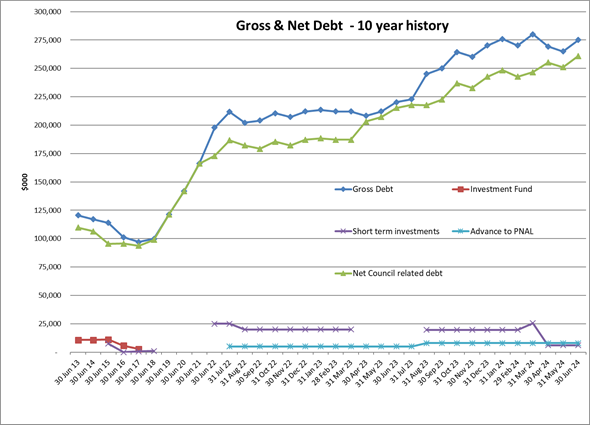
3.7 Actual
finance costs incurred by the Council depend on the actual debt levels and the
interest rate. During the 12 months gross finance costs (including
interest, line fees and the effects of payments relating to swaps) amounted to
$11.73m compared with the budget for the year of $9.9m.
3.8 $923k
of this expense relates to $20m raised on 14 August 2023 to prefund debt maturing
on 15 April 2024 and $6m raised on 11 March 2024 to fund debt maturing on 15
September 2024. This was offset by unbudgeted interest income of $925k
received from short term investment of $25.5m. A further $374k of this
expense relates to the $8m of loans raised on behalf of Palmerston North
Airport Limited (PNAL) and this was offset by $396k received from PNAL for the
advance.
3.9 Deducting
interest income from the gross interest expense of $11.73m means a net interest
expense year of $9.76m compared with the annual budget of $9.9m.
3.10 The
effective weighted average interest rate for the year is 4.64% compared with
the budgetary assumption of 4.2%.
3.11 The
Council has entered financial instruments related to its debt portfolio
utilising swap trading lines established with Westpac, ANZ and BNZ. The
details of these are shown in Schedule 2 attached.
The value of these instruments is measured in terms of its
‘mark-to-market’, i.e. the difference between the value at which
the interest rate was fixed and the current market value of the
transaction. Each of these transactions was valued at the date they were
fixed and again at the reporting date. Financial reporting standards
require the movement in values to be recorded through the Council’s Statement
of Comprehensive Income (Profit & Loss Account). They have been
revalued as at 30 June 2024. The latest valuation is an asset of $9.35m
compared with an asset of $11.7m as at 30 June 2023.
3.12 The
Council’s Treasury Policy contains guidelines regarding the measurement
of treasury risk as follows:
· Funding and
liquidity risk is managed by the Council maintaining a pre-set portion of its
debt in a range of maturity periods, e.g. < 3 years, 3 - 7 years, 7 years
+.
· Interest
rate risk is managed by the Council maintaining the ratio of debt that is
subject to floating versus fixed interest rates within pre-set limits.
3.13 The
position compared to the policy is illustrated in the graphs in Schedule 3 attached.
3.14 The
funding and liquidity risk position can be summarised as follows:
· Council’s
liquid position complies with policy.
· Since 1 July
2023 $75m of term debt has been raised and $3.3m of bank debt and $20m of term
debt has been repaid. In addition, $3.1m was raised on behalf of PNAL and
$3m on-lent to them.
3.15 The
interest rate risk position describes the portion of the overall forecast debt
that is fixed versus floating and can be summarised as follows:
· There is
significant uncertainty about forecast levels of future debt – this very
much depends on a number of factors including future Council decisions on the
proposed capital expenditure programme, the future structure for the provision
of three waters and the extent of external funding able to be organised from
other arrangements.
· Throughout
2023/24 our risk management strategy was initially based on the forecast debt
figures from the 2021-31 Long-Term Plan, as updated through the 2022/23 &
2023/24 Annual Budgets.
· As the year
progressed the debt forecasts for the draft of the Long-Term Plan were used and
these were modified once the final Long-Term Plan was developed and
adopted. Policy compliance at 30 June 2024 is therefore based on the debt
forecasts in the adopted long-Term Plan.
3.16 The
Treasury Policy also contains requirements in relation to counterparty credit
risk – this relates to investments and financial risk management
instruments. A new $20m forward start swap agreement was entered on 11
March fixing interest rates for this sum at 3.99% from 2025 to 2029.
The position as at 30 June 2024 is shown in Schedule 4 attached.
3.17 Council’s
credit lines with the banks include a $18m three-year credit facility with
Westpac Bank (maturing 31 October 2025) and a revolving $25m three-year
facility with ANZ Bank (maturing 31 March 2027).
4. CONCLUSION AND NEXT STEPS
4.1 Gross
finance costs for the year to 30 June (including interest, line fees and the
effect of swaps) was $11.73m compared with budget for the year of $9.9m.
The net finance cost (after considering the interest income from term
investments and the advance to Palmerston North Airport Ltd) is $9.76m compared
with the budget of $9.9m.
4.2 In
conjunction with Council’s treasury advisors hedging instruments are
regularly reviewed in an effort to ensure the instruments are being utilised to
best advantage as market conditions change. The level of hedging cover is
also reviewed as the forecasts of future debt levels are revised.
4.3 Council’s
borrowing strategy is continually reviewed, in conjunction with Council’s
treasury advisors, to ensure best advantage is taken of Council’s quality
credit rating.
4.4 A
further performance report will be provided after the September 2024 quarter.
5. Compliance and administration
|
Does the Committee have
delegated authority to decide?
|
Yes
|
|
Are the decisions significant?
|
No
|
|
If they are significant do they
affect land or a body of water?
|
No
|
|
Can this decision only be made
through a 10 Year Plan?
|
No
|
|
Does this decision require consultation
through the Special Consultative procedure?
|
No
|
|
Is there funding in the current
Annual Plan for these actions?
|
Yes
|
|
Are the recommendations
inconsistent with any of Council’s policies or plans?
|
No
|
|
Contribution to strategic
direction and to social, economic, environmental and cultural well-being
|
Managing the Council’s
treasury activity is a fundamental component of day to day administration of
the Council.
|
|
|
|
Attachments
|
1.
|
Schedules
1 - 4 ⇩ 
|
|
Memorandum
TO: Strategy
& Finance Committee
MEETING DATE: 14
August 2024
TITLE: City
Planning Priorities and 3-Year Work Programme
Presented
By: Jono
Ferguson-Pye, City Planning Manager
APPROVED BY: David
Murphy, General Manager Strategic Planning
RECOMMENDATION(S)
TO Strategy & Finance
Committee
1. That the
Committee receive the memorandum titled ‘City Planning Priorities and
3-Year Work Programme’ presented to the Strategy & Finance
Committee on 14 August 2024.
1. ISSUE
1.1 The
city vision is – big city ambition small city benefits. The
challenge facing the Council is how do we best plan, fund and deliver on big
city ambition while retaining small city benefits – compact urban form,
connectivity, accessibility, convenience, equity and affordability for our
community.
1.2 In
responding to the city vision, the Council faces challenges in balancing
increasingly complex issues, national direction, meeting statutory obligations,
working within budgets, and growing internal capability, whilst also making
progress on rezoning proposals and maintaining District Plan responsiveness.
1.3 The
purpose of this report is to:
· Outline
the 3 key priorities that have shaped the City Planning team 3-Year Work
Programme (included as Attachment 1), being:
i. Planning for
growth
ii. District Plan
effectiveness
iii. Rebuilding planning
practice and internal capability
· Provide
an overview of the key challenges and opportunities associated with delivering
the City Planning team Work Programme over the next 3 years.
2. BACKGROUND
2.1 This
memorandum and the attached 3-year Work Programme has been prepared to give
effect to:
· The
RMA 1991 and associated National Policy Statements;
· The
2024-34 Long Term Plan;
· The
Future Development Strategy and Infrastructure Strategy; and
· The
Oranga Papaioea City Strategy and relevant plans.
2.2 The
3-year Work Programme included in Attachment 1 is specific to the core RMA 1991
land-use planning function of the Council. The City Planning team also has
broader functions regarding transport planning under the Land Transport
Management Act 2003 and Local Government Act 2002, e.g. the Manawatū
Regional Freight Ring Road Business Case and associated PNITI programme
(approximately 70 projects).
3. city
planning priorities
Priority
One: Planning for Growth
3.1 Post
the completion of the Sectional District Plan Review (SDPR) in 2019, the focus
of the City Planning Work Programme for the last 5 years has been on enabling
urban growth. The following is a summary of key growth focused planning
processes being managed over this period:
|
Plan Change E: Roxburgh Crescent
Plan Change F: Ashhurst
Plan Change H:
Kākātangiata
Te Utanganui Master Plan
Plan Change C: Kikiwhenua
Plan Change 19: Hokowhitu Lagoon
Development Contributions Policy
Developer Agreements
PNITI
|
Plan Change G: Aokautere
Plan Change I: MDRZ &
Multi-Unit
Plan
Change N: 1st Stage Te Utanganui
Plan
Change: Matangi Residential Area
Housing
& Business Needs Assessment
Notice
of Requirement for KiwiRail Freight Hub
Future Development Strategy
Private Plan Change: 160 Napier
Road
Notice of Requirement for Te Ahu
a Turanga Tararua Manawatū Highway
|
3.2 Many of the growth
plan changes referred to above, Plan Changes E, F, G, H, I and N, are ongoing
and part of the City Planning Work Programme. Progressing this package of
growth plan changes is critical to Council meeting its statutory obligations
under the National Policy Statement for Urban Development (NPS-UD).
3.3 NPS-UD and Signals from Government –
signals from Government indicate our statutory obligations regarding land
supply and enablement of development opportunities will increase over the coming
3 years. Changes signalled include:
· Establishment of growth targets for Tier 1 and 2 Councils.
· A strengthening of intensification provisions in the
NPS-UD.
· The requirement to have ‘live zone’ development
capacity to provide at least 30 years of housing demand at any one time.
3.4 These changes will
likely have a flow on impact on the resources needed to meet ongoing NPS-UD
data monitoring obligations, the review of the Housing and Business Needs
Assessment and Future Development Strategy, and implementation within the
District Plan via zone changes.
3.5 While much of the
current NPS-UD requirements and signalled NPS-UD requirements require the
Council to produce useful material which assists the overall planning process,
we do operate in a resource constrained environment. The reality is the various
NPS-UD requirements do not result in the actual rezoning of land and can, at
times, act as a distraction to the processes that will make a difference on the
ground.
3.6 Growth Focused Plan Changes – the City remains in a constrained space regarding
infrastructure ready land supply, particularly with respect to greenfield land
supply in the short term. The City also faces infrastructure capacity
constraints in enabling growth within the existing urban footprint.
3.7 The process of
rezoning land is complex, time-consuming, expensive and technically demanding.
It is recognised that progress has been slow and is not meeting the
expectations of Government, Council or the community. Where land has been rezoned,
infrastructure upgrades have been slow to respond and / or are reliant on third
parties such as NZTA Waka Kotahi.
3.8 Meeting
NPS-UD Obligations and Giving Effect to the Future Development Strategy
– with respect to growth, all easily developed land in the city has
already been taken up. Consequently, the increase in required resource,
evidence, budget and technical capability needed to progress Plan Changes to
provide for future projected urban growth are largely contingent on, and
influenced by, a range of complex, interrelated factors, including:
- Greenfield
areas with challenging environmental constraints requiring a complex
infrastructure response. Often having to address difficult legacy issues from
past urban development.
- Strengthened
emphasis on positive environmental outcomes resulting from regulatory
obligations (One Plan, NPSs) and heightened community expectations.
- Planning
practice that requires increasing certainty about risk and outcomes (natural
hazards, infrastructure, biodiversity, cultural and economic / funding context),
resulting in the need for a broader range and heightened level of supporting
technical evidence.
- The
growing burden associated with the evidentiary threshold expected of RMA
decision-makers.
- Challenges
associated with LTP funding assumptions moving away from development
contributions as the primary funding mechanism for greenfield development to
external funding mechanisms and / or developer agreements.
Appeal to Plan Change G – the
Council has received one notice appealing the Plan Change G: Aokautere
Residential Area decision to the Environment Court. Officers will proceed to
mediation in an effort to settle the appeal later in the year. If agreement
cannot be reached, Officers will proceed to an Environment Court hearing next
year. Note, costs associated with resolving the appeal could place pressure on
the City Planning budget in the second half of this financial year and the
first half of the next.
3.9 Reset
of Plan Change H: Kākātangiata – Officers are in the
process of resetting some of the key assumptions sitting behind Plan Change H.
This reset is looking at:
- The
funding and financing options available to support growth at
Kākātangiata in light of changes to LTP funding assumptions for
greenfield growth.
- Understanding
how available funding and financing options will shape the planning framework
needed to enable development.
- Reviewing
the extent of the proposed zone change.
- Reviewing
the extent of the proposed zone that Council may want to rezone and what
portion could be left to the market to advance private plan change
applications.
- Reviewing
the extent of control exerted through the District Plan via master planning and
associated design controls.
- Assessing
what procurement model is best placed to deliver the plan change in a timely
manner given the size and scale of the zoning proposal.
3.10 Planning
for Growth and Delivering Value – the City Planning team
is currently reviewing how the existing consultancy resource is deployed to
deliver improved value alongside a review of the broader approach to planning
practice and our organisational risk appetite. The following actions have been
put in place to derive increased value from our consultancy budget:
- Where
capability exists, increased use of internal capacity to support the technical
inputs required for plan changes.
- Review
of existing consultancy support and a pivot towards lower cost providers where
a professionally competent option is available.
- A
review of planning practice and our appetite for risk. This includes narrowing
down the scope of technical inputs to what is absolutely necessary to get
through the first schedule processes. This will mean carrying more risk,
possibly resulting in the need to backfill technical evidence post notification
and / or increased risk of Environment Court appeals.
- Development
of a project planning framework to better manage and drive efficiency of
delivery of the plan change Work Programme.
- A
review of planning practice in preparation for the next SDPR. This includes a
review of plan drafting that focuses on increased clarity and conciseness of
the objective and policy framework, and a narrowing down of matters of control
to core resource management issues.
Priority Two: District Plan Effectiveness
3.11 It is
now over 10 years since key parts of the District Plan were reviewed through
the SDPR process. What is becoming increasingly evident is that parts of the
District Plan are no longer responsive to the contemporary challenges facing
the city (e.g. growth, infrastructure constraints, climate change, urban design
implementation and changing market and community expectations).
3.12 The
table below provides decision dates for each SDPR plan change and shows that
many sections of the District Plan are due for review:
|
Sectional
District Plan Review – Decision Dates
|
|
Plan Change 1
|
Inner,
Outer & Fringe Business Zones
|
22 November 2011
|
|
Plan Change 2
|
Cliff
Protection Area
|
10 November 2011
|
|
Plan Change 3
|
General
Introduction
|
18 August 2011
|
|
Plan Change 4
|
Zoning
Anomalies
|
4 November 2011
|
|
Plan Change 5
|
Local
Business Zone
|
27 May 2013
|
|
Plan Change 6
|
Whakarongo
Residential Area
|
28 August 2014
|
|
Plan Change 7
|
Roading
Hierarchy
|
25 March 2013
|
|
Plan Change 9
|
Industrial
Zone
|
20 June 2013
|
|
Plan Change 10
|
Designations
|
12 September 2013
|
|
Plan Change 11
|
Institutional
Zone
|
11 March 2014
|
|
Plan Change 13
|
Cultural
& Natural Heritage
|
17 November 2014
|
|
Plan Change 15
|
Rural
Zone, Rural Subdivision, North East Industrial Zone and Extension Area, Braeburn
Industrial Area (Longburn), Utilities and Airport Zone
|
22 August 2016
|
|
Plan Change 17
|
Hazardous
Substances
|
4 February 2015
|
|
Plan Change 19
|
Caccia
Birch
|
28 May 2015
|
|
Plan Change 20
|
Residential
Zone and Subdivision Section
|
22 December 2016
|
|
Plan Change 21
|
Reserves,
Central Energy Trust Arena, Awapuni Racecourse and Associated Race Training
Facilities
|
26 April 2017
|
|
Plan Change 22
|
Omnibus
Introduction,
Information Requirements, Monitoring, Signs, Noise, Subdivision, Land
Transportation, Natural Hazards
|
14 December 2018
|
3.13 District
Plan Effectiveness and Response to Urban Design Challenges –
while not prominent in written submissions, an emerging theme in the LTP forums
was concern that parts of the District Plan are no longer fit for purpose in
facilitating development in the City. A review of the District Plan is needed
that provides better clarity of desired outcomes, updated Plan architecture and
drafting practice.
3.14 Recent
meetings with the development community regarding urban design and Residential
Zone subdivision controls not being fit for purpose is indicative of broader
concerns about the responsiveness of the District Plan to meet the needs of the
City.
3.15 In the
last decade we have seen positive change in the quality of urban development
delivered in the City. However, at times this change has been a source of
frustration for the development community and an appropriate balance is
required.
3.16 A
balanced response to resolving these issues needs to consider the following
elements of the planning process:
- The
need for the District Plan to be reviewed so that it is responsive to the needs
of development and the community;
- The
need to review District Plan administration so that interpretation of the Plan
is consistent, clear and timely; and
- The
need to review the quality of applications made for land use consent under the
District Plan so that they are fit for purpose.
3.17 Resolving
Urban Design Challenges – the City Planning
team’s role in resolving these challenges relates to reviewing of the
District Plan and examining how we can rebalance the urban design element of
the District Plan in a way that provides increased clarity and certainty for
development.
3.18 Separate
from the review of the District Plan, resolving urban design challenges also
relates to the way in which the District Plan is administered by the Resource
Consent team. The City Planning and Resource Consents team are jointly
reviewing current practices to develop an integrated response across both
teams.
3.19 In terms
of the City Planning team response to resolving urban design challenges, there
are two key steps:
Step 1: Proposed Plan Change I (PPC: I)
3.20 Part of
the purpose of PPC: I is to review and reset how urban design outcomes are
enabled by the District Plan. PPC: I’s primary purpose is to introduce a
Medium Density Residential Zone (MDRZ) within the City’s existing
Residential Zone.
3.21 The
draft development framework being developed for the MDRZ is looking to simplify
the process for medium density development within the new Zone by enabling up
to 3 units as a permitted activity and requiring land use consent when
development exceeds this threshold. This approach would be consistent with Tier
1 cities across the country. Note, PPC: I development standards and thresholds
for development are in draft form at this time and may be subject to change.
3.22 The secondary purpose of PPC: I is to adopt a consistent approach to
intensification across the city by reviewing the existing Multi Unit Housing
(MUH) provisions in Residential Zone of the District Plan. The review of MUH by
PPC: I has also been driven by issues raised by the development community about
the workability and clarity of the urban design elements of the MUH provisions.
3.23 It is noted that part of the development of PPC: I has involved
discussions with key developer agents about both the workability of the
development framework being created for the MDRZ and the review of MUH
development provisions.
Step 2: Initiating the next Sectional District
Plan Review
3.24 Part of
the City Planning Work Programme is the initiation of the SDPR. As discussed,
it is now over 10 years since key parts of the District Plan were reviewed and
parts of the Plan are no longer fit for purpose. A key focus of the SDPR will
be reviewing the way in which urban design is incorporated within the District
Plan, building on the approach developed by PPC: I.
3.25 The City
Planning Work Programme (see Attachment 1) identifies 5 SDPR plan changes being
initiated over the 3 years of this LTP. The City Planning team has started SDPR
Plan Change: 1, which is a review of the Designations section of the District
Plan. Staff are currently working on what sections of the Plan should be
prioritised for SDPR Plan Changes 2-5.
3.26 Delivering
on National Direction – National Planning
Standards (Planning Standards) were introduced in 2019. Given the proposed planning
reform of the last Government, a decision was made to delay the implementation
of the Planning Standards. There is now a pressing need to update the District
Plan to meet these standards (including a required e-Plan) given the requisite
compliance timeframe.
3.27 The
District Plan and planning practice within the organisation is now generally
out of step with other territorial authorities across the country, many of whom
have implemented the Planning Standards in whole or are incrementally staging
progress towards compliance.
3.28 While
implementation of the Planning Standards is mandatory and therefore needs to be
resourced accordingly, unfortunately they are somewhat of a distraction as they
do not assist with addressing the key city planning issues facing the City such
as providing additional capacity for housing and industry. The Planning
Standards require the Council to address administrative matters such as the
colours and names of zones and the use of standard definitions.
3.29 The NPS-UD
requires Council to plan for urban growth for both housing and business. The
NPS-UD includes obligations to gather data, monitor, quarterly reporting,
development of an HBA, preparation of an FDS and ensure our urban growth Work
Programme is aligned to these NPS-UD related outputs.
3.30 There is
now a heavy economic data capture and analysis component relating to NPS-UD
reporting, with the work demands associated with delivering this now requiring
significant staff resource.
3.31 Alongside
this work it will be important the Council closely monitors the
Government’s intention for more widespread reform of the RMA 1991. It is
unclear at this stage whether a complete replacement of the RMA 1991 is a
likely outcome in the next 5-10 years. Much of the current reform is aimed at
quick responses to current issues identified by the Government, e.g. changes to
the NPS-UD, NPS Highly Productive Land and NPS – Freshwater. The process
for making changes to NPS documents is also being expediated. This signals that
the Government see changes to NPS documents as the most efficient way of
driving change quickly.
Priority Three: Rebuilding Planning Practice
3.32 The SDPR
(2009-2019) successfully delivered a second-generation Plan, while largely
avoiding Environment Court appeals. The team over this period was settled and
anchored by a group of experienced planners. Post the completion of the SDPR
some senior staff left the organisation for other opportunities. Since this
time the City Planning team has struggled to attract and retain senior staff,
while the size and complexity of the Work Programme, including its associated
evidential base and quality of outputs delivered, has increased. The
consequence has been a gradual erosion of the capability of planning practice.
3.33 To address
this the City Planning team are taking steps to rebuild planning practice in
the following areas:
· Developing a
project planning framework to better manage and drive efficiency of delivery of
the Work Programme.
· Building
professional practice capability by partnering experienced planning
practitioners with less experienced staff to provide mentoring and a safe
learning environment.
· A project to
rehouse the District Plan to meet statutory obligations required by National
Planning Standards and a move towards up to date plan drafting practice.
· Procurement of an
e-Plan to ensure compliance with Planning Standards and increased
administrative efficiency.
· Working closely
with the Resource Consent team to develop an integrated response to planning
issues across District Plan development and District Plan administration and
building a culture of planning excellence within the Council.
4. NEXT
STEPS
4.1 Implement
the City Planning priorities and 3-year Work Programme, working closely with
Elected Members during the development of District Plan changes.
5. Compliance
and administration
|
Does the Committee have
delegated authority to decide?
If Yes quote relevant clause(s)
from Delegations Manual
|
Yes
|
|
Are the decisions significant?
|
No
|
|
If they are significant do they
affect land or a body of water?
|
No
|
|
Can this decision only be made
through a 10 Year Plan?
|
No
|
|
Does this decision require
consultation through the Special Consultative procedure?
|
No
|
|
Is there funding in the current Annual
Plan for these actions?
|
No
|
|
Are the recommendations
inconsistent with any of Council’s policies or plans?
|
No
|
|
The recommendations contribute
to:
Whāinga 1: He tāone
auaha, he tāone tiputipu
Goal 1: An innovative and
growing city
|
|
The
recommendations contribute to the achievement of action/actions
in:
15.
Mahere whare
15. Housing Plan
The action is meet legislated
standards and requirements for land-use planning.
|
|
Contribution to strategic
direction and to social, economic, environmental and cultural well-being
|
Focusing the City Planning
team’s Work Programme on planning for growth, District Plan
effectiveness and rebuilding planning practice and internal capability will
ensure Council meets its statutory obligations under the NPS-UD for housing
and meet legislated standards in respect of land-use planning practice.
|
|
|
|
Attachments
|
1.
|
City
Planning Team 3-Year Work Programme 2024-2027 ⇩ 
|
|
Memorandum
TO: Strategy
& Finance Committee
MEETING DATE: 14
August 2024
TITLE: Palmerston
North City District Plan: Proposed Plan Change E: Roxburgh Residential Area
Presented
By: Jono
Ferguson-Pye, City Planning Manager and Andrea Harris, Technical Principal -
Planning, WSP
APPROVED BY: David
Murphy, General Manager Strategic Planning
RECOMMENDATIONS TO
Strategy & Finance Committee
1. That the Committee
approve the Palmerston North City District Plan: Proposed Plan Change E –
Roxburgh Residential Area (Attachment 1) for public notification under clause
5, schedule 1 of the Resource Management Act 1991.
2. That the
Chief Executive prepare a public consultation document for part of the Council
owned land at 22 Roxburgh Crescent to be classified as Recreation Reserve, and
the balance part to be classified as Local Purpose (Road) Reserve, pursuant to
section 14 of the Reserves Act 1977, and for this consultation to be undertaken
in parallel with the public notification of the Palmerston North City District
Plan: Proposed Plan Change E – Roxburgh Residential Area.
1. ISSUE
1.1 The
purpose of this memorandum is to seek approval for Palmerston North City
District Plan: Proposed Plan Change E – Roxburgh Residential Area (Plan
Change E) to proceed to public notification. Plan Change E seeks to rezone the
area at Roxburgh Crescent from industrial, recreation and conservation and
amenity to residential and recreation. Rezoning this area will provide up to an
additional 105 homes. The rezoning also facilitates a wide River accessway with
land gained from an exchange with Waterloo Reserve.
1.2 Plan
Change E has been prepared to ensure it gives effect to the National Policy Statement
for Urban Development (2020) and the 2023 Housing and Business Needs Assessment
by providing options for different housing typologies through the District
Plan.
1.3 The
proposed zoning changes are shown below:
Figure 1: Proposed zone changes
1.4 Plan
Change E also proposes to vest a piece of Council owned land at 22 Roxburgh
Crescent. Vesting this piece of land for road and reserve purposes will provide
for land to be used as an accessway and carpark in addition to land gained via
a reserve exchange with Waterloo Park.
1.5 To
vest the Council owned land for road and reserve purposes, a consultation
process under the Reserves Act 1977 and a Council decision is required to
enable the vesting. Council approval is required to prepare a consultation
document and commence public consultation on this proposal.
2. BACKGROUND
2.1 In
2018 the main landowner at Roxburgh Crescent approached Council with the idea
of rezoning the area to residential. The Roxburgh Crescent area was identified
for growth in the 2018 Long Term Plan. Since 2018, the plan change has gone
through the master planning and design process, production of a structure plan,
a reserve exchange process and completion of all technical reports to inform
the plan change.
2.2 The
present Industrial Zone is anomalous. PN City Council has identified preferred
locations for industrial activity to the north and west of the city. The pocket
of industrial activity at Roxburgh Crescent detracts from the residential
character of Hokowhitu and the amenity value of the river corridor.
2.3 The
2023 Housing Business Needs Assessment states we need 3,993 homes over the
short – medium term (next 10 years) and this plan change is expected to
help meet these targets. The assessment also shows that there is a strong
demand for homes within the existing City boundary and need for opportunities
within the District Plan to provide for housing choice and ability to build at
different heights and densities.
2.4 The
proposed changes contained in Plan Change E aim to provide smaller lot sizes
with a minimum lot size of 250m2 and ensure efficiency through a
maximum lot size of 500m2. The proposed plan change also creates the
opportunity to build up to three stories along the stop bank as a permitted
activity.
2.5 Plan
Change E seeks to amend and add new provisions to section 4 (definitions),
section 7 (Subdivision) and Section 10 (Residential) of the District Plan. The
proposed development of the area will be guided by a structure plan (see Figure
2 below). The attached Plan Change documentation and Section 32 report
contains a more detailed description of Plan Change E and evidence supporting
it.
3. Description of the plan change

Figure 2:
Proposed structure plan
3.1 Consultation:
Plan Change E has gone through two rounds of pre-consultation in late 2022
and late 2023, including letters with information, opportunity to submit
feedback and an invitation to a drop-in session. Information about Plan Change
E has also been available on the website. Rangitāne o Manawatū have
also been consulted throughout the process going back to 2019. This meets our
consultation requirements under Clause 3 and 4A of the Resource Management Act
1991.
3.2 Structure
Plan: The structure plan development for Plan Change E has been
underway since 2020. A structure plan was consulted on with the community in
2022 and changes were made to height and density locations as a result of
feedback and stormwater constraints. The final structure plan has been developed
on community feedback and input from technical experts. The structure plan aims
to guide future development of the Proposed Roxburgh Residential Area through
the District Plan and supporting provisions.
3.3 A
road corridor is proposed within the structure plan and supporting cross
sections to be included in the District Plan. A narrower road corridor is
proposed throughout the RRA plan change due to the existing street environment
and requirement for biofiltration devices in the road corridor. The narrower
road also allows the maximum housing yield to be achieved from the site.
Details regarding final road design and width will be finalised at the time of
subdivision.
3.4 While
initial development can occur without the immediate upgrade of Roxburgh Crescent,
a roading upgrade will be required to respond to later development stages. It
is anticipated that a programme for this will need to be put forward to the
2027-37 LTP and be funded via development contributions or a targeted rate. If
the upgrade is required before the next LTP, a programme could be considered as
part of an Annual Budget. A developer agreement is an alternative funding
option, but this could be difficult to achieve given the number of landowners
within Roxburgh Crescent. If the roading upgrade is completed by the Council
after the initial subdivision and development, a developer agreement may still
be required to ensure a contribution is received from all landowners who
benefit from the upgrade.
3.5 Waterloo
Reserve Exchange: Reserve land gained from the Waterloo Reserve
Exchange will facilitate the open space and wider River access shown as C on
the structure plan. Following consultation, Council voted to ask the Minister
of Conservation to approve the exchange in December 2023. An application was
prepared by Council Officers in January 2024 and was lodged with the Department
of Conservation (DoC). Confirmation that the reserve exchange was approved by
DoC was received by Council on 16 July 2024. The approval was subject to the
following conditions:
a. That the Council approve
a district plan change which changes the zoning of the Exchange Land to
residential; and
b. That the Land Regulatory
Delivery Manager, Department of Conservation, approve the survey plan defining
the Exchange Land. Acknowledging that minor amendments may be required, the
plan shall substantially reflect the layout shown in Appendix A, as provided
with the application; and
c. That the survey plan
gets approved by Land Information New Zealand.
4. CLASSIFICATION of Council owned land
4.1 Council
own a strip of land at 22 Roxburgh Crescent. This land has been owned by
Council since 1936 and was part of a larger area of land that was purchased by
Council by way of a mortgagee sale. The land was not purchased for a particular
purpose and has not been vested or classified as reserve.
4.2 Parts
of the larger area of land have been sold since 1936, however this strip of
land remains owned by Council. This strip of land currently runs through
privately owned land. It is used by the private landowner to access their land
and is used by Council and the community for events held within the recreation
and walkway area along the river (e.g. Relay for Life). This piece of land is
not accessible by the public except on a case-by-case booked event basis and is
gated off at each end.
4.3 Currently,
Council arranges with the owner of the land surrounding this area, who also
owns the gates at either end of the strip of land, to open the gates when
required for public or community events. The wider rezoning of Roxburgh
Crescent means that this strip of land needs to be disposed of/sold or
classified for a purpose. The preference is for the land to be classified for
specific purposes, as part of the development of the wider area of land.
4.4 The
intention would be to utilise part of the strip of land for a river area
accessway (which would be classified as recreation reserve) and the balance of
the strip of land to be utilised for road purposes (see Figure 3).
4.5 Part
of the road reserve portion would be used as a carpark to cater for users of
the new River entrance. To enable this, Council would enter an agreement with
the developer to incorporate the intended outcomes into the new roading design
in accordance with the proposed cross section for area D on the structure plan.
4.6 There
is no developer agreement in place at present, but the landowner has agreed to
this in principle and there are rules in the proposed plan change to ensure
this outcome is achieved.
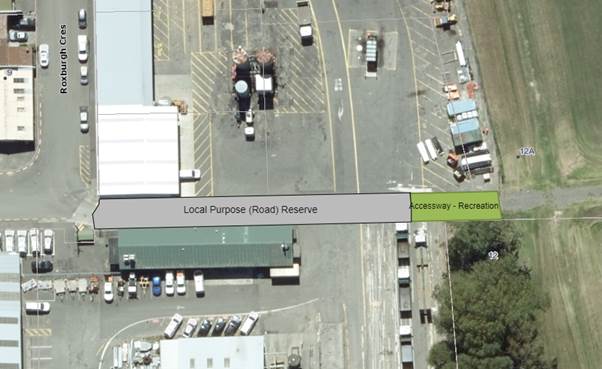
Figure 3:
Portion of land at Roxburgh Crescent owned by PN City Council and proposed
classification
4.7 To
achieve this Council would need to classify parts of the Council Land for
reserve and road purposes. This can be achieved by classifying part of the land
as Local Purpose (Esplanade Reserve) (zoned recreation) and the remaining land
as Local Purpose (Road) Reserve. The steps to achieve this are:
Step 1 – Classification of
Council Land as Reserve
· Section
14 of the Reserves Act 1977 requires consultation to be completed to classify
the land as reserve – part to be classified as Local Purpose (Esplanade
Reserve), and part to be classified as Local Purpose (Road) Reserve. Provided
that Council resolve the recommendation to proceed with public consultation,
Council will consult on the classification proposal in parallel with Plan
Change E.
· If
Council wish to proceed with the classification proposal after consultation is
completed, the classification can be achieved by way of resolution of Council,
which can be registered by gazette notice.
· A
surveyor would need to prepare a plan which separates the two areas of the
strip of land proposed to be classified as different types of reserve.
Discussions with Council’s Survey Officer have indicated that the
classification of one part of the land as Local Purpose (Esplanade Reserve) and
the other part as Local Purpose (Road) Reserve, can be recorded in one survey
office plan.
Step 2 – Dedicate the Local
Purpose (Road) Reserve as road
· Once
step 1 is completed, Council can consider dedicating the area classified as
Local Purpose (Road) Reserve as road under section 111 of the Reserves Act. The
timing of this would likely be completed at the same time as the surrounding
roads located within the development are vested with Council.
· Section
111 of the Reserves Act process requires a resolution of Council to be passed
confirming the dedication of the Local Purpose (Road) Reserve as road, which
can then be lodged with Land Information New Zealand for registration.
4.9 Both
the proposed road and recreation reserve land will remain in Council ownership.
5. NEXT STEPS
5.1 Notify
Plan Change E for submissions under the Resource Management Act 1991.
5.2 Consult
on the classification of the strip of land as recreation reserve and Local
Purpose (Road) Reserve at 22 Roxburgh Crescent and run the Reserves Act
consultation process parallel to the plan change.
6. Compliance and administration
|
Does the Committee have
delegated authority to decide?
If Yes quote relevant clause(s)
from Delegations Manual
|
Yes
|
|
Are the decisions significant?
|
No
|
|
If they are significant, do they
affect land or a body of water?
|
No
|
|
Can this decision only be made
through a 10 Year Plan?
|
No
|
|
Does this decision require
consultation through the Special Consultative procedure?
|
No
|
|
Is there funding in the current Annual
Plan for these actions?
|
Yes
|
|
Are the recommendations
inconsistent with any of Council’s policies or plans?
|
No
|
|
The recommendations contribute
to:
Whāinga 1: He tāone
auaha, he tāone tiputipu
Goal 1: An innovative and
growing city
|
|
The
recommendations contribute to the achievement of objectives
in:
15.
Mahere whare
15. Housing Plan
The objectives are:
· Implement the
National Policy Statement on Urban Development Capacity
· Rezone Roxburgh
Crescent
|
|
Contribution to strategic direction
and to social, economic, environmental and cultural well-being
|
Proposed Plan Change E will
assist Council in meeting its obligations to ensure there is sufficient
development capacity to meet projected demand, which will assist with
improving housing affordability and being responsive to growth.
|
|
|
|
Attachments
|
1.
|
Proposed
District Plan Change E: Roxburgh Residential Area and Section 32 Evaluation
(attached separately) 
|
|
Memorandum
TO: Strategy
& Finance Committee
MEETING DATE: 14
August 2024
TITLE: Statutory
review of the Signs and Use of Public Places Bylaw 2015 (s155 LGA determination
report) and initiation of the review of the Policy for the Use of Public Space
2019
Presented
By: Ann-Marie
Mori, Policy Analyst and Stacey Solomon, Policy Analyst
APPROVED BY: David
Murphy, General Manager Strategic Planning
RECOMMENDATION(S)
TO COMMITTEE
1. That the Strategy
& Finance Committee receive the findings in the ‘Palmerston North
Signs and Use of Public Places Bylaw 2015 Review - Section 155 Determination
Report’ included as Attachment 1 to this report.
2. For the purpose of
meeting the requirements of s.155(1) of the Local Government Act 2002 (LGA),
the Committee agree:
a) the
perceived problem is that the shared use of Council-controlled public places in
Palmerston North can create health, safety, nuisance, and accessibility issues;
b) a
bylaw response is the most appropriate way to address the perceived problem;
and
c) that
the statutory review of the Palmerston North Signs and Use of Public Places
Bylaw 2015 required by s.155(1) of the LGA is complete.
3. That the Chief
Executive prepare further advice for the Committee on amending the current
Bylaw for consultation approval, including the determinations needed to meet
the requirements of s.155(2) (a) and (b) of the LGA.
4. That the Committee
note the initial stages of the Policy for the Use of Public Space 2019 review
will be done alongside the review of the Palmerston North Signs and Use of
Public Places Bylaw 2015.
1. ISSUE
1.1 This
report provides Palmerston North City Council (‘Council’) with the
information it requires to make a determination under s.155(1) of the Local
Government Act 2002 (‘LGA’). The determination is that a bylaw is
the most appropriate way to address the perceived problem.
1.2 The
perceived problem is:
· The shared use
of Council-controlled public places in Palmerston North can create health,
safety, nuisance, and accessibility issues.
1.3 The
LGA requires a statutory review of the Palmerston North Signs and Use of Public
Places Bylaw 2015 within ten years of it last being reviewed (s.160(1)).
The Bylaw was last reviewed in August 2014. The Bylaw will automatically be
revoked on 25 August 2026 if the Council does not make a determination on the
perceived problem.
1.4 Following
the statutory review (highlighted in yellow) a summary of the next steps of the
Bylaw process is:


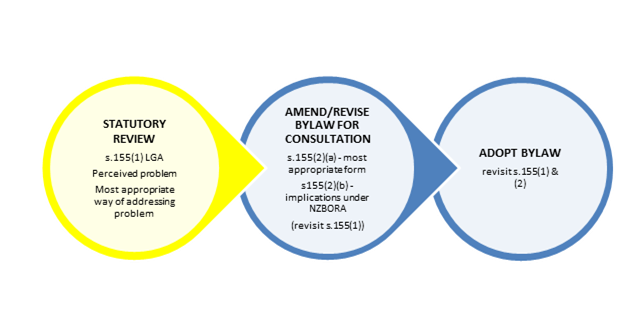
1.5 This
report should be read in conjunction with Attachment 1, ‘Palmerston North
Signs and Use of Public Places Bylaw - Section 155 LGA Determination
Report’, which provides further evidence to inform the recommendations.
1.6 The
Policy for the Use of Public Space was adopted
by Council in 2019. Completing the initial
stages of the Policy review alongside the Bylaw will enable a more joined-up
approach to addressing the various issues identified.
2. BACKGROUND
Signs and Use of Public Places Bylaw
2.1 Council
is empowered to make bylaws to mitigate nuisance and to protect, promote, and
maintain public health and safety (s.145(a), (b) LGA) and to regulate trade
(s.146(1)(a)(vi) and (1)(b)(vi) LGA). The Council has chosen to regulate (in
part) the placement of specific types of signs, and a range of other uses of
public places.
2.2 The
Bylaw forms part of a wider approach to regulating and managing the use of
public places. The other main method of regulating the use of public places are
the provisions in the District Plan.
2.3 In
addition to the provisions in the Local Government Act 2002, the current Bylaw
is made under the Prostitution Reform Act 2003 (for signs advertising
commercial sex services), the Land Transport Act 1998 (for stock grazing on
road reserves), and the Health Act 1956 (for the protection of public health
and abating nuisance).
2.4 The current Bylaw has multiple purposes, and seeks to:
a) Protect the public from nuisance
and maintain the amenity of Palmerston North City[1]
b) Protect, promote, and maintain public health and safety[2]
c) Regulate trading in public places[3]
d) Regulate, control, or prohibit
signs in public places and signs advertising commercial sexual services[4]
2.5 The Signs and
Use of Public Places Bylaw and Administration Manual 2015 are available on
the Council website.
2.6 The
Oranga Papaioea City Strategy, recently adopted as part of the Long-Term Plan
2024-34, provides the strategic direction for this Bylaw.
Our
community wellbeing goals and outcomes
Whāinga 2: He tāone whakaihiihi, tapatapahi ana
Goal 2: A creative and exciting city; and
We want
our communities to have:
· a vibrant
city that connects people, and where creativity is built into our cityscape
Whāinga 3: He hapori tūhonohono, he hapori
haumaru
Goal 3: A connected and safe community
We want
our communities to have:
· access
to safe and accessible community places
2.7 The
purpose statements in the following Plans are most relevant to the Bylaw
review:
|
Urban design plan
|
Community safety and health plan
|
|
To achieve our purpose we will:
1. Maintain and promote a connected and
well-designed urban environment
2. Provide and promote connected,
sustainable, accessible, safe, interesting, and playful public spaces
|
To achieve our purpose we will:
1. Provide environmental health services
2. Promote community health
3. Co-ordinate and support community safety
and harm reduction initiatives
|
Policy for the Use of Public Space
2.8 The
purpose of the Policy
is to provide high-level guidance and guidelines for how the Council will
consider and manage applications for the use of our city’s public space.
2.9 The
Policy is used regularly by various teams throughout the organisation,
informing how booking requests for public spaces are assessed, how we consider
and support community-led events, and how we manage, support, and enable
community projects.
2.10 The
Policy, as with the Bylaw, contributes to achieving the Goals of the Council,
specifically Goals 2 and 3 of the strategic
direction.
2.11 The Policy
further states that activities which take place in public spaces should be
consistent with other documents, bylaw controls and rules, including the
District Plan, the Resource Management Act 1991, the Reserves Act 1977, and
rules contained in the Land Transport Act 1998.
3. CONCURRENT
reviewS Of the bYLAW & THE Policy for the Use of PuBLIC Space 2019
3.1 The
Bylaw and Policy for the Use of Public Space 2019 falls within a wider system
of tools (regulatory and non-regulatory) that the Council uses to manage its
public places and spaces fairly and safely. Figure 1 (below)
demonstrates this system of tools used by the Council for public places and
spaces management.


Figure 1: Relevant parts of
PNCC’s strategic and regulatory framework that relate to public places
and public space management. Note: The Bylaw and the Policy are highlighted in
yellow. *Council does not currently have a Reserves Bylaw made under the
Reserves Act.
Relationship of the Policy to the Bylaw
3.2 While
the purpose of the Policy is to enable and encourage a diverse range of events
and activities in public space, and the Bylaw has a primarily regulatory
function, they are intended to be complementary documents.
3.3 Together
they provide Council’s main response to a range of matters concerning the
use of public space in Palmerston North. This is achieved with the Policy
guiding the types of activities the Council supports in its shared public
spaces, and the Bylaw offering a mechanism that ensures public places can be
used safely by the community, free from the risk of injury, nuisance, or harm.
3.4 There
are advantages in reviewing the Policy at the same time as the Bylaw. A
concurrent review will ensure that the two documents are strategically aligned,
and not operating independently or in contradiction of each other.
4. bylaW
review - The Perceived problem
4.1 Through
the s.155 determination review, the overall problem statement for managing the
use of public places is:
The shared use of Council-controlled
public places in Palmerston North can create health, safety, nuisance, and
accessibility issues.
4.2 For
the purposes of this determination, the perceived problem is broken down into
the four topics in the Bylaw:
|
Bylaw topic
|
Aspects
of the problem
|
|
Signs
|
Signs
can impact the amenity of public places, cause nuisance, or pose a risk to
the health and safety of the community.
There
have been 48 signs and flag signs complaints from 1 January 2020.
|
|
Use of footpaths and public places
|
Placement
of objects on public places can impact on amenity, accessibility, and
usability.
There
are 95 permit holders for tables and chairs in the City and 5 permits for
other objects.
|
|
Stock on road reserves
|
Livestock
straying or wandering on to the road can damage the road and impact on road
users.
There
have been six complaints related to stock on roads recorded over the period
2020-24.
|
|
Trading in public places
|
Mobile trading can cause damage to property or the environment, or
tension between public and private interests, and users of public places.
There
are six active mobile trading agreements for parks and reserves.
|
5. Options
ASSEssMENT for addressing the perceived problem – A summary
5.1 A
detailed options assessment for each aspect of the perceived problems (see
section 3 and Appendix 1 of the s155 report – Attachment 1) is summarised
below:
|
Aspects of the problem
|
Option 1 –
Bylaw approach
|
Option
2 –
No
bylaw approach
|
|
|
|
a) Reliance on existing legislation and other
regulatory instruments
|
b) Non-regulatory policies and guidelines
|
c) Public education and advice
|
|
Part 1 – Signs
|

|

|

|

|
|
Part 2 – Use of footpaths and public places
|

|
 
|

|

|
|
Part 3 – Stock on road reserves
|

|

|

|

|
|
Part 4 – Trading in public places
|

|

|

|

|
Key:
|

|
Not
the most appropriate way of addressing the perceived problem but this option
contributes or supports a bylaw approach
|
|

|
Complementary
way of addressing the perceived problem
|
|

|
Most
appropriate way of addressing the perceived problem
|
5.2 The
options assessment has concluded that a bylaw approach is the most appropriate
method for managing the perceived problem.
5.3 The
assessment has also shown that there are opportunities for the other options
described that contribute to addressing the perceived problem (such as the
Policy for the Use of Public Space, and the District Plan) to be updated to
support the Bylaw and the overall regulatory system.
6. Description
of options
6.1 OPTION
1: Continue with a bylaw
6.2 Option
1 is a determination by the Committee that a bylaw is the most appropriate way
of addressing the perceived problem, i.e. the shared use of Council-controlled
public places in Palmerston North can create health, safety, nuisance, and
accessibility issues.
6.3 A
bylaw approach may mean that more than one bylaw is created or that parts of
the current Bylaw are moved to a more appropriate bylaw.
6.4 If the Committee determines that a bylaw
approach is the best way to address the perceived problem, the Policy will be
reviewed concurrently to the Bylaw.
6.5 OPTION
2: Do not continue with a bylaw approach
If Council decides not to make the Option
1 determination, then there will be a further decision to make. Council could:
i. let
the Bylaw lapse
This means that the Council does nothing,
and the Bylaw expires on 25 August 2026.
ii. actively
revoke the Bylaw
If the Council wants to revoke the Bylaw
before the date on which it automatically expires, it must consult on this
decision using a s.83 (special consultative procedure) process.
7. Analysis
of options
Option 1: Continue with a bylaw approach by:
a) Determining
that a bylaw is the most appropriate way of addressing the perceived problem,
and
b) Initiate
a review for the Policy for the Use of Public Space alongside the Bylaw
7.1 If
the Committee determines that a bylaw is the most appropriate way of addressing
the perceived problem, then the Council should proceed to amend the Bylaw.
7.2 Changes
and improvements to the current Bylaw have been identified for possible
amendment, and include:
· Ensuring
the bylaw continues to be closely aligned to the vision and strategic goals of
Council as well as the enabling (primary) legislation.
· Clarifying
the relationship between the Policy for the Use of Public Space, other policies
or guidelines, and the Bylaw.
· Ensuring that
there is more clarity between the Bylaw and the District Plan and their
respective applications to public places and private property.
· Responding to
ongoing issues relevant to the specific controls of the bylaw (e.g. sign
dimensions and where you can locate them).
· Wording
and structure changes to improve readability of the Bylaw.
7.3 This
work will include consideration of other known (and unknown at this time)
problems and issues which may be suitable for inclusion in this Bylaw but have
not yet been fully assessed. These include any problems related to street
fundraising, street performing, art installations, and vehicles being driven on
reserves.
7.4 The
review of the Policy for the Use of Public Space will begin alongside work on
the Bylaw and will follow the Policy Framework process (Attachment 2).
The initial stages of the Policy review will include an opportunity for Elected
Members to decide whether to proceed with the Policy.
Option
1 is recommended.
7.5 Option
2: Do not continue with a bylaw approach by:
a) Not making the determination that
a bylaw is the most appropriate way of addressing the perceived problem;
b) Initiating
the review of the Policy for the Use of Public Space.
7.6 If
the Committee determines that a bylaw is not the most appropriate way of
addressing the perceived problem, then it should not make one. Unless a
different decision is made by the Committee or Council later, no further work
will be completed on this Bylaw and on 25 August 2026 (12 years after it was
last reviewed) it will lapse.
7.7 Should
the Committee wish for the Bylaw to be revoked earlier than the date it will
expire, a consultation process with the community will have to occur (s.156
LGA).
7.8 The
regulation of activities in public places in Palmerston North will still need
to be controlled or managed in some way. Non-bylaw solutions will need to be
further explored, such as reliance on the District Plan, or complete reliance
on the Policy.
Option 2 is not recommended.
8. Risk assessment
8.1 There
are risks associated with each of the decisions on the options described
above.
Community views
8.2 Option
1: Community views are not yet known. Community views will need to be
sought if the Council determines to continue with a bylaw approach. Seeking
community views means that the Bylaw and the Policy processes can be shaped by
feedback.
8.3 Option
2: If the Council chooses to let the Bylaw lapse, community views will
not be sought on the Bylaw. If the Council chooses to continue with the
development of the Policy, views will need to be sought. If the Council chooses
to actively revoke the Bylaw, community views must be sought through a special
consultative procedure.
Reputational
8.4 Option
1: The Council is responsible for ensuring that the public can use public
spaces safely, free from nuisance and harm. Having a bylaw that enables the
Council to provide a clear and consistent approach to regulatory enforcement is
one of the ways that Council does this. Option 1 allows the Council to
manage the expectations of the community and what they can expect from the
Council when it regulates public places.
8.5 Option
2: It is uncommon for metropolitan authorities not to have a bylaw
approach to managing public places. Without any policy to reflect the
Council’s vision for the use of its public spaces, staff would be unable
to assess applications for the use of public space in a fair and consistent
way.
Environmental
8.6 Option
1: Public places are an important way the Council provides areas for
recreation, exercise, and socialisation. Having a bylaw and a policy ensures
that the Council has some control over activities in the public place which may
have adverse environmental effects; for example, the cumulative effect of
objects cluttering footpaths can impact the amenity of the urban environment.
8.7 Option
2: Means that the Council will need to manage impacts on the environment
from the use of its public places and spaces with other regulatory and policy
tools available to it – such as the District Plan. It is less
efficient for staff to apply the rules and guidelines this way. It is also more
complex for the community.
Strategic
8.8 Option
1: A bylaw enables the Council to act under enabling legislation to
provide a safe, accessible, and nuisance free environment. The Policy
contributes to Goals 2 and 3, by clearly stating the intention of the Council
to allow trade, events, and other activities to occur in Public Spaces.
8.9 Option
2: There may be a risk that the Council does not achieve its strategic
vision, with particular reference to Goal 3, and the safety and health of the
community. Not reviewing the Policy means there is a lost opportunity to
reflect the new strategic direction of the Council, or for the Council to
respond through the Policy to new emerging trends or issues.
Financial
8.10 Bylaw and
policy reviews are within existing budgets. There are no financial risks
associated with either option.
Summary of risk
8.11 There is
less risk associated with Option 1: continuing a bylaw
approach.
9. Conclusion
9.1 Staff
recommend the Committee determine a bylaw is the most appropriate way of
addressing the perceived problem, and that work to revise and amend the current
Bylaw starts. Staff note that this determination does not commit Council to
continuing with the current form or content in the Signs and Use of Public
Places Bylaw.
9.2 If
the Committee makes the recommended resolution an amended Bylaw will be
presented to the Committee for consideration in 2025.
10. NEXT
STEPS
10.1 If
the Committee endorses the recommended option and determines that a bylaw is
the most appropriate way to address the perceived problem, the statutory review
is complete. Work to revise and amend the Bylaw will proceed.
10.2 The
Committee will need to make further determinations at a later date if it
decides to revise and amend the current Bylaw. These determinations will be put
to the Council when a proposed bylaw is presented for consultation
approval. Those determinations will be:
· That the proposed
bylaw is the most appropriate form of bylaw (s.155(2)(a) LGA); and
· That the proposed
bylaw does not give rise to any implications under the New Zealand Bill of
Rights Act 1990 (‘NZBORA’)(s.155(3) LGA).
10.3 Further
direction from Elected Members will be sought (through workshops or surveys) as
part of this process, especially to understand issues that might influence the
scope or scale of revision or change which is expected.
10.4 While
staff report that the Policy is working well, opportunities for improvement in
the Policy have been identified. Further work will be completed to determine
the potential extent of the changes, and how the Policy can more closely align
with the goals and vision of the Council, and wider system of guidelines,
controls, and regulation the Council has for the use of public space.
11. Outline of pre-consultation engagement process
11.1 Pre-consultation
engagement will occur with Council’s partners, identified stakeholders,
interested parties, and the community, to capture views and note any issues
with the current Bylaw and Policy. The list below are the groups, stakeholders,
and partners who will be engaged (the list is not exhaustive, and is in
addition to internal engagement with other staff):
· Rangitāne
o Manawatū, through Te Whiri KōKō
· Palmy
BID (Business Improvement District)
· Manawatū
Business Chamber
· CEDA
· Council-Controlled
Organisations
· Council’s
reference groups
· Youth
Council
· Safety
Advisory Board
· New
Zealand Police
· Living
Streets Aotearoa
· Real
estate companies
· Sex
industry representatives
· Mobile
traders
· Permit
holders
· Business
owners
· Electoral
Commission
· Political
parties
· Federated
Farmers
· Signage
companies
· Placemaking
Aotearoa
· Event
organisers and hosts
· The
wider community
11.2 Feedback
received during early engagement will be used to develop an options report as
the next stage of the review.
12. Compliance
and administration
|
Does the Committee have
delegated authority to decide?
|
Yes
|
|
Are the decisions significant?
|
No
|
|
If they are significant do they
affect land or a body of water?
|
No
|
|
Can this decision only be made
through a 10 Year Plan?
|
No
|
|
Does this decision require
consultation through the Special Consultative procedure?
|
No
|
|
Is there funding in the current
Annual Plan for these actions?
|
Yes
|
|
Are the recommendations
inconsistent with any of Council’s policies or plans?
|
No
|
|
The recommendations contribute
to:
Whāinga 3: He hapori
tūhonohono, he hapori haumaru
Goal 3: A connected and safe
community
|
|
The
recommendations contribute to the achievement of objectives
in:
9.
Mahere haumaru hapori, hauora hapori
9. Community Safety and
Health Plan
The objective is: The Bylaw and
the Policy are scheduled for review, which has prompted this work.
|
|
Contribution to strategic
direction and to social, economic, environmental and cultural well-being
|
Public places are used for a
wide range of activities by a range of different people. If these spaces are
not managed well, then conflicts can arise between the users and the
activities occurring in the spaces. These conflicts can result in risks to
health and safety, public nuisance or could cause damage to land or
property.
The bylaw supports the efforts
of the Council to achieve its strategic goals, particularly those related to
achieving safer communities, and connected communities.
|
|
|
|
Attachments
|
1.
|
Palmerston
North Signs and Use of Public Places Bylaw - Section 155 LGA Determination
Report ⇩ 
|
|
|
2.
|
Policy
Framework diagram ⇩ 
|
|
Report
TO: Strategy
& Finance Committee
MEETING DATE: 14
August 2024
TITLE: Approval
to consult on the draft Dangerous, Affected, and Insanitary Buildings Policy
2024
PRESENTED BY: Lili
Kato, Policy Analyst
APPROVED BY: David
Murphy, General Manager Strategic Planning
RECOMMENDATION(S)
TO Council
1. That Council
approve the draft Dangerous, Affected, and Insanitary Buildings Policy for
consultation (included in Attachment 1: Statement of Proposal – Draft
Dangerous, Affected, and Insanitary Buildings Policy 2024).
Summary of options analysis for the
draft dangerous, affected, and insanitary buildings policy 2024
|
Problem
or Opportunity
|
The Dangerous and Insanitary
Buildings Policy is overdue for review. The Policy enables a local response
to discharging Council’s legislative function to identify and remedy
buildings that fit the Building Act 2004 (the Act) definition of dangerous,
affected, and/or insanitary. The Policy is required by the Building Act 2004,
and it contributes to the Act’s objective to ensure that buildings do
not endanger the health, safety and wellbeing of the people who use them.
|
|
OPTION 1:
|
Approve the draft Dangerous,
Affected, and Insanitary Buildings Policy for consultation (recommended)
|
|
Community
Views
|
Wider community views are yet to
be sought, but engagement with stakeholders including Fire and Emergency New
Zealand (FENZ) and ‘Independent Qualified Persons’ is reflected
in the proposal.
|
|
Benefits
|
Another step towards completing a
policy review required by legislation.
Improvements to the Policy are
proposed and the community will have the opportunity to provide feedback on
these.
|
|
Risks
|
None identified.
|
|
Financial
|
None identified.
|
|
OPTION 2:
|
Do not approve the draft
Dangerous, Affected, and Insanitary Buildings Policy for consultation
|
|
Community
Views
|
Wider community views are yet to
be sought, but engagement with stakeholders including FENZ and
‘Independent Qualified Persons’ has identified potential
improvements.
|
|
Benefits
|
None identified.
|
|
Risks
|
Lost opportunity to improve the
current Policy which was adopted in 2006 and has yet to be reviewed. There
will be a risk the Council will not have a viable means in future to identify
and rectify buildings that are potentially dangerous, affected, and/or
insanitary. The opportunity to respond to suggested improvements will be
lost.
|
|
Financial
|
None identified.
|
Rationale for the recommendations
1. Overview of the problem or opportunity
1.1 The
Building Act 2004 requires local authorities to adopt a Policy that outlines
how they will go about identifying and remedying buildings within their
boundaries that fit the legislative definition of ‘dangerous’
and/or ‘insanitary’.
The purpose of this Policy is to ensure that buildings do not endanger the
health, safety, and wellbeing of the people who use them.
1.2 The
Act enables a local response to take into account the circumstances of
individual territorial authorities, recognising that economic and social
factors may have an impact on the implementation of the dangerous, affected,
and insanitary provisions of the Act. For example, in some circumstances
demolition may be the most appropriate way to remove danger from an occupied
building, yet if there is no alternative accommodation for its occupants,
Council may need to consider other forms of action consistent with the Act.
1.3 Council
fulfilled the statutory requirement in 2006 when it adopted the current
Dangerous and Insanitary Buildings Policy. The Policy confirmed a reactive
approach to identifying buildings that are dangerous or insanitary in the
city. Council relies on notice and complaints from members of the public,
and government agencies who are mandated to inspect buildings, to identify
buildings of concern.
1.4 The
Policy was due for review no later than 2011, however this was not completed.
Despite the lag in the review time the current Policy remains enforceable as
stipulated by the Act.
1.5 In
fulfilment of legislative requirements and best practice the Policy has been
reviewed and we have identified potential improvements for consultation with
the community.
2. Background and previous council decisions
2.1 In
2006 Council adopted the Dangerous and Insanitary Buildings Policy. The
Building Act 2004 s.
132 (4) requires Council to review the policy within five years of its
adoption. However, failure to review within this timeframe does not render it
ineffective as stipulated in s.
132 (5) of the Act. The current Policy was adopted alongside an
Earthquake-prone Buildings Policy, and since then the legislation concerning
earthquake-prone buildings has evolved and continues to evolve.
Earthquake-prone buildings is outside the scope of this review.
2.2 This
is the first review of the Policy since its adoption. The operations staff who
implement the Policy welcomed the review. They reported that the Policy is
outdated, and in particular later updates to the Act have yet to be included in
the Policy, such as consideration of ‘affected buildings’.
2.3 Staff
rely on complaints from the public and emergency services to identify buildings
of concern. The operations team reported that very few complaints per year are
received. Of these complaints even fewer are deemed as meeting the
Act’s definition of ‘dangerous and/or insanitary building’.
The operations team investigate every complaint they receive, and at present
most complaints are received from Fire and Emergency New Zealand (FENZ). The
operations team report that on average they deal with one identified dangerous
and/or insanitary building per year.
2.4 Below
is a high-level outline of the typical process that Council follows when
implementing the Policy:
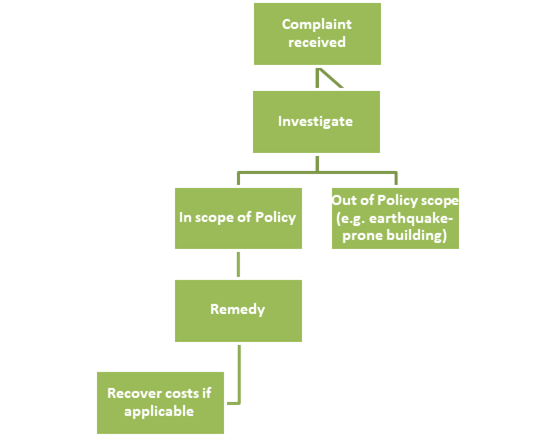
2.5 Staff
also engaged with FENZ on the review of the Policy. FENZ report a good rapport
with the implementing staff in Council and the system that is in place to
notify Council of potential dangerous and insanitary buildings is working well.
2.6 Staff
also sought input from Council’s registered ‘Independent Qualified
Persons’ (IQP), because their work involves carrying out inspections or
routine maintenance of buildings in Palmerston North and is likely to come
across buildings of concern. Little input was received from the 138 registered
IQP to the initial request for feedback.
2.7 As
there was no opportunity for a workshop with Elected Members, views were sought
through an informal written process. No additional issues were raised by
Elected Members. This report is the first report to Committee for this review
in accordance with the policy framework process.
2.8 Section
132 (2) of the Building Act requires Council to amend or replace the Policy
according to the special consultative procedure in section
83 of the Local Government Act 2002.
3. Description of options
3.1 The
primary purpose of this report is to present the Committee with a draft
Dangerous, Affected, and Insanitary Buildings Policy and to seek approval to
publicly consult on this draft. The options are to approve the draft Policy for
public consultation, or to not approve the draft Policy for public
consultation.
4. Analysis of options
Option 1: Approve
the draft Dangerous, Affected, and Insanitary Buildings Policy for consultation
(recommended)
4.1 Option
1 is the next step towards completing the policy review process and in line
with legislative requirements to publicly consult when amending or replacing
existing policy. The intent of the Policy remains the same, but improvements
have been proposed to:
- take account
of legislative requirements;
- improve
transparency and consistency; and
- update the
structure and strategic direction.
The following is a summary of the proposed changes:
Statutory requirements
4.2 The
draft Policy satisfies several statutory requirements under the Building Act
2004 which Council has yet to action since the Policy was first adopted in
2006. These include:
- Review of the
Policy under s.
132 (4). The Act requires local authorities to review its Policy within 5
years after the Policy is adopted. The first review should have been completed
before 2011. Whilst the review is overdue, it does not affect the legal
enforceability of the current Policy. This option will bring Council closer to
completing the review and fulfilling an important part of the review process,
which is to seek the views of the public on potential improvements.
- Taking
account of ‘affected’ buildings in the Policy. Section
132A of the Act requires Council to amend any existing policies to take
account of affected buildings. This means that for any building that is in
close proximity to a building that is determined as ‘dangerous’ or
to a ‘dangerous dam’, Council has the ability to determine whether
it fits the definition of ‘affected’ and to seek to mitigate any
risk if it is. The draft Policy includes provisions on ‘affected’
buildings and the name of the draft Policy has been changed to include
‘affected’ buildings.
Consistency and transparency
4.3 The
draft Policy will increase consistency and transparency in Council’s
implementation of the Act’s provisions relating to dangerous, affected,
and/or insanitary buildings. The draft Policy offers further guidance in
terms of the assessments and the factors that are considered as part of
assessments. The draft Policy states explicitly Council’s intention to keep
records of the status of buildings that have been identified as dangerous,
affected and/or insanitary. It also states that Council may decide to place the
status information on the Land Information Memorandum and the Property
Information Memorandum until the matter has been rectified.
4.4 Specifically,
the guidelines under section six (application) of the draft Policy include the
following:
- Definitions
- Identifying
dangerous, affected, or insanitary buildings
- Assessment
criteria
- Taking action
under the Building Act 2004
- Buildings of
cultural heritage value
- Recording the
status of dangerous, affected, or insanitary buildings
Structure
and strategic direction
4.5 The
draft Policy aligns with Council’s policy framework requirements. The
draft Policy includes shorter, more succinct drafting to reflect the
legislative mandate of the Policy and the strategic links to Council’s
Long-Term Plan. The main sections of the draft Policy are:
- Introduction
- Strategic
context
- Policy
purpose
- Policy
objectives
- Policy
principles
- Guidelines
- Monitoring
and review
Option 2: Do not
approve the draft Dangerous, Affected, and Insanitary Buildings Policy for
consultation
4.6 There
are no identified benefits with this option. Choosing this option would set
Council back in terms of fulfilling the legislative requirements under the
Building Act 2004 for this Policy. Council will be unable to discharge its
responsibility to identify and remedy ‘affected’ buildings as these
are not included in the current Policy.
5. Conclusion
5.1 Approving
the draft Dangerous, Affected, and Insanitary Buildings Policy for public
consultation (Option 1) is recommended. This will allow the process of
reviewing the Policy to proceed and be adopted by December 2024. Formal
consultation will provide the opportunity to receive submissions on the
proposal.
6. Next actions
6.1 If
Council approves the draft Policy for public consultation, then the Statement
of Proposal will be finalised for publication and the consultation process will
begin.
6.2 A
consultation plan will be developed and implemented providing opportunities for
feedback on the proposal.
6.3 The
proposed consultation period will run for a month over September 2024.
The hearing of submissions is planned for October 2024. A final report,
with staff advice on the issues raised by submitters and recommendations on proposed
changes to the draft Policy, will be presented to Council in December 2024 or
through the Strategy & Finance Committee in February 2025.
7. Outline of community engagement process
7.1 The
special consultative procedure will be used for consultation on the draft
Dangerous, Affected, and Insanitary Buildings Policy in accordance with section
132 (2) of the Building Act.
7.2 The
consultation document in Attachment 1 includes the Statement of Proposal and
the reasons for the proposal.
7.3 The
consultation will recognise the specific stakeholder groups who may be most
interested in providing feedback.
Compliance and administration
|
Does the Committee have
delegated authority to decide?
|
Yes
|
|
Are the decisions significant?
|
No
|
|
If they are significant do they
affect land or a body of water?
|
No
|
|
Can this decision only be made
through a 10 Year Plan?
|
No
|
|
Does this decision require
consultation through the Special Consultative procedure?
|
Yes
|
|
Is there funding in the current
Annual Plan for these actions?
|
Yes
|
|
Are the recommendations
inconsistent with any of Council’s policies or plans?
|
No
|
|
The recommendations contribute
to:
Whāinga 3: He hapori
tūhonohono, he hapori haumaru
Goal 3: A connected and safe
community
|
|
The
recommendations contribute to the achievement of objectives
in:
9.
Mahere haumaru hapori, hauora hapori
9. Community Safety and
Health Plan
The objective is: Assess and
manage risks arising from dangerous and insanitary city buildings.
|
|
Contribution to strategic
direction and to social, economic, environmental and cultural well-being
|
The recommendation will give
the community the ability to provide feedback on the way that Council
proposes to assess and manage risks arising from dangerous, affected, and
insanitary city buildings.
|
|
|
|
Attachments
|
1.
|
Statement
of Proposal - Dangerous, Affected, and Insanitary Buildings Policy 2024 ⇩ 
|
|
Report
TO: Strategy
& Finance Committee
MEETING DATE: 14
August 2024
TITLE: Reserve
Declarations and Classifications
PRESENTED BY: Aaron
Phillips, Activities Manager Parks
APPROVED BY: Chris
Dyhrberg, General Manager Infrastructure
RECOMMENDATION(S)
TO Council
1. That Council
propose to declare all land parcels contained in Appendix 1: Reserves
for Declaration and Classifications and identified in Column 5, under
Section 14 of the Reserves Act 1977, to be reserves.
2. That Council
propose to classify all reserves and land parcels identified in Column 5 of the
table contained in Appendix 1: Reserves for Declaration and Classifications,
under Section 14 of the Reserves Act 1977, to be classified as per the
classifications contained in Column 3.
3. That Council
propose to classify all reserves and land parcels identified in Column 6 of the
table contained in Appendix 1: Reserves for Declaration and Classifications,
under Section 16 of the Reserves Act 1977, to be classified as per the
classifications contained in Column 3.
4. That Council
propose to re-classify the three land parcels of Pari Reserve identified in
Column 7 of the table contained in Appendix 1: Reserves for Declaration and
Classifications, under Section 24 of the Reserves Act 1977, from Recreation
to Local Purpose: Stormwater.
RECOMMENDATION(S) TO COMMITTEE
5. That the
Committee note that the proposals contained within recommendations 1-4 above
are subject to a Section 119 and Section 120 Reserves Act 1977 consultation
process with the community; and all submitters will be offered the opportunity
to speak to their submissions as per Section 120.
6. That the
Chief Executive report back on the results of the Section 119 and Section 120
consultation with recommendations.
Summary of options analysis for
|
Problem
or Opportunity
|
Under the
Reserves Act 1977 (The Act) Council is required to declare all land acquired
for the purpose of a park or reserve, as a reserve under the Act.
Council, when declaring the land
as a reserve, is also required to establish what type of reserve the land is
being acquired for. This process is called classification under the
Act.
Currently, Council has 124
reserves, or parcels of reserve, that are not classified, some of which have
also not yet been declared to be a reserve.
These reserves must be declared
and classified prior to commencing the generic reserve management planning
process, otherwise these existing Council reserves may be excluded from the
plan when it is adopted.
|
|
OPTION 1:
|
Declare and classify the
reserves prior to the commencement of the reserve management planning process
|
|
Community
Views
|
Community views will be sought on
the proposal to declare and classify the reserves as part of the Reserves Act
process.
|
|
Benefits
|
It gives certainty to residents
on the intended future use of open spaces in their neighbourhood.
It enables Council to include all
the parks and reserves it administers within a reserve management plan.
|
|
Risks
|
If the classification of the
reserve is too restrictive, it can limit the range of activities that can
occur on the reserve in the future. This risk is low as the
classifications proposed by Officers align with the current or potential
future use of the reserve.
|
|
Financial
|
Minor costs for public
advertisement and engagement. Officer time for hearing and reporting.
|
|
OPTION 2:
|
Do not classify or declare any
further reserves
|
|
Community
Views
|
Community views would not be
sought and tested under this option.
|
|
Benefits
|
Council could proceed with the
generic reserve management planning process sooner.
The use of the unclassified
reserves would only be limited by Local Government Act (LGA) and Resource
Management Act provisions, not their Reserves Act classification.
|
|
Risks
|
Council is not complying with the
Reserves Act 1977.
The benefits of adopting the
Generic Reserve Management Plan – e.g. simpler and quicker lease
renewal process in the future, would not be extended to these 124 reserves.
|
|
Financial
|
Nil.
|
|
OPTION 3:
|
Amend
the list of the classifications proposed within Appendix 1, prior to
consulting with the community on the proposal to declare and classify the
reserves
|
|
Community
Views
|
Community views will be sought on
the proposal to declare and classify the reserves as part of the Reserves Act
process.
|
|
Benefits
|
If the Council does not support
one or more of the classifications proposed by Officers, making a change
prior to community consultation is appropriate, so that the proposal is
representative of the intentions of the Council.
|
|
Risks
|
Council is yet to seek the
community views on the proposed classifications. The community may
consider that Council is pre-empting the views of the community if changes
are made without further supporting evidence.
|
|
Financial
|
Minor costs for public
advertisement and engagement. Officer time for hearing and reporting.
|
Rationale for the recommendations
1. Overview of the problem or opportunity
1.1 Under
the Reserves Act 1977, Council is required to declare all land acquired for the
purpose of a park or reserve, as a reserve, under Sections 14 or 16 of the Act.
1.2 Council,
when declaring the land as a reserve under the above sections, is also required
to establish what type of reserve it is. This process is called
classification under the Act.
1.3 Currently
Council has 124 reserves, or parcels of reserve, that are not classified, some
of which have also not yet been declared to be a reserve. There are 3
land parcels within Pari Reserve where a change to the classification is
proposed to align with the purpose of the reserve. The list of these
reserves is contained in Appendix 1.
1.4 Council
is commencing the process of developing reserve management plans. The
reserves listed in Appendix 1 must be declared and/or classified prior to
commencing the generic reserve management planning process, or otherwise these
existing Council reserves may be excluded from the plan when it is adopted.
2. Background and previous council decisions
2.1 Officers
reported to the Culture & Sport Committee on 8 November 2023 on progress in
the development of reserve management plans for reserves administered by
Council.
2.2 It
was noted in the report that council only has an adopted Reserve Management
Plan (RMP) for Ashhurst Domain, and as such Council is not complying with
provision 41 of the Act, which requires that management plans be prepared for
reserves under the control, management or administration of Council.
2.3 The
Committee noted progress on reserve management and reserve development planning
and resolved to publicly notify its intention to review the Ashhurst Domain
Development and Management Plan under the provisions of the Reserves Act 1977.
2.4 Contained
within the report was the proposed work programme for the development of
reserve management plans, including the intention to prepare a generic reserve
management plan for all reserves that would not be covered by an individual
reserve management plan in the future.
2.5 The
planned timeline for the development of the generic reserve management plan is
2025-27. The first stage is the classification of reserves administered
by Council that are not currently classified.
3. Reserve Classification
3.1 The
Act requires all reserves to be declared as reserves, and to be classified
according to their principal or primary purpose.
3.2 The
reserve classifications contained within the Act are:
· Recreation
· Historic
· Scenic
· Nature
· Scientific
· Government purpose
· Local
purpose (esplanade/stormwater/community, etc.)
3.3 Recreation
and Local Purpose are the broadest, most permissive classifications and Scenic
and Nature are the most restrictive.
3.4 The
bulk of Palmerston North City Council’s existing classified reserves are
either Local Purpose or Recreation. It is proposed that most of the
unclassified reserves be classified under one of these two
classifications. Council generally classifies Local Purpose by types such
as Stormwater[5],
Accessway or Esplanade Reserve.
3.5 The
stormwater reserve type has a primary purpose of stormwater treatment,
retention or movement. Recreation, and in some cases ecological
restoration or management, are secondary purposes.
3.6 Some
reserves, for example the land under the Rangiora Community Centre and Opie
Reserve, are classified ‘Local Purpose: Community’ to accommodate
community activities.
3.7 There
are several reserves around the Manawatū River that were taken as
Esplanade Strips/Reserves, used for river access and recreation.
4. Description of options
4.1 Option
1: Declare and classify the reserves prior to the commencement of the
reserve management planning process
4.2 Appendix
1 contains a list of reserves (or reserve parcels) that have not been declared
and classified, and reserves that have not been classified for purpose.
It also contains three land parcels of Pari Reserve where a change of
classification is proposed.
4.3 Many
of the reserves we administer are made up of more than one land parcel.
Some single parcels within a reserve have not been classified, but need to be
to enable the whole reserve to be incorporated into the generic reserve
management plan.
4.4 Appendix
1 has been set out as a table with the following information:
· Column
1: Name of reserve
· Column
2: The type of PN City Council reserve it is – why it was taken by
Council and for what purpose
· Column
3: The proposed classification – describes the primary purpose of the
reserve
· Column
4: Classification status – classified yes or no
· Column
5: Land requires declaration as a reserve to be declared and classified under
Section 14 of the Reserves Act
· Column
6: Declaration is not required BUT does require classification to be classified
under Section 16 of the Reserves Act
· Column
7: Existing classification is proposed to be changed. Reclassification is
proposed under Section 24 of the Reserves Act
· Column
8: The legal description of the land parcel to be declared, and/or classified,
or reclassified
· Column
9: A photo and brief description of location of Council parks and
reserves listed that may be more unfamiliar to the reader.
4.5 If
Council adopts the recommendations in this report, the proposed declarations,
classifications and reclassifications will be publicly advertised in accordance
with the requirements of Sections 119 and 120 of the Act.
4.6 Once
the consultation period is complete, Council is required to hear submitters
that wish to be heard, if there are any. Officers will then produce a
report based on the consultation results and make recommendations.
4.7 Once
all reserves are declared, classified and reclassified, Officers will then
embark on the next stage of the Reserve Management planning process.
4.8 Option
2: Do not classify or declare any further reserves
4.9 This
option is a status quo option whereby Council chooses to remain non-compliant
with the Act.
4.10 124
reserves or reserve parcels will remain unclassified and will not be
incorporated into the generic reserve management planning process.
Council would not accrue the benefits of adopting reserve management plans for
these reserves.
4.11 Option
3: Amend the list of the classifications proposed within Appendix
1, prior to consulting with the community on the proposal to declare and
classify the reserves
4.12 Under
this option, amendments would be made to list of reserves in Appendix 1, mostly
Column 3, the proposed classification, before adopting the
recommendations.
5. Analysis of options
5.1 Option
1: Declare and classify the reserves prior to the commencement of the
reserve management planning process
5.2 This
option enables Council to be compliant with the provisions of the Act, i.e.
Council is required to classify the reserves it administers.
5.3 Classifying
reserves before the generic reserve management planning process commences
enables all reserves Council administers to be included within the reserve
management planning process. This includes reserves that were crown
derived and have a requirement for Ministerial approval of the reserve
management plan.
5.4 Classifying
reserves gives certainty to residents on the intended future use of open spaces
in their neighbourhood. Enabling the 124 reserves to be included in a
reserve management plan will result in a reduction in the time and cost
involved with activities in the reserves, which are consistent with strategies,
plans and policies of Council and the District Plan, e.g. leases and licences.
5.5 Option
2: Do not classify or declare any further reserves
5.6 This
option would result in Council continuing to be non-compliant with sections 14
and 16 of the Act. It would also result in Council not being able to
include 124 of the reserves it administers within the reserve management
planning process.
5.7 Under
this option, the benefits of reserve management planning described in Option 1
will not be realised for the unclassified reserves.
5.8 There
may be a perception that retaining land outside of the Reserves Act status and
classification framework may be an advantage if Council wanted to sell or
dispose of that land in the future. This is not the case as the LGA has
provision for the disposal of land defined as parks that are not held under the
Reserves Act 1977.
5.9 Section
138 of the LGA requires Council to consult on any proposal to lease park land
or dispose of it in any other manner. The consultation requirements are
essentially the same as a Reserves Act process. Not classifying a
reserve, therefore, does not make it any easier to dispose of.
5.10 Palmerston
North City Council went through a significant Property Review in 2012.
Council identified any parks and reserves that could be proposed to be disposed
of or identified for other uses. This process identified some reserves
for other options, such as the old bowling club land on the corner of Park Road
and Fitzherbert Avenue change to housing use.
5.11 Outside
the Property Review in 2012, in the last year Council has made decisions on the
future of other reserve land including:
a. Opie Reserve -
reclassified to Local Purpose: Community and now under negotiation for lease
with the Highbury-based Ngati Hineaute Hapu Authority for a Kohanga Reo and an
Urban Marae.
b. Adderstone Reserve
– decision during the Aokautere Plan Change process to retain.
c. Summerhays Street -
former Terrace End Bowling Club occupied land shifted to housing use.
5.12 Given the
requirement to consult on the disposal of a park land under the LGA and
understanding that Council has not identified any unclassified reserve land for
disposal, it is not considered beneficial to avoid the classification of
reserves.
5.13 Option
3: Amend the list of the classifications proposed within Appendix 1,
prior to consulting with the community on the proposal to declare and classify
the reserves
5.14 If the
Council does not support one or more of the classifications proposed by Officers,
making a change prior to community consultation is appropriate, so that the
proposal is representative of the intentions of the Council.
5.15 Officers
have determined the list of proposed classifications based on knowledge of the
reserves and their current use and the provisions of the Act.
5.16 The
community may consider that Council is pre-empting the views of the community
if changes are made without further supporting evidence.
6. Conclusion
6.1 Council
is moving towards developing a suite of Reserve Management Plans to cover the
reserves it administers.
6.2 Reserve
declaration and classification is required for the Reserve Management Plan to
have legal effect under the Reserves Act 1977.
6.3 There
are no practical benefits to why Council might not make these declarations,
classifications and reclassify the three Pari Reserve land parcels identified.
6.4 Having
full and transparent Reserve Management Plans will be beneficial to the
community to manage parks and reserves in a consistent, effective and legally
compliant manner.
7. Next actions
7.1 Consult
with the community on the proposed declarations, classifications and
reclassifications under Sections 119 and 120 of the Reserves Act.
7.2 Hold
hearings for those submitters that wish to be heard.
7.3 Consider
assumptions and report back on recommended reserve declarations and
classifications.
8. Outline of community engagement process
8.1 Community
engagement will occur in accordance with the requirements of Sections 119 and
120 of the Reserves Act. This will include public notification, contact information
for Council Officers to discuss any specific reserves, information on Council
website and a submission form in hard copy and electronic format.
Compliance and administration
|
Does the Committee have
delegated authority to decide?
|
No
|
|
Are the decisions significant?
|
No
|
|
If they are significant do they
affect land or a body of water?
|
No
|
|
Can this decision only be made
through a 10 Year Plan?
|
No
|
|
Does this decision require
consultation through the Special Consultative procedure?
|
No
|
|
Is there funding in the current
Annual Plan for these actions?
|
Yes
|
|
Are the recommendations
inconsistent with any of Council’s policies or plans?
|
No
|
|
The recommendations contribute
to:
Whāinga 2: He tāone
whakaihiihi, tapatapahi ana
Goal 2: A creative and exciting
city
|
|
The
recommendations contribute to the achievement of objectives
in:
6.
Mahere rēhia
6. Recreation and Play
Plan
The objective is: Provide city,
suburb and local parks and reserves, including sports fields, courts, tracks,
changing rooms and facilities, and walkways.
|
|
Contribution to strategic
direction and to social, economic, environmental and cultural well-being
|
Classification of reserves
allows Council to begin reserve management planning, which will ensure the
city has well-managed provision of open space.
|
|
|
|
Attachments
|
1.
|
Appendix
1: Reserve Classifications (attached separately)
|
|
Memorandum
TO: Strategy
& Finance Committee
MEETING DATE: 14
August 2024
TITLE: Whakarongo
Land Swap - Consultation Submissions Summary
Presented
By: Bryce
Hosking, Manager Property and Resource Recovery and Perene Green, Property
Officer
APPROVED BY: Chris
Dyhrberg, General Manager Infrastructure
RECOMMENDATION(S)
TO Council
1. That Council proceed
with the land swap with Summerset Villages (Kelvin Grove) Limited within the
Whakarongo Growth Area as agreed by Council 1 May 2024, noting no submissions
were received from consultation under the Reserve Act 1977.
1. ISSUE
1.1 A
proposed land swap between Council and Summerset Villages (Kelvin Grove) was
reported to Council on 1 May 2024. As the land is classified as a cemetery
reserve, Council is required to publicly consult under the Reserves Act 1977.
1.2 The
land is not Crown-derived and final approval of the exchange is not subject to
the approval of the Department of Conservation.
1.3 Council
officers have publicly advertised the proposed exchange and received no
submissions. Council now needs to decide whether it will proceed with the
exchange.
2. background
2.1 The
proposed land swap will provide a future entrance from Stoney Creek Road into
the Kelvin Grove Cemetery and allow Summerset Villages to further expand their
planned development next to Tamakuku Terrace by building additional dwellings.
3. Conclusion
3.1 The
proposed land swap will ensure the highest value and best use of both parcels
once exchanged. Officers consider the benefits for proceeding with the
swap outweigh the risks, not to mention the land swap will help future-proof
the cemetery through a new entrance in the future from Stoney Creek Road.
3.2 As
Council did not receive any submissions, Officer advice is to proceed with the
recommendation to approve the land swap with Summerset Villages.
4. NEXT STEPS
4.1 If
the recommendations are agreed, Officers will proceed with executing the land
exchange under section 15 of the Reserves Act 1977.
5. Compliance and administration
|
Does the Committee have
delegated authority to decide?
|
No
|
|
Are the decisions significant?
|
No
|
|
If they are significant do, they
affect land or a body of water?
|
No
|
|
Can this decision only be made
through a 10 Year Plan?
|
No
|
|
Does this decision require
consultation through the Special Consultative procedure?
|
No
|
|
Is there funding in the current
Annual Plan for these actions?
|
Yes
|
|
Are the recommendations
inconsistent with any of Council’s policies or plans?
|
No
|
|
The recommendations contribute
to:
Whāinga 1: He tāone
auaha, he tāone tiputipu
Goal 1: An innovative and growing
city
|
|
The
recommendations contribute to the achievement of objectives
in:
15.
Mahere whare
15. Housing Plan
The objective is: Collaborate
with the development community and Kāinga Ora on delivery of new housing
developments and diverse forms of housing, such as duplexes, terrace housing,
apartments, and other multi-unit options.
|
|
Contribution to strategic
direction and to social, economic, environmental, and cultural well-being
|
By facilitating the land
swap, Council is promoting the delivery of new housing through the retirement
village which will enable opportunities for senior citizens to relocate into
the village, freeing up other housing in the marketplace.
|
|
|
|
Attachments
Nil
Report
TO: Strategy
& Finance Committee
MEETING DATE: 14
August 2024
TITLE: Public Notification of a Community Occupancy Lease to
Manawatū Amateur Radio Society Branch 20 NZ Art Incorporated
PRESENTED BY: Bryce
Hosking, Manager Property and Resource Recovery and Perene Green, Property
Officer
APPROVED BY: Chris
Dyhrberg, General Manager Infrastructure
RECOMMENDATION(S)
TO Strategy & Finance
Committee
1. That the
Committee continue to support Manawatū Amateur Radio Society Branch 20 NZ
Art Incorporated by notifying the public of its intention to grant community
occupancy of Council land at 65 Totara Road, Palmerston North in accordance
with the Support and Funding Policy 2022.
2. That the
Committee note the land affected by the community occupancy of Manawatū
Amateur Radio Society Branch 20 NZ Art Incorporated is described as Lot DP
26198.
Summary of options analysis for
|
Problem
or Opportunity
|
The Amateur Radio Society has
requested support from Council by granting community occupancy through a new
lease agreement.
This report seeks Council’s
approval to commence the public notification process for the preferred option
(Option 1) in accordance with the Support and Funding Policy 2022.
|
|
OPTION 1:
|
Notify the public of
Council’s intention to continue supporting the Amateur Radio Society by
granting occupancy via a lease under the Support and Funding Policy of the
site being 65 Totara Road
|
|
Community
Views
|
· Community
views will be sought during the public notification period.
|
|
Benefits
|
· The
community views, along with any objections received, will be considered to
inform the decision.
· Council
can continue supporting and developing the relationship with the Society and
enable them to continue their activities.
|
|
Risks
|
· There
is a reputational risk where other community organisations may feel aggrieved
that they have not been given the opportunity to lease the land. This risk
can be mitigated through the transparent submission process.
|
|
Financial
|
· The
costs of public notification will be minor.
· Council
will receive the annual rent of $150.00 plus GST.
|
|
OPTION 2:
|
Do not notify the public of
the preferred option (intention to support through a lease) which would
effectively end the Amateur Radio Society’s occupancy of Council land
|
|
Community
Views
|
· Community
views to inform the Council’s decision on the Society’s proposed
occupancy will not be sought.
|
|
Benefits
|
· Should
the lease end, and the Society be requested to vacate the premises, the
Support and Funding Policy provides a process for Council to explore
alternative use options of the land prior to potentially seeking an
alternative occupant. This allows for a strategic view of land use when an
arrangement ends.
· Under
the current lease, at the expiration of the lease, Council has the option to
purchase the Society’s buildings and improvements within three months
of the date of expiration at a price agreement between both parties.
|
|
Risks
|
· There
is a reputational risk that Council may be criticised for not supporting the
activities of the Society, especially given they are established on the site.
This risk cannot be mitigated.
· There
is a further reputational risk where Council may be criticised for placing a
financial burden on the Society after asking them to vacate. If Council
wishes to proceed with this option, the Society will be required to vacate
the land and, unless agreed otherwise, remove all assets, and return the land
to its original state at their cost. Whilst this is set out in the lease
conditions, that will not mitigate the reputational risk caused from
perception.
|
|
Financial
|
· Council
would no longer receive the existing annual rent of $150.00 plus GST.
· Council
staff time would be required to assist in the process of the removal of
improvements.
|
Rationale for the recommendations
1. Overview of the problem or opportunity
1.1 The
Amateur Radio Society has been occupying Council land at 65 Totara Road since
1983. Their previous lease expired in 2019 and the Society requests a new lease
so it can continue to occupy the site. Since the Society has occupied Council
land the Society has provided knowledge and skill in radio communications for
amateurs and newcomers alike. The Society works in partnership with Civil
Defence, Amateur Radio Emergency Communications, and Search and Rescue
services.
1.2 Council
only leases the land to the Society. The Society owns all improvements within
the lease area.
1.3 Under
the Council’s Support and Funding Policy, if a for-purpose organisation
requests a new lease for the occupancy of Council land at the end of their
agreed term, the proposal is to be publicly advertised to seek feedback from
the public.
1.4 The
report seeks Council’s approval to commence the public notification
process in accordance with the Support and Funding Policy, noting that this is
the first step in the process, and only seeks approval for consultation.
1.5 The
final decision to lease to the Radio Society will be brought to the Strategy
& Finance Committee in a subsequent report which will discuss any feedback
received.
2. The proposal
2.1 The
proposed lease area is approximately 623m2. The proposed lease area
is outlined in Figure 1.
2.2 If
the land lease is granted the proposed annual rental is $150.00 plus GST. This
is consistent with the framework in Council’s Support and Funding Policy.
2.3 The
proposed term would be for five (5) years, with one right of renewal for a
further five (5) years.
2.4 If
a new lease is commenced, the use of the site will remain the same.
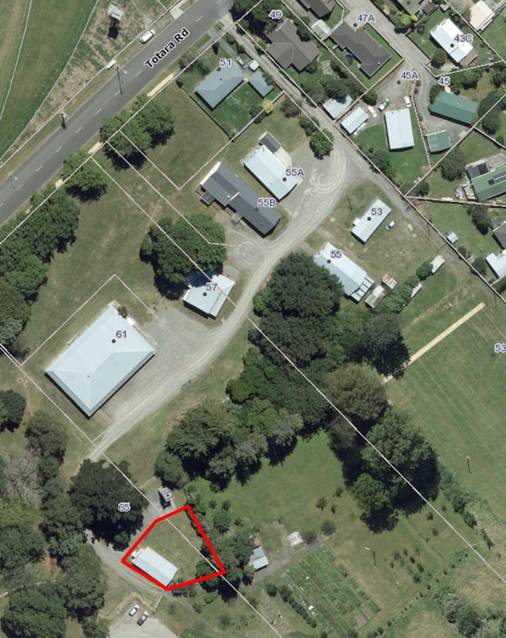
Figure 1: Proposed leased area
3. Assessment of proposal under the support and
funding policy
3.1 The
Support and Funding Policy provides a framework for how Council will deliver
support and funding to groups, organisations, and individuals to achieve the
vision of the city. One form of support within the policy is to enable
for-purpose groups to occupy Council-owned property at community rental rates.
3.2 All
for-purpose groups expressing an interest in occupying Council-owned property,
either for a new occupancy or renewal of an existing occupancy, must make an
application. The application is then assessed by Council Officers to ensure
that firstly they meet the policy’s eligibility criteria before
proceeding any further.
3.3 Further
assessment considerations are outlined in the policy. In broad terms, the
assessment covers three main areas:
· The Policy for the
Use of Public Space – guidelines relevant to the application.
· Reserves Act 1977
– this lease is not subject to the Reserves Act 1977.
· Impact
on the locality and park operations.
A copy of the assessment is attached as Attachment 1.
3.4 In
summary, following the assessment against the policy, Council Officers conclude
that the Society meets all criteria required.
4. Giving effect to the principles of the treaty
of waitangi
4.1 Rangitāne
o Manawatū representatives have considered the proposal; Rangitāne
are comfortable with this proposal and happy for it to proceed.
5. Description and analysis of options
Option 1: Notify the public of Council’s
intention to continue supporting the Amateur Radio Society by granting
occupancy via a lease under the Support and Funding Policy of the site at 65
Totara Road
5.1 This
is the preferred option.
5.2 Council
will seek feedback on continuing to support the Society through the process
outlined in the Support and Funding Policy.
5.3 After
considering feedback, Council can then decide to enter a formal lease with the
Society.
5.4 The
Society contributes to the community and shows strong alignment with
Council’s strategic direction. The Society adds to Council’s
priority to lease Council land and facilities to for-purpose organisations in
line with the Community Funding Policy.
Option 2: Do not notify the public of the
preferred option (intention to support through a lease) which would effectively
end the Amateur Radio Society’s occupancy of Council land
5.5 The
impact of this option would mean that the opportunity to seek community
feedback on the Society’s continued occupancy of the site would not
occur.
5.6 In
turn, this would mean that the lease would cease, and Council would follow the
process outlined in the Support and Funding Policy to determine the future use
of the land (refer 5.5.1(b)). The first step in this process is to carry out a
strategic options review.
5.7 The
implication of this option on the Society would mean that they would not be
able to continue leasing the site. Under the lease provisions, a decision would
then need to be made regarding the improvements owned by the Society.
5.8 This
option poses the risk that Council will be perceived as not supporting the
activities of the Society that has occupied the site since 1983.
6. conclusion
6.1 The
proposal is consistent with the requirements of the Support and Funding Policy.
Continued occupancy will allow the Society to offer its activities to radio
enthusiasts and the community.
6.2 Public
notification on the continuing support will provide opportunities for
submissions and objections to be made before a decision is made, fulfilling the
requirements of the Support and Funding Policy 2022.
6.3 It
is recommended the Committee proceed with Option 1. The Society’s
activities contribute to outcomes to achieve Goal 2 of Council’s
strategic direction.
7. Next actions
7.1 Public
notification of the intention to grant the lease, seeking submissions and
objections.
7.2 Provide
the opportunity for any submitters that wish to be heard to speak to Council.
7.3 Consider
the objections and submissions and provide to Council on whether to accept,
modify or decline the lease proposal.
8. Outline of community engagement process
8.1 The
proposed consultation process meets the public notification requirements of the
Support and Funding Policy 2022 which includes a minimum of one-month period
advertised in the Manawatu Standard, Dominion Post and on the Council website.
Compliance and administration
|
Does the Committee have
delegated authority to decide?
|
Yes
|
|
Are the decisions significant?
|
No
|
|
If they are significant do, they
affect land or a body of water?
|
No
|
|
Can this decision only be made through
a 10 Year Plan?
|
No
|
|
Does this decision require
consultation through the Special Consultative procedure?
|
No
|
|
Is there funding in the current
Annual Plan for these actions?
|
Yes
|
|
Are the recommendations
inconsistent with any of Council’s policies or plans?
|
No
|
|
The recommendations contribute
to:
Whāinga 3: He hapori
tūhonohono, he hapori haumaru
Goal 3: A connected and safe
community
|
|
The
recommendations contribute to the achievement of objectives
in:
7.
Mahere tautāwhi hapori
7. Community Support Plan
The objective is: Lease Council
land and facilities to for-purpose organisations in line with the Community
Funding Policy.
|
|
Contribution to strategic
direction and to social, economic, environmental, and cultural well-being
|
The recommendation is in line
with Council’s Support and Funding Policy which supports community
groups to deliver benefits contributing to the cultural, economic,
environmental, and social well-being of the city,
|
|
|
|
Attachments
|
1.
|
Assessment
of Lease Proposal ⇩ 
|
|
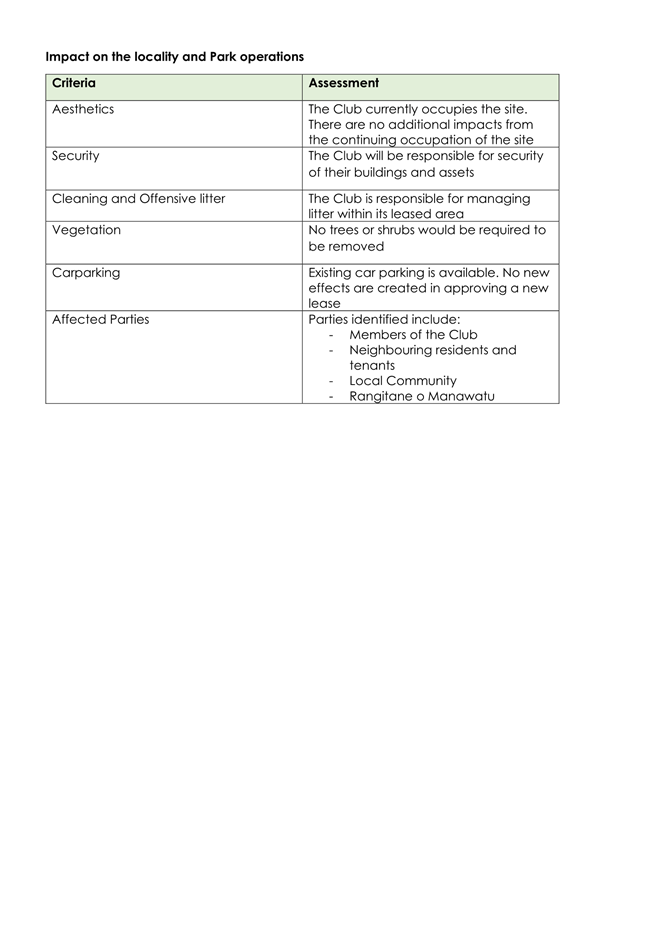
Report
TO: Strategy
& Finance Committee
MEETING DATE: 14
August 2024
TITLE: Public
Notification of a Community Occupancy Lease to Red Sox Sports Club Incorporated
PRESENTED BY: Bryce
Hosking, Manager Property and Resource Recovery and Perene Green, Property
Officer
APPROVED BY: Chris
Dyhrberg, General Manager Infrastructure
RECOMMENDATION(S)
TO Strategy & Finance
Committee
1. That the
Committee continue to support Red Sox Sports Club Incorporated by notifying the
public of its intention to grant community occupancy of Council land at 916
Tremaine Avenue (part of Vautier Park), Palmerston North in accordance with the
Support and Funding Policy 2022 and Section 54 of the Reserves Act 1977.
2. That the
Committee note the land affected by the community occupancy of Red Sox Sports
Club is described as Part Section 249 TN of Palmerston North.
Summary of options analysis for
|
Problem
or Opportunity
|
The Red Sox Sports Club has
requested support from Council by granting community occupancy through a new
lease agreement.
This report seeks Council’s
approval to commence the public notification process in accordance with the
Support and Funding Policy 2022 and Section 54 of the Reserves Act 1977.
|
|
OPTION 1:
|
Notify the public of
Council’s intention to continue supporting the Red Sox Sports Club by
granting occupancy via a lease of the existing site at 916 Tremaine Avenue
(part of Vautier Park)
|
|
Community
Views
|
· Community
views will be sought during the public notification period.
|
|
Benefits
|
· The
community views, along with any objections received, will be considered to
inform the decision.
· Council
can continue supporting and developing the relationship with the Club and
enable them to continue their activities.
|
|
Risks
|
· There
is a reputational risk where other community organisations may feel aggrieved
that they have not been given the opportunity to lease the land. This risk
can be mitigated through the transparent submission process.
|
|
Financial
|
· The
costs of public notification will be minor.
· Council
will receive the annual rent of $150.00 plus GST.
|
|
OPTION 2:
|
Do not notify the public of the preferred option (intention to
support through a lease) which would effectively end the Red Sox Sports
Club’s occupancy of Council land
|
|
Community
Views
|
· Community
views to inform the Council’s decision on the Club’s proposed
occupancy will not be sought.
|
|
Benefits
|
· Should
the lease end, and the Club be requested to vacate the premises, the Support
and Funding Policy provides a process for Council to explore alternative use
options of the land prior to potentially seeking an alternative occupant.
This allows for a strategic view of land use when an arrangement ends.
· Under
the current lease, at the expiration of the lease, Council has the option to
purchase the Club’s buildings and improvements within three months of
the date of expiration at a price agreed between both parties.
|
|
Risks
|
· There
is a reputational risk that Council may be criticised for not supporting the
activities of the Club, especially given they are established on the site.
This risk cannot be mitigated.
· There
is a further reputational risk where Council may be criticised for placing a
financial burden on the Club after asking them to vacate. If Council wishes
to proceed with this option, the Club will be required to vacate the land
and, unless agreed otherwise, remove all assets, and return the land to its
original state at their cost. Whilst this is set out in the lease conditions,
that will not mitigate the reputational risk caused from perception.
|
|
Financial
|
· Council
would no longer receive the existing annual rent of $150.00 plus GST.
· Council
staff time would be required to assist in the process of the removal of
improvements.
|
Rationale for the recommendations
1. Overview of the problem or opportunity
1.1 The
Red Sox Sports Club has been occupying Council land at 916 Tremaine Avenue
since 1999. Their previous lease expired in 2019 and the Club requests a new
lease so it can continue to occupy the site. Since the Club has occupied
Council land, the Club have developed the site to provide opportunities for
participation in sports and social activities for the community.
1.2 Council
only leases the land to the Club. The Club owns all improvements within the
lease area.
1.3 Under
the Council’s Support and Funding Policy, if a for-purpose organisation
requests a new lease for the occupancy of Council land at the end of their
agreed term, the proposal is to be publicly advertised to seek feedback from
the public.
1.4 In
addition, as the leased land is reserve land, any new lease is also subject to
the requirements of the Reserves Act 1977, which also requires public
notification of Council’s intention to grant a new lease.
1.5 This
report seeks Council’s approval to commence the public notification process
in accordance with the Reserves Act 1977 and the Support and Funding Policy,
noting that this is the first step in the process, and only seeks approval for
consultation.
1.6 The
final decision to lease to the Club will be brought to the Strategy & Finance
Committee in a subsequent report which will discuss any feedback received.
2. the proposal
2.1 The
proposed lease area is approximately 1,868m2. The proposed lease
area is outlined in Figure 1.
2.2 If
the land lease is granted the proposed annual rental is $150.00 plus GST. This
is consistent with the framework in Council’s Support and Funding Policy.
2.3 The
proposed term would be for five (5) years, with one right of renewal for a
further five (5) years.
2.4 If
a new lease is commenced, the use of the site will remain the same.

Figure 1: Proposed leased area
2.5 The
proposed 10-year term structure, made up of two 5-year terms, is consistent
with the standard lease terms entered on Council land. This tenure has been
discussed with, and agreed to, by the proposed tenant. If Council wishes to
grant a longer term, then direction will need to be given to do so.
3. assessment of proposal under the support and
FUNDING policy
3.1 The
Support and Funding Policy provides a framework for how Council will deliver
support and funding to groups, organisations, and individuals to achieve the
vision of the city. One form of support within the policy is to enable
for-purpose groups to occupy Council-owned property at community rental rates.
3.2 All
for-purpose groups expressing an interest in occupying Council-owned property,
either for a new occupancy or renewal of an existing occupancy, must make an
application. The application is then assessed by Council Officers to ensure
that firstly they meet the policy’s eligibility criteria before
proceeding any further.
3.3 Further
assessment considerations are outlined in the policy. In broad terms, the
assessment covers three main areas:
· The Policy for the
Use of Public Space – guidelines relevant to the application.
· Reserves Act 1977
– including consideration of the values and purpose of the reserve and
the impacts on the public use of the reserve.
· Impact
on the locality and park operations.
A copy of the assessment is attached as Attachment 1.
3.4 In
summary, following the assessment against the policy, Council Officers conclude
that the Club meets all criteria required.
4. leasing powers under the reserves act
4.1 In
addition to the Support and Funding Policy requirements, as the land is a reserve
held under the Reserves Act 1977, the leasing provisions also apply.
4.2 Section
54(1)(b) of the Reserves Act 1977 allows for an administering body to:
‘lease to any voluntary organisation part of the
reserve for the erection of stands, pavilions, gymnasiums, and, subject to
sections 44 and 45, other buildings and structures associated with and
necessary for the use of the reserve for outdoor sports, games, or other
recreational activities, … which lease shall be subject to the further
provisions set out in Schedule 1 relating to leases of recreation reserves
issued pursuant to this paragraph:
provided
that a lease granted by the administering body may, with the
prior consent of the Minister given on the ground that he or she considers
it to be in the public interest, permit the erection of buildings and
structures for sports, games, or public recreation not directly associated
with outdoor recreation.’
4.3 ‘Necessary’
is not interpreted as requiring that all or even most visitors or users of the
reserve need/want to use the service or activity provided under the
lease. Reserves often have activities on them that only some of the
visitors to the reserve use. The balance of the reserve, Vautier Park, is
available for general use by the community.
4.4 The
proposal would see the continued use of part of the reserve by the Club.
The lease does not alter the current user experience or change the existing
capacity for other activities.
5. land status
5.1 A
summary of the land status information is:
|
Title
|
Reserve Status
|
Officer Comment
|
|
Part
Section 249 TN of Palmerston North
|
Recreation
Reserve
|
Subject
to the Reserves Act 1977
|
6. giving effect to the principles of the treaty
of waitangi
6.1 The
Reserves Act 1977 is subject to Section 4 of the Conservation Act and requires
that administering bodies under the Reserves Act 1977 give effect to the
principles of the Treaty of Waitangi.
6.2 Rangitāne
o Manawatū representatives have considered the proposal, Rangitāne
are comfortable with this proposal and happy for it to proceed.
7. Description of options
Option 1: Notify the public of Council’s
intention to continue supporting the Club by granting occupancy via a lease of
the existing site at 916 Tremaine Avenue (part of Vautier Park)
7.1 This
is the preferred option.
7.2 Council
will seek feedback on continuing to support the Club through the process
outlined in the Support and Funding Policy.
7.3 Council
must give people the opportunity to submit on the proposal and be heard before
deciding to grant a lease as per sections 119 and 120 of the Reserves Act 1977.
7.4 After
considering feedback, Council can then decide to enter a formal lease with the
Club.
7.5 The
Club contributes to the community and shows strong alignment with
Council’s strategic direction. The Club adds to Council’s priority
to ensure the use of all community recreation facilities is optimised.
Option 2: Do not notify the public of the
preferred option (intention to support through a lease) which would effectively
end the Club’s occupancy of Council land
7.6
The impact of this option would mean that the opportunity to seek community
feedback on the Club’s continued occupancy of the site would not occur.
7.7 In
turn, this would mean that the lease would cease, and Council would follow the
process outlined in the Support and Funding Policy to determine the future use
of the land (refer 5.5.1(b)). The first step in this process is to carry out a
strategic options review.
7.8 The
implication of this option on the Club would mean that they would not be able
to continue leasing the site. Under the lease provisions, a decision would then
need to be made regarding the improvements owned by the Club.
7.9 This
option poses the risk that Council will be perceived as not supporting the
activities of the Club that has occupied the site since 1999.
8. Conclusion
8.1 The
proposal is consistent with the requirements of the Support and Funding Policy.
Continued occupancy will allow the Club to offer its activities to the
community.
8.2 Public
notification on the continuing support will provide opportunities for submissions
and objections to be made before a decision is made, fulfilling the
requirements of the Support and Funding Policy 2022 and section 54 of the
Reserves Act 1977.
8.3 It
is recommended the Committee proceed with Option 1. The Club’s activities
contribute to outcomes to achieve Goal 3 of Council’s strategic
direction.
9. Next actions
9.1 Public
notification of the intention to grant the lease, seeking submissions and
objections.
9.2 Provide
the opportunity for any submitters that wish to be heard to speak to Council.
9.3 Consider
the objections and submissions and provide to Council on whether to accept,
modify or decline the lease proposal.
10. Outline of community engagement process
10.1 The
proposed consultation process meets the public notification requirements of the
Support and Funding Policy 2022 and the Reserves Act 1977 that requires a
minimum of one-month period advertised in the Manawatū Standard, Dominion
Post and on the Council website.
Compliance and administration
|
Does the Committee have
delegated authority to decide?
|
Yes
|
|
Are the decisions significant?
|
No
|
|
If they are significant do, they
affect land or a body of water?
|
No
|
|
Can this decision only be made
through a 10 Year Plan?
|
No
|
|
Does this decision require
consultation through the Special Consultative procedure?
|
No
|
|
Is there funding in the current
Annual Plan for these actions?
|
Yes
|
|
Are the recommendations
inconsistent with any of Council’s policies or plans?
|
No
|
|
The recommendations contribute
to:
Whāinga 3: He hapori
tūhonohono, he hapori haumaru
Goal 3: A connected and safe
community
|
|
The
recommendations contribute to the achievement of objectives
in:
6.
Mahere rēhia
6. Recreation and Play
Plan
The objective is: Administer the
Reserves Act 1977.
|
|
Contribution to strategic
direction and to social, economic, environmental, and cultural well-being
|
The recommendation is in line
with Council’s Support and Funding Policy which supports community
groups to deliver benefits contributing to the cultural, economic,
environmental, and social wellbeing of the city.
|
|
|
|
Attachments
|
1.
|
Assessment
of Lease Proposal ⇩ 
|
|

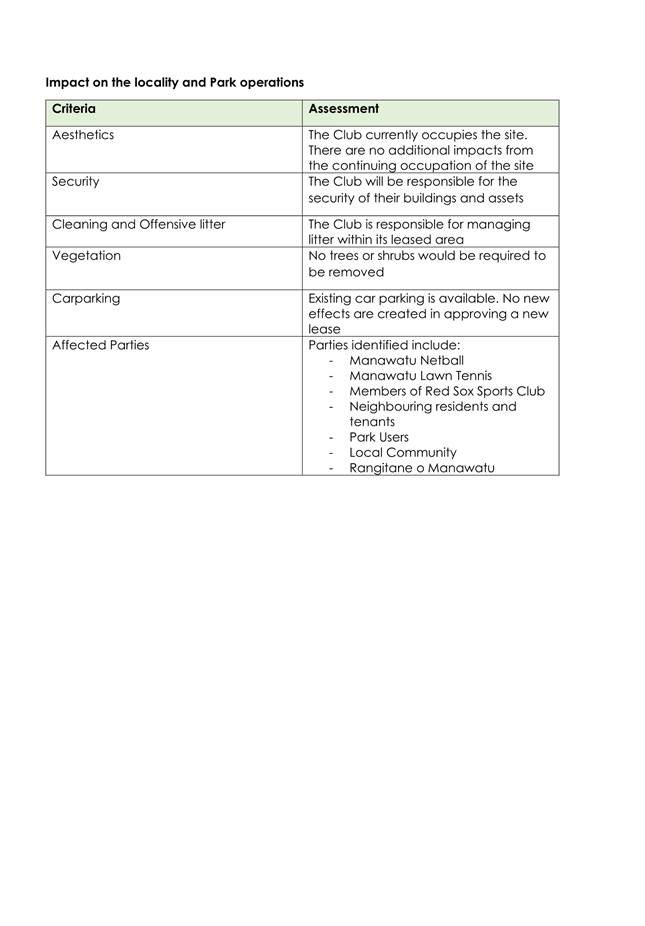
Memorandum
TO: Strategy
& Finance Committee
MEETING DATE: 14
August 2024
TITLE: Ongley
Park - Proposal to grant a lease on Council land to Rose Gardens Croquet Club
Incorporated
Presented
By: Bryce
Hosking, Manager Property and Resource Recovery and Perene Green, Property
Officer
APPROVED BY: Chris
Dyhrberg, General Manager Infrastructure
RECOMMENDATION(S)
TO Strategy & Finance
Committee
1. That the
Committee grant a lease of the land at Ongley Park, Palmerston North as part of
Lot 2 DP 77988 to Rose Gardens Croquet Club Incorporated in accordance with the
Support and Funding Policy 2022.
1. ISSUE
1.1 The
Club has operated at Ongley Park since 1983. The formal land lease expired in September
2023 and has been on a month-to-month lease since.
1.2 The
Club requests a new lease to continue operating. The lease is subject to the
requirements of the Support and Funding Policy 2022, which includes public
notification of Council’s intention to grant a new lease on the
reserve.
1.3 The
public notification process is now complete with no submissions received.
1.4 This
report seeks approval to grant a new lease to Rose Gardens Croquet Club
Incorporated in accordance with Council’s Support and Funding Policy.
2. BACKGROUND
2.1 A
report to the Strategy & Finance Committee on 8 May 2024 assessed the
proposal and as a result Council resolved:
1. That Council
continues to support Rose Gardens Croquet Club Incorporated by notifying the
public of its intention to grant community occupancy of Council land at Ongley
Park, Palmerston North in accordance with the Support and Funding Policy 2022.
2. That Council notes
the land affected by the community occupancy of Rose Gardens Croquet Club
Incorporated is described as Lot 2 DP 77988.
2.2 Consultation
was completed in June 2024. No submissions were received.
2.3 The
proposed lease will commence on 1 September 2024 and will be for a term of five
(5) years with one right of renewal of a further five (5) years.
2.4 The proposed 10-year term structure, made up of two 5-year terms, is
consistent with the standard lease terms entered on Council land. This tenure
has been discussed with, and agreed to, by the proposed tenant. If Council
wishes to grant a longer term, then direction will need to be given to do so.
2.5 The
proposed annual rent is $250.00 plus GST. This is consistent with the rental
framework in Council's Support and Funding Policy 2022.
3. Conclusion
3.1 Council
has supported Rose Gardens Croquet Club Incorporated through leasing land since
1983.
3.2 Given
there were no objections to the new lease proposal, and the requirements of the
Support and Funding Policy have been met, it is recommended that Council
continue to support them and proceed with granting a new lease to Rose Gardens
Croquet Club Incorporated.
4. NEXT
STEPS
4.1 A
new lease between Palmerston North City Council and Rose Gardens Croquet Club
Incorporated will be entered.
5. Compliance
and administration
|
Does the Committee have
delegated authority to decide?
|
Yes
|
|
Are the decisions significant?
|
No
|
|
If they are significant do, they
affect land or a body of water?
|
No
|
|
Can this decision only be made
through a 10 Year Plan?
|
No
|
|
Does this decision require
consultation through the Special Consultative procedure?
|
No
|
|
Is there funding in the current
Annual Plan for these actions?
|
Yes
|
|
Are the recommendations
inconsistent with any of Council’s policies or plans?
|
No
|
|
The recommendations contribute
to:
Whāinga 3: He hapori
tūhonohono, he hapori haumaru
Goal 3: A connected and safe
community
|
|
The
recommendations contribute to the achievement of objectives
in:
7.
Mahere tautāwhi hapori
7. Community Support Plan
The objective is: Grant a lease
of Council land and facilities to for-purpose organisations in line with the
Community Funding Policy.
|
|
Contribution to strategic
direction and to social, economic, environmental, and cultural well-being
|
The lease aligns with
Council’s Support and Funding Policy which supports community groups to
deliver benefits contributing to the cultural and economic, environmental,
and social wellbeing in the city.
|
|
|
|
Attachments
Nil
Memorandum
TO: Strategy
& Finance Committee
MEETING DATE: 14
August 2024
TITLE: Ongley
Park - Proposal to grant a lease on Council land to Manawatu Cricket
Incorporated
Presented
By: Bryce
Hosking, Manager Property and Resource Recovery and Perene Green, Property
Officer
APPROVED BY: Chris
Dyhrberg, General Manager Infrastructure
RECOMMENDATION(S)
TO Strategy & Finance
Committee
1. That the
Committee grant a lease of the land and part building at Ongley Park,
Palmerston North as part of Section 248 Town of Palmerston North,
WN16B/1168 to Manawatū Cricket Incorporated, in accordance with
Council’s Support and Funding Policy and Section 54 of the Reserves Act
1977.
1. ISSUE
1.1 Manawatū
Cricket Incorporated has operated at Ongley Park, Palmerston North since 2013.
1.2 The
formal land and building lease with Manawatū Cricket expired on 30 June
2022 and has been on a month-to-month lease since then.
1.3 Manawatū
Cricket Incorporated requested a new lease to continue operating. The lease is
over reserve land and is subject to the requirements of the Reserves Act 1977
in addition to Council’s Support and Funding Policy 2022. These
requirements include public notification of Council's intention to grant a new
lease on the reserve.
1.4 The
public notification process is now complete with no submissions having been
received.
1.5 This
report seeks approval to grant a new lease to Manawatū Cricket
Incorporated in accordance with Section 54 of the Reserves Act 1977 and
Council’s Support and Funding Policy
2. BACKGROUND
2.1 A
report to the Strategy & Finance Committee on 8 May 2024 assessed the
proposal and as a result Council resolved:
1. That Council
continues to support Manawatū Cricket Incorporated by notifying the public
of its intention to grant community occupancy of Council land at Ongley Park,
Palmerston North in accordance with the Support and Funding Policy 2022 and
Section 54 of the Reserves Act 1977.
2. That Council notes
the land affected by the community occupancy of Manawatū Cricket
Incorporated is described as Part Section 248 Town of Palmerston North
WN16B/1168.
2.2 Consultation
was completed in July 2024. No submissions were received.
2.3 If
entered the proposed lease will commence on 1 July 2024 and will be for a term
of five (5) years with one right of renewal of a further five (5) years.
2.4 The
proposed 10-year term structure, made up of two 5-year terms, is consistent with
the standard lease terms entered on Council land. This tenure has been
discussed with, and agreed to, by the proposed tenant. If Council wishes to
grant a longer term, then direction will need to be given to do so.
2.5 The
proposed annual rent is to be $1,000 plus GST. This is consistent with the
rental framework in Council’s Support and Funding Policy 2022.
3. Conclusion
3.1 Council
has supported Manawatū Cricket Incorporated through leasing land and
buildings since 2013.
3.2 Given
there were no objections to the new lease proposal, and the requirements of the
Support and Funding Policy have been met, it is recommended that Council
continue to support them and proceed with granting a new lease to Manawatū
Cricket Incorporated.
4. NEXT
STEPS
4.1 A
new lease between Palmerton North City Council and Manawatū Cricket
Incorporated is executed.
5. Compliance
and administration
|
Does the Committee have
delegated authority to decide?
|
Yes
|
|
Are the decisions significant?
|
No
|
|
If they are significant do, they
affect land or a body of water?
|
No
|
|
Can this decision only be made
through a 10 Year Plan?
|
No
|
|
Does this decision require
consultation through the Special Consultative procedure?
|
No
|
|
Is there funding in the current
Annual Plan for these actions?
|
Yes
|
|
Are the recommendations
inconsistent with any of Council’s policies or plans?
|
No
|
|
The recommendations contribute
to:
Whāinga 3: He hapori
tūhonohono, he hapori haumaru
Goal 3: A connected and safe
community
|
|
The
recommendations contribute to the achievement of objectives
in:
7.
Mahere tautāwhi hapori
7. Community Support Plan
The objective is: Grant a lease
of Council land and facilities to for-purpose organisations in line with the
Community Funding Policy.
|
|
Contribution to strategic
direction and to social, economic, environmental, and cultural well-being
|
The recommendation is in line
with Council’s Support and Funding Policy which supports community
groups to deliver benefits contributing to the cultural economic,
environmental, and social wellbeing of the city.
|
|
|
|
Attachments
Nil
Committee Work Schedule
TO: Strategy
& Finance Committee
MEETING DATE: 14
August 2024
TITLE: Committee
Work Schedule
FROM:
RECOMMENDATION TO Strategy & Finance Committee
1. That the
Strategy & Finance Committee receive its Work Schedule dated August 2024.
|
COMMITTEE WORK SCHEDULE – AUGUST 2024
|
|
Item No.
|
Estimated Report Date
|
Subject
|
Officer Responsible
|
Current Position
|
Date of Instruction/
Clause number
|
|
1.
|
August 2024
|
Quarterly Performance & Financial Report (quarter 4
ending 30 June 2024)
|
General Manager Corporate Services /
CFO
|
|
Terms of Reference
|
|
2.
|
August 2024
|
Treasury Report (Quarter 4)
|
General Manager Corporate Services /
CFO
|
|
Treasury Policy
|
|
3.
|
August November 2024
|
Options to transition
out of small vehicle fleet ownership and long-term lease, with a view to
utilisation of a carshare or similar services Financial Year 2027 onwards
|
General Manager
Strategic Planning
General Manager
Infrastructure Services
|
Initial
assessment complete; further financial analysis required
|
Council
29 November 2023
Clause 193.3-23
|
|
4.
|
August November 2024
|
Draft Waste Management
and Minimisation Bylaw – Approval for Consultation
|
General Manager
Strategic Planning
|
In
progress; further work to do on key areas where changes will be recommended
|
11 August 2021
Clause 21
|
|
5.
|
November 2024
|
Quarterly Performance
& Financial Report (quarter 1 ending 30 September 2024)
|
General Manager
Corporate Services /
CFO
|
|
Terms of Reference
|
|
6.
|
November 2024
|
Treasury Report (Quarter
1)
|
General Manager
Corporate Services /
CFO
|
|
Treasury Policy
|
|
7.
|
November 2024
|
Vegetation Framework to
include a Tree Policy focused on Council administered streets and public
spaces
|
General Manager
Strategic Planning
|
|
Committee of Council
9 June 2021
Clause 31.8
|
|
8.
|
November
2024
|
Te
Apiti Ashhurst Loop Track - negotiations and Recreation Fund application
|
General
Manager Infrastructure
|
|
8
May 2024
Clause
32
|
|
9.
|
May/June
2025
|
Engage with the community around the option of designating
part of Linklater Park as dog-on-lead, and report back
|
General
Manager Strategic Planning
|
|
8
May 2024
Clause
26
|
|
10.
|
TBC
|
Nature
Calls - Prospective funding and finance options
|
General
Manager Corporate Services/
CFO
|
|
Council
10
June 2024
Clause 111-24
|
|
11.
|
TBC
|
Delegation
Manual – Fees & Charges review
|
General
Manager Corporate Services /
CFO
|
|
8
May 2024
Clause
24
|
|
12.
|
TBC
|
Revenue
& Finance Policy review
|
TBC
|
|
8
May 2024
Clause
24
|
|
13.
|
TBC
|
Contact
Centre – Breakdown of expenses
|
General
Manager Corporate Services
|
|
Council
3
April 2024 Clause 52-24
|
|
14.
|
TBC
|
Draft Interim Speed
Management Plan
|
General Manager
Strategic Planning
|
Waiting on government
direction
|
Council
5 April 2023
Clause 46-23
|
Attachments
NIL
































